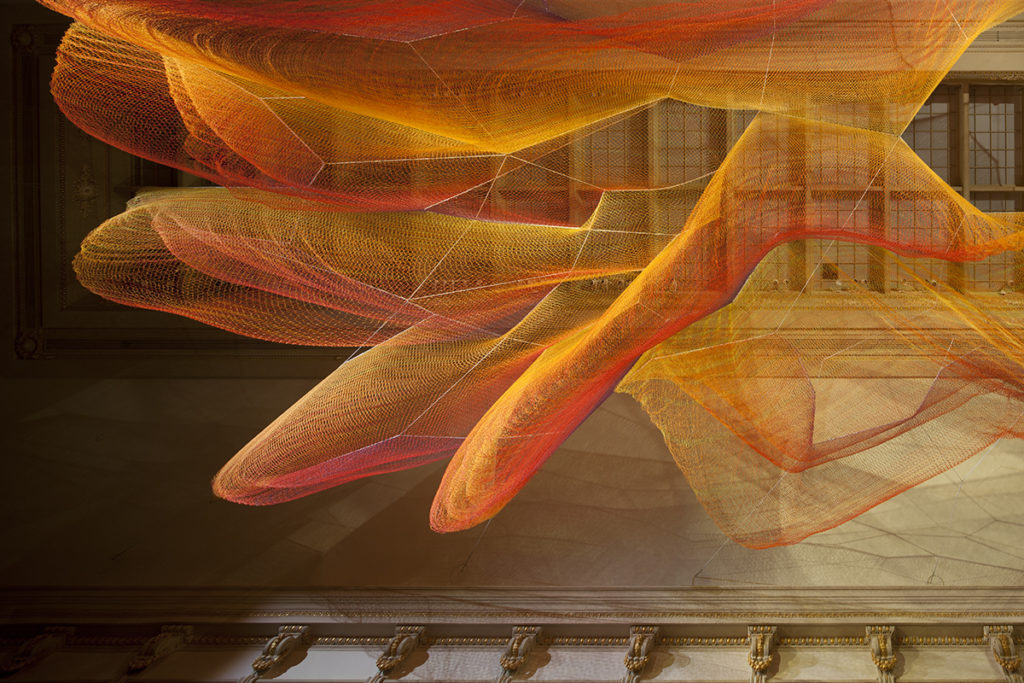Galleries
Every issue includes artwork selected by the office of Cultural Programs at the National Academy of Sciences (CPNAS). Artists included in the pages of the magazine grapple with many of the same topics discussed by our authors—climate change, big data, genetics, and surveillance, to name a few—in thoughtful, visually compelling ways.
Summer 2024: Humanizing Energy Futures
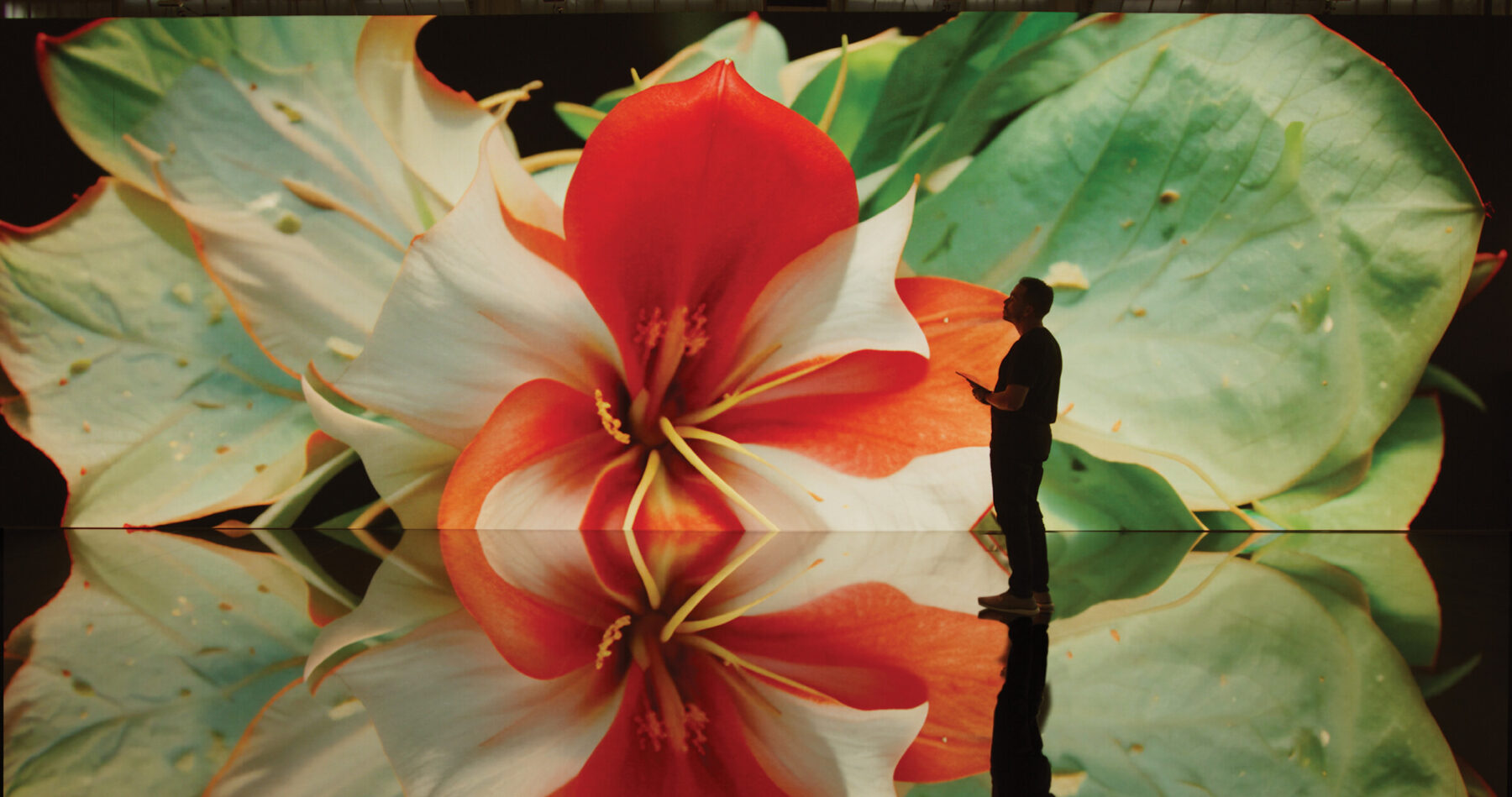
What Can Artificial Intelligence Learn From Nature?
Living Archive: Nature showcases the output from the Large Nature Model (LNM) by Refik Anadol Studio. Refik Anadol Studio in Los Angeles maintains a research practice centered around discovering and developing novel approaches to data narratives and machine intelligence. View GallerySpring 2024: Aristotle on the Moon
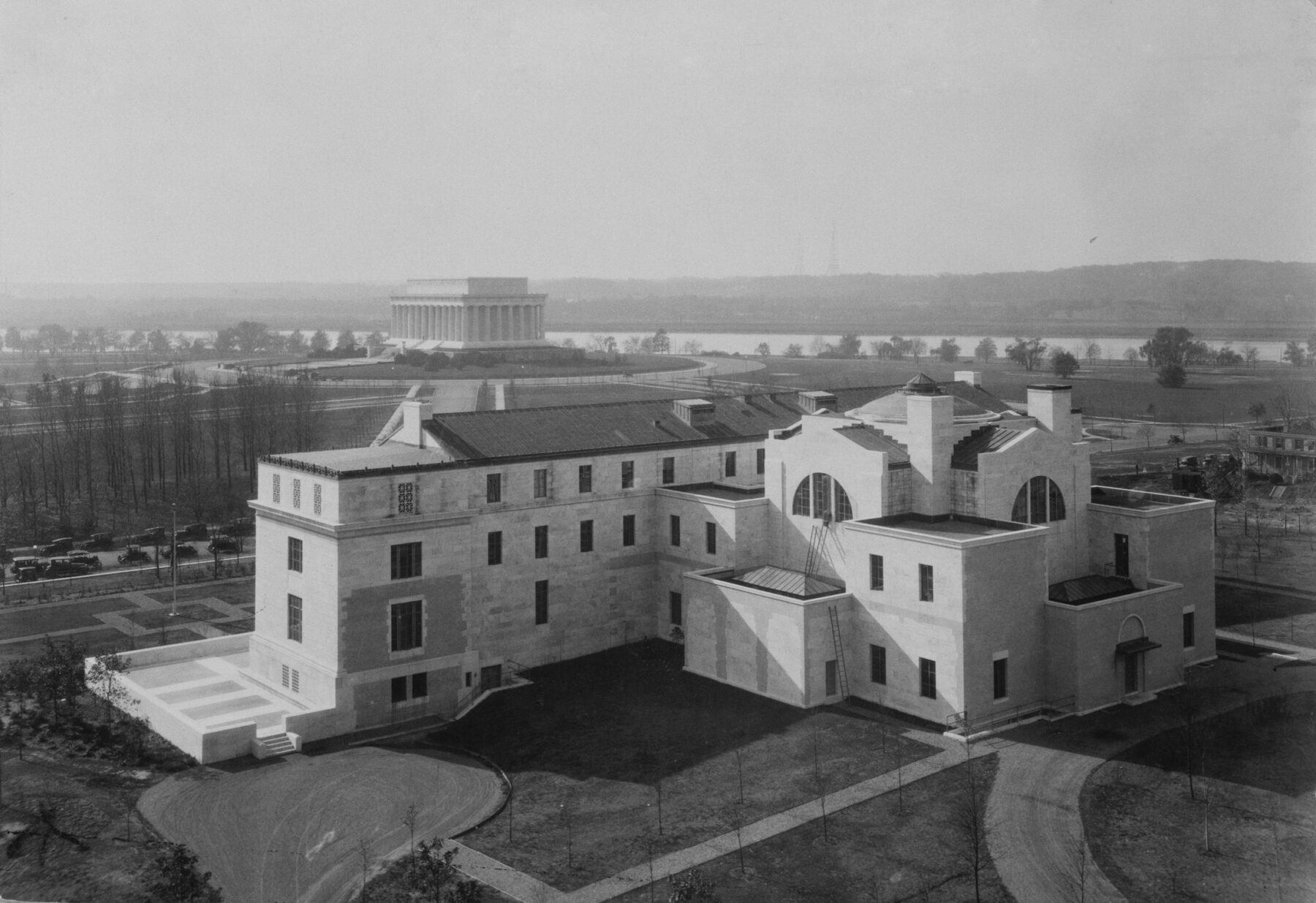
Celebrating the Centennial of the National Academy of Sciences Building
This is a special year for the National Academy of Sciences (NAS) as its beautiful headquarters at 2101 Constitution Avenue, NW, in Washington, DC, turns 100 years old. Dedicated by President Calvin Coolidge in April 1924 and designed by architect Bertram Grosvenor Goodhue, the building’s architecture synthesizes classical elements with Goodhue’s preference for “irregular” forms. View Gallery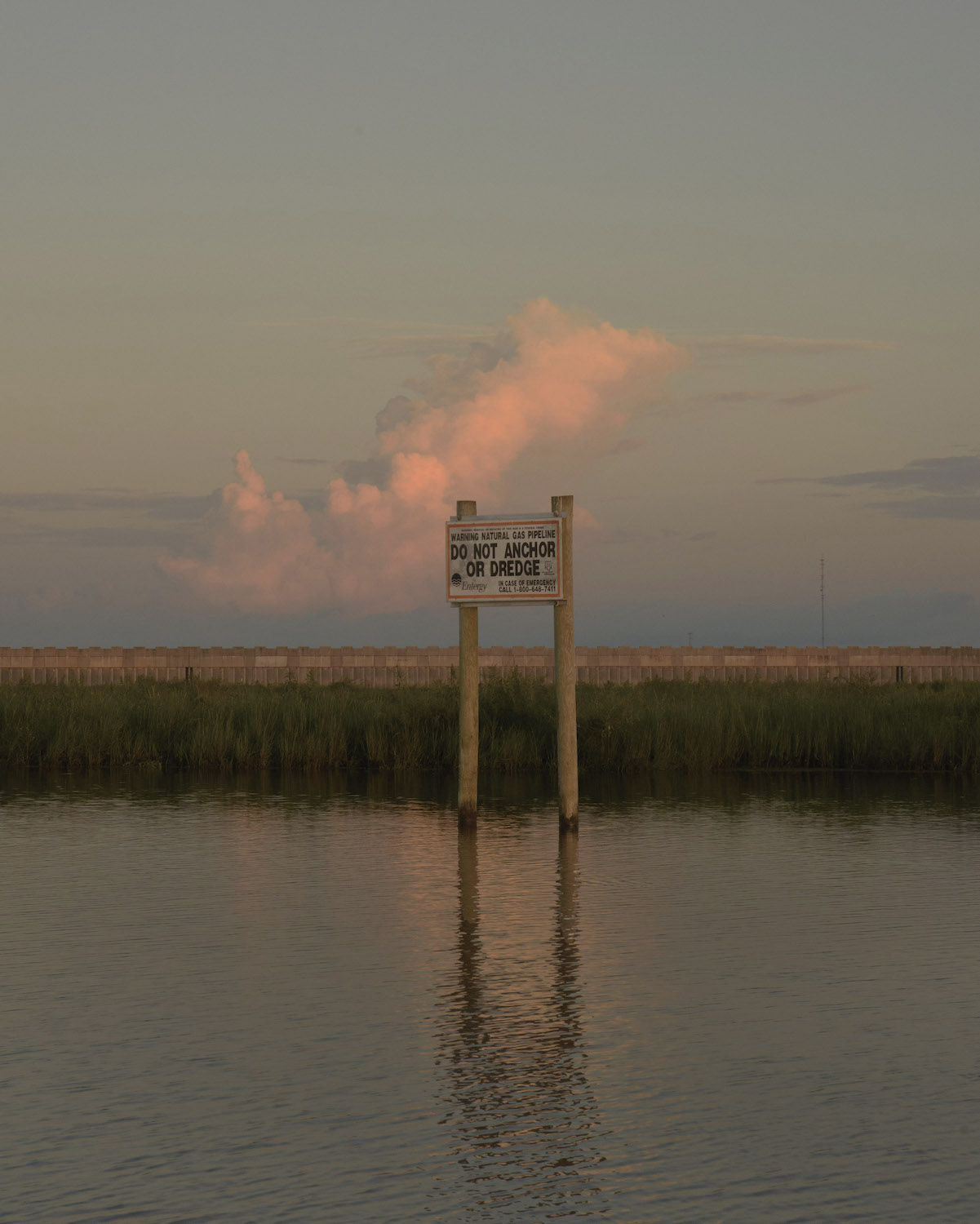
An Elusive and Indefinable Boundary
Seven years before the release of Silent Spring in 1962, marine biologist and writer Rachel Carson wrote The Edge of the Sea. Part field guide to the Atlantic seashore, part meditation on Carson’s love for the evanescent world between land and water, it was an idea that came to her while working for the United States Fish and Wildlife Service. View Gallery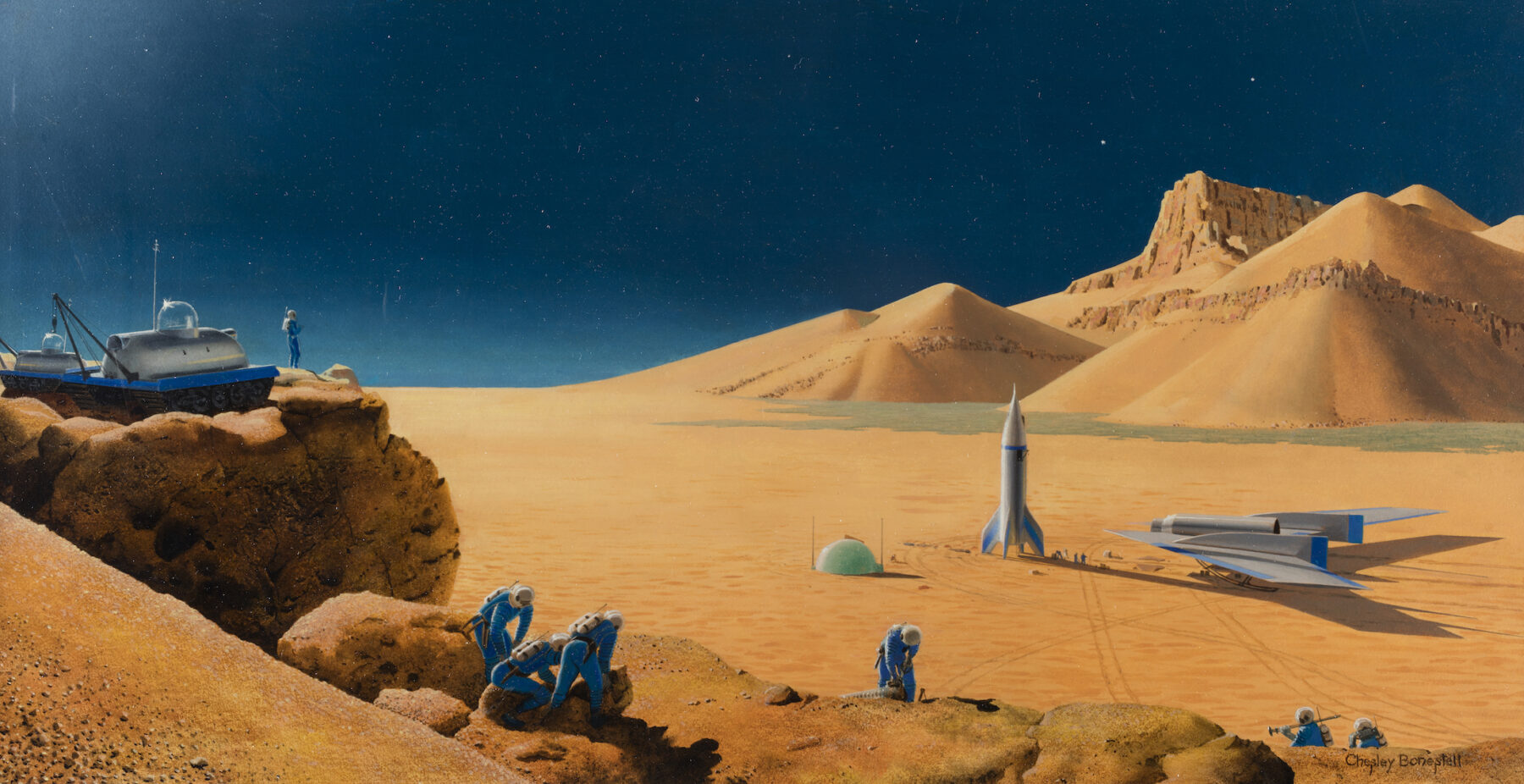
How Space Art Shaped National Identity
Space exploration became firmly interwoven with American culture through influential speeches by President John F. Kennedy at a time of heightened awareness of the “space race” between the United States and the Soviet Union. View Gallery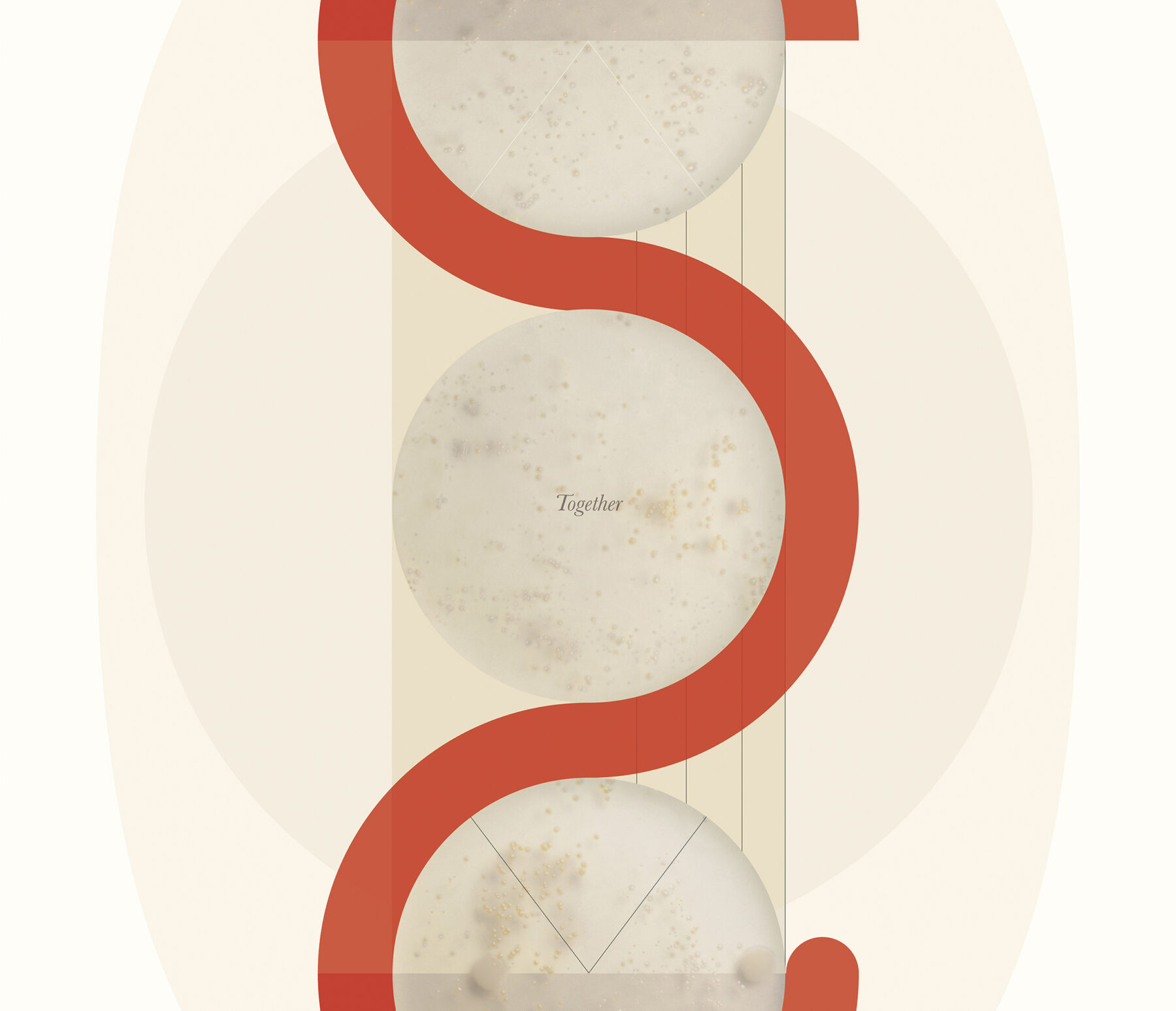
In Fragments No Longer
Julia Pollack, In Fragments No Longer: Cari Vanderpool and Julia Pollack, 2023, inkjet print, 24 x 36 inches. Julia Pollack, In Fragments No Longer: Cari Vanderpool and Julia Pollack 2, 2023, inkjet print, 24 x 36 inches. View GalleryWinter 2024: Deepening Engagement
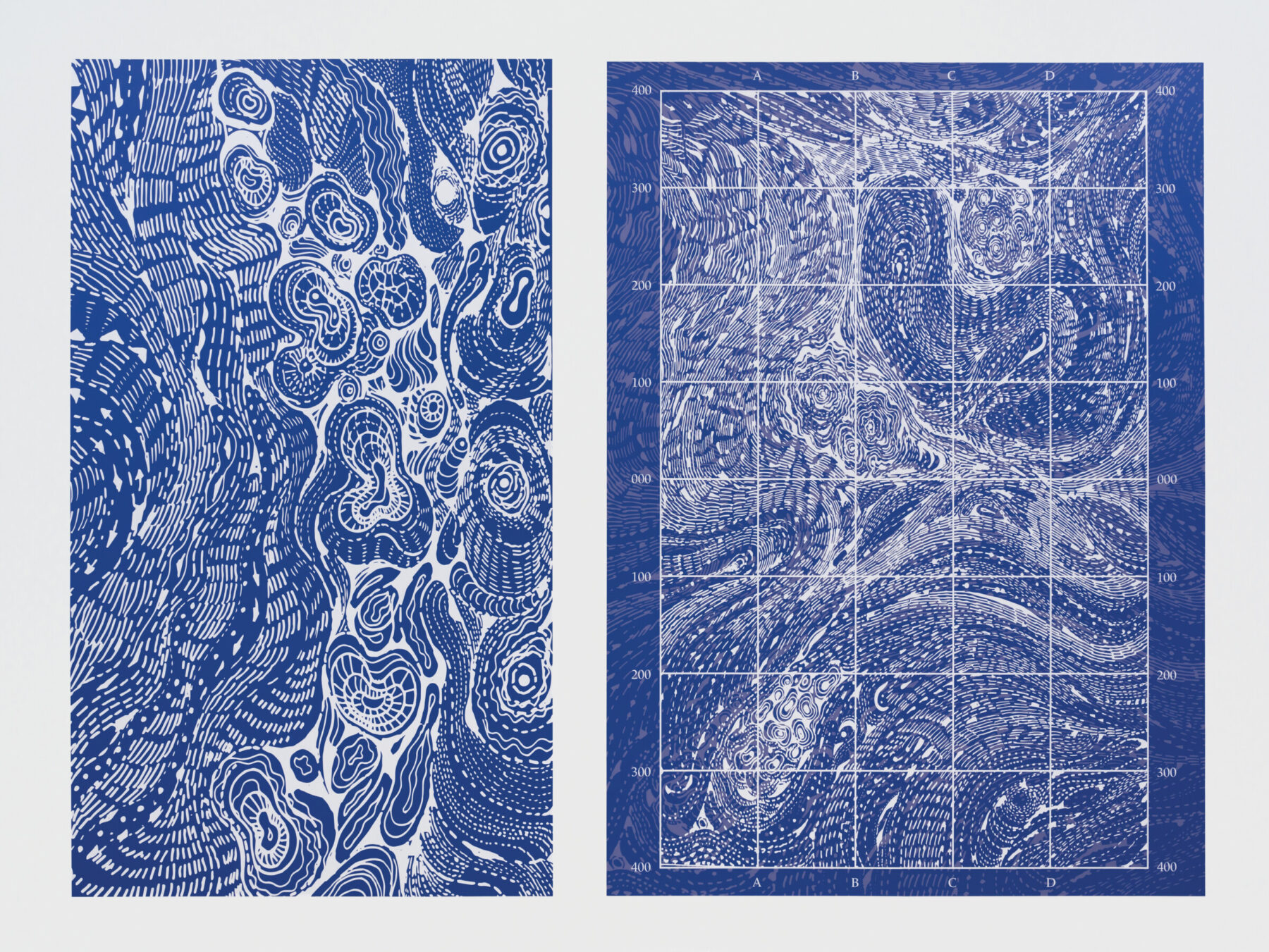
FLOE: A Climate of Risk
STEPHEN TALASNIK, Glacial Mapping 2023; Digitally printed vinyl wall print, 10’ x 14’ (h x w) Imagination can be a fundamental tool for driving change. Through creative narratives, we can individually and collectively imagine a better future and, potentially, take actions to move toward it. View Gallery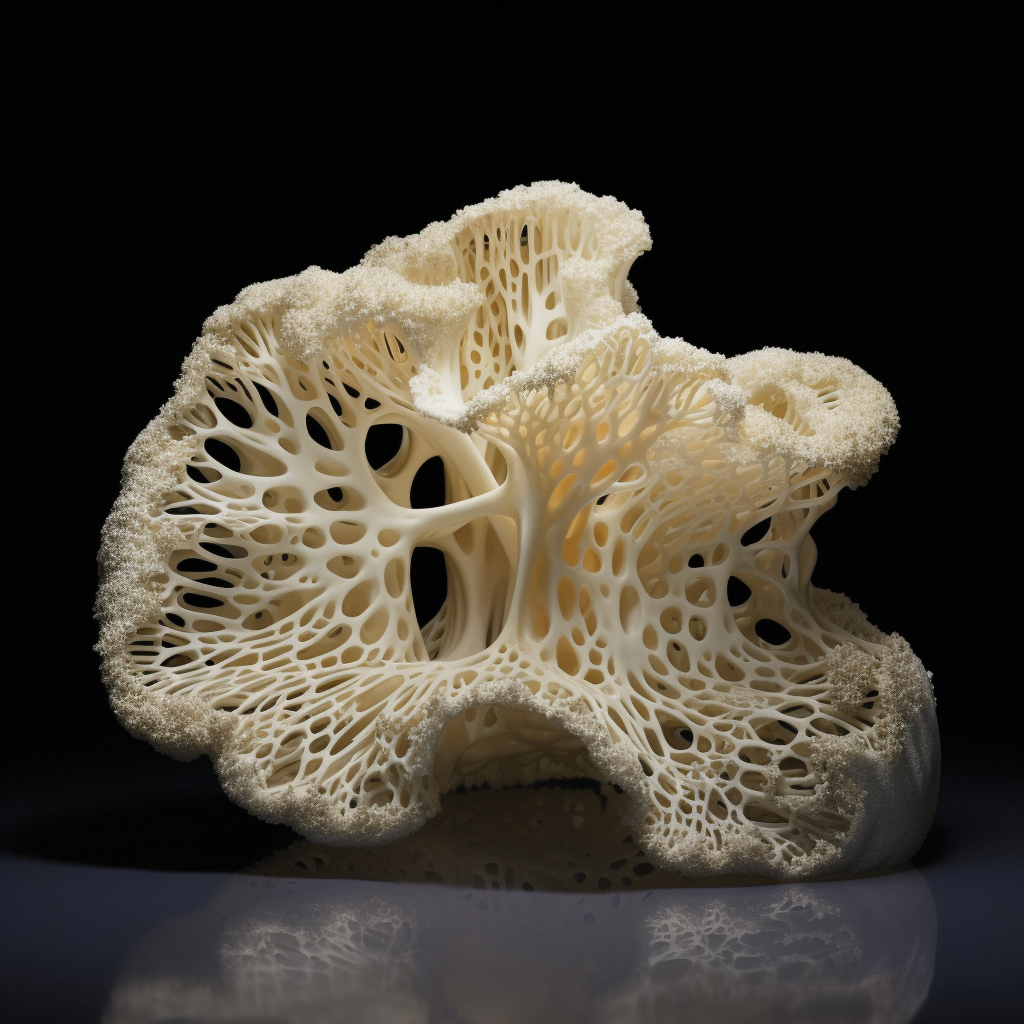
AI-Assisted Biodesign
AMY KARLE, BioAI Mycelium Grown Into the Form of Insulators, 2023 Amy Karle is a contemporary artist who uses artificial intelligence as both a medium and a subject in her work. View Gallery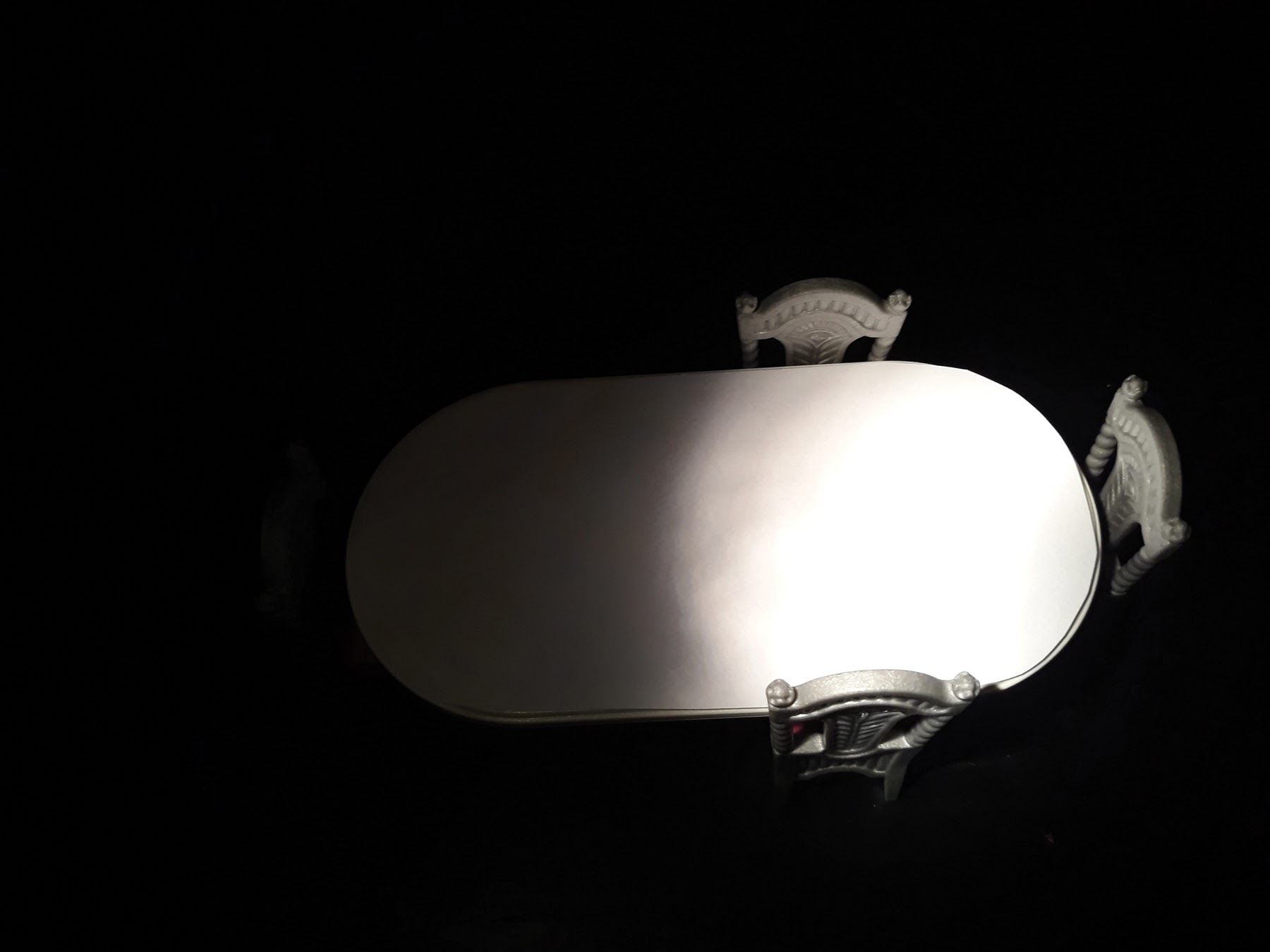
Native Voices in STEM
Circular Tables, 2022, digital photograph, 11 X 14 inches. “Many of the research meetings I have participated in take place at long rectangular tables where the power and primary conversation participants are at one end. View Gallery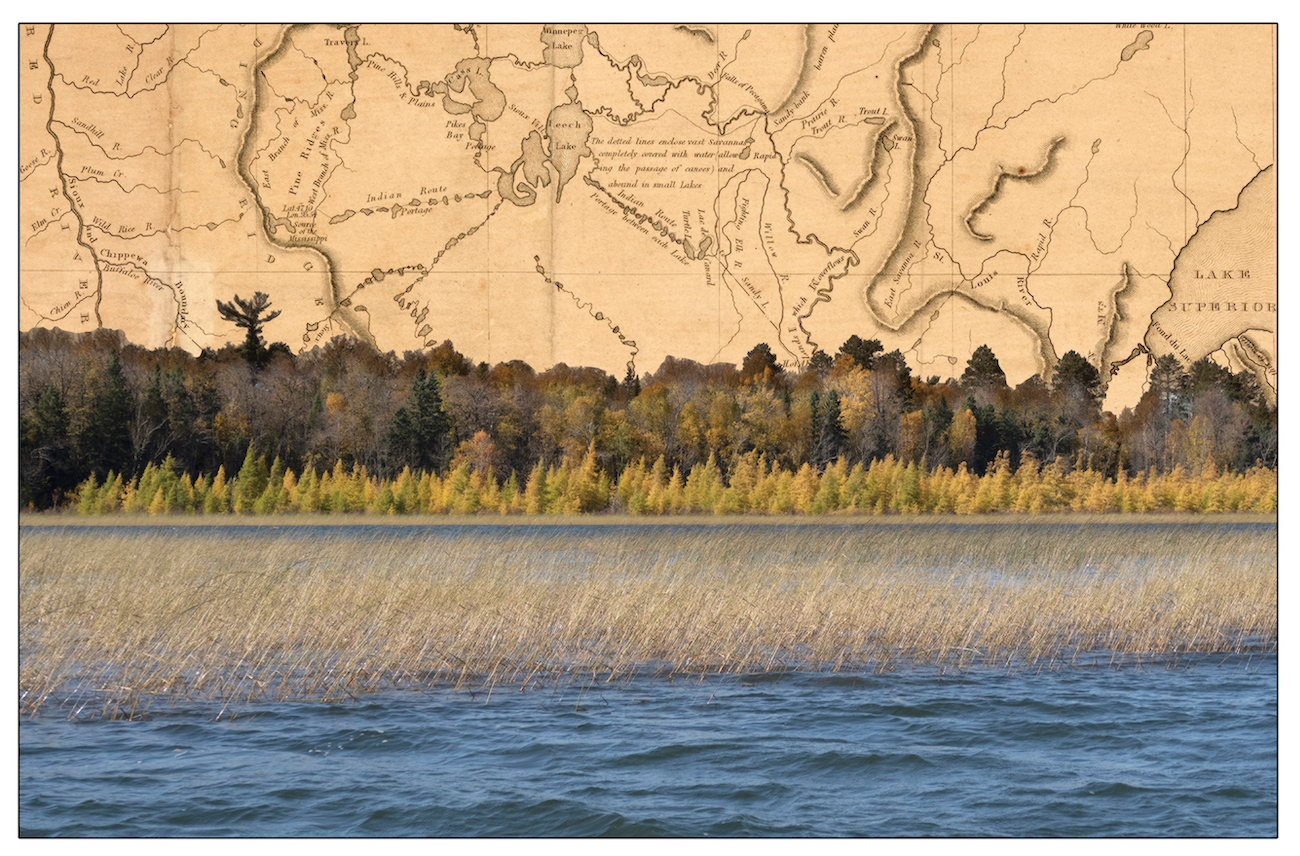
In the Heart of the Yakni Chitto
Monique Verdin began documenting the lives of her relatives in the Mississippi delta in 1998, when she was 19. That year, her grandmother Armantine Marie Billiot Verdin and other Houma elders traveled by boat to the point of land in the heart of the Yakni Chitto (Big Country) where they were born. View GalleryFall 2023: 40 Years of Issues
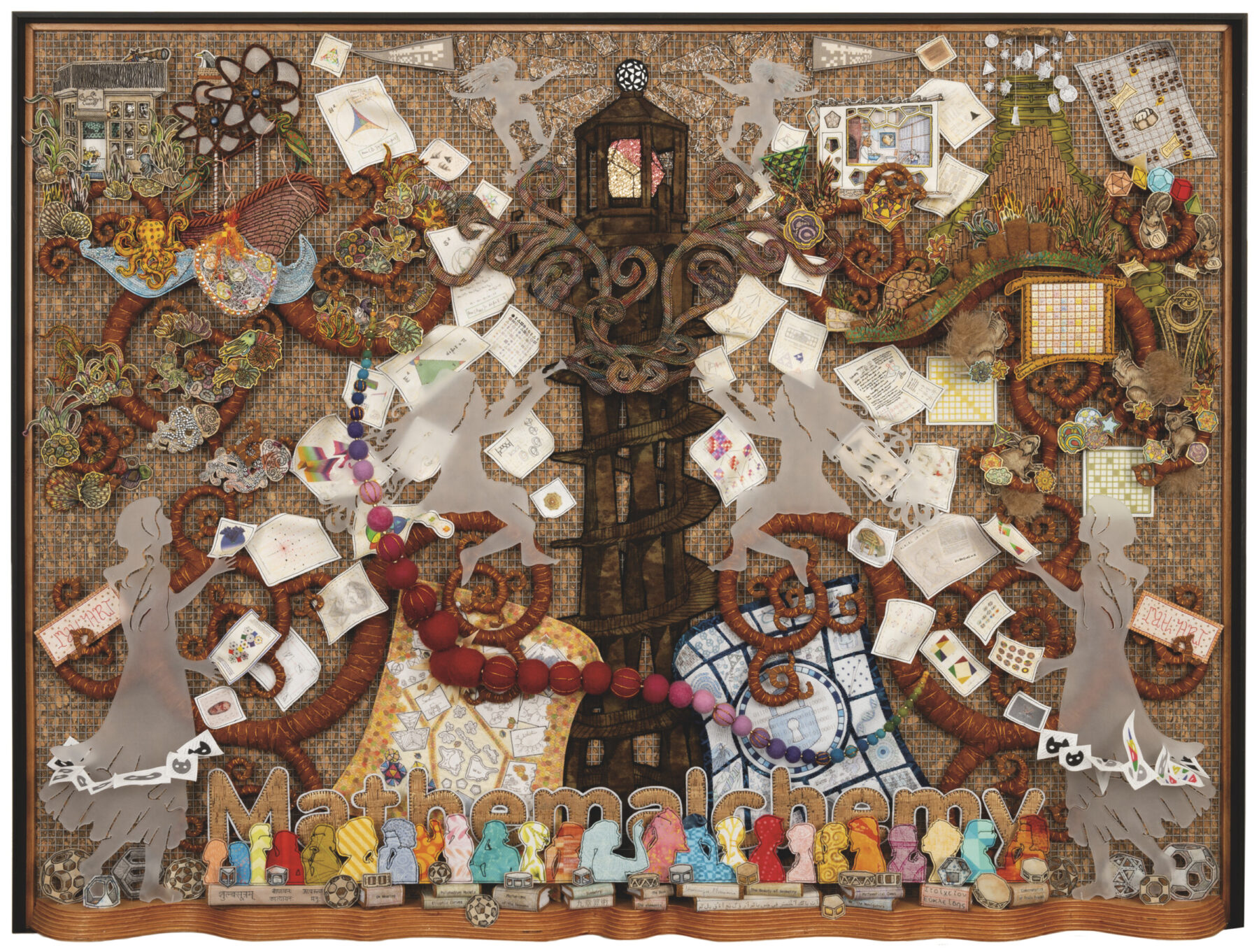
A Curious Collaboration
Dominique Ehrmann, A Curious Collaboration, 2022–2023, textiles and acrylic on cork with wood frame, 30.5 x 40.5 x 3.5 inches. Permanent collection of the National Academy of Sciences. This artwork documents Mathemalchemy, a multimedia art installation that was on view at the National Academy of Sciences (NAS) in 2022 and featured in the Spring 2022 Issues. View Gallery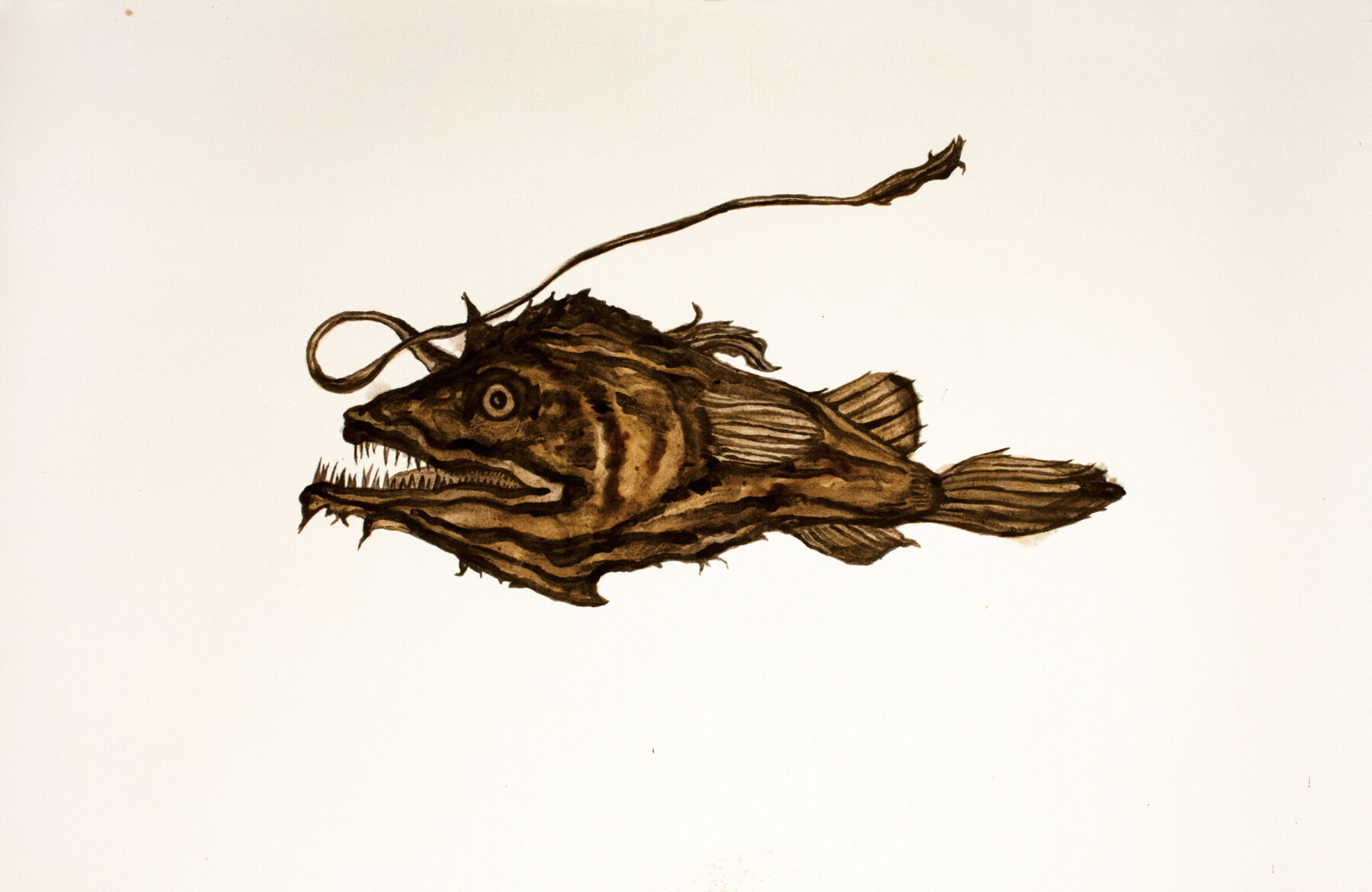
Environmental Apparitions
Brandon Ballengée, SOS Humpback Black Seadevil Anglerfish, 2023, salvaged latex house paint on thrifted cotton bed sheets, 77 x 96 inches. Courtesy of the artist and Various Small Fires, Los Angeles, CA. View Gallery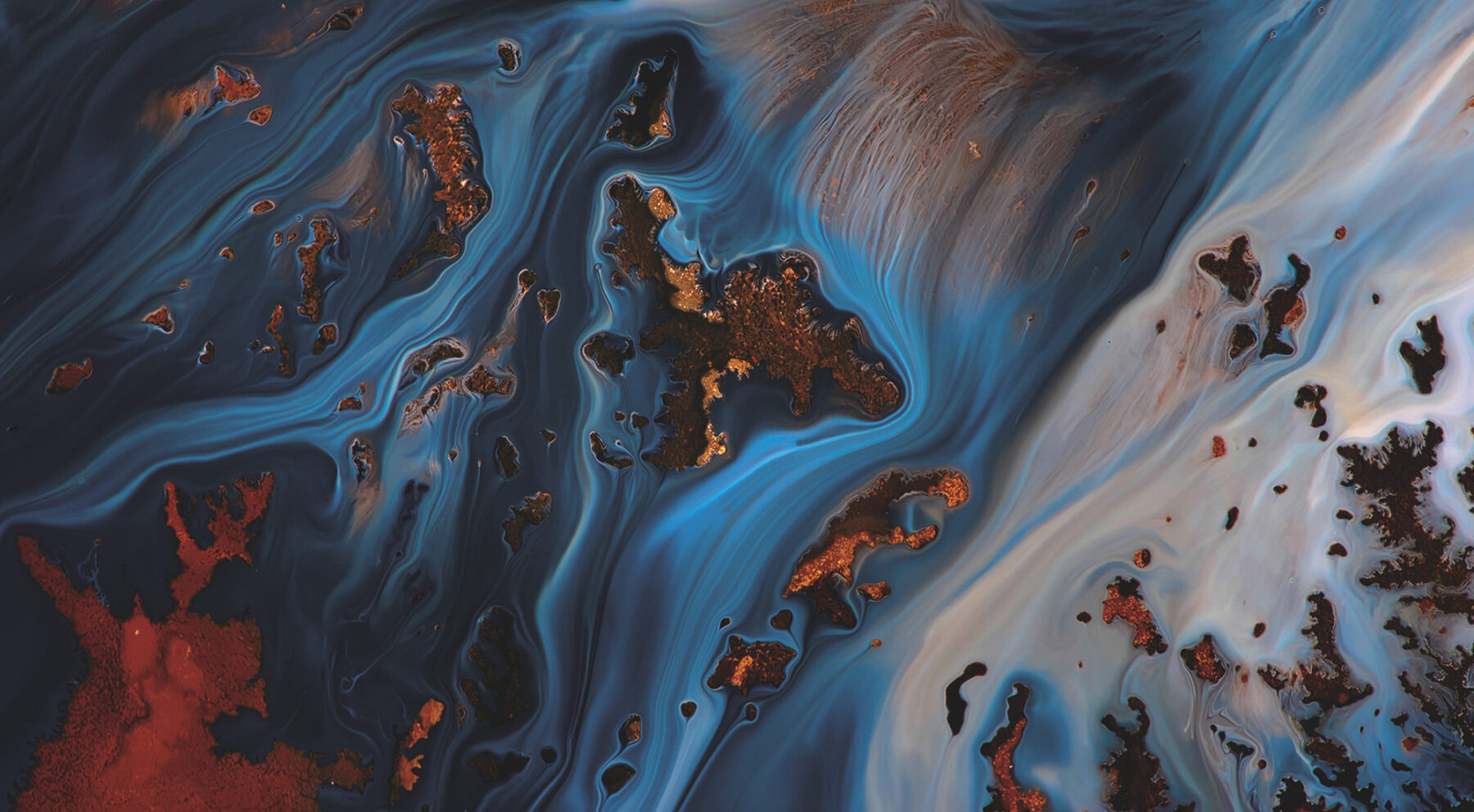
Chaosmosis: Assigning Rhythm to the Turbulent
Roman De Giuli, Sense of Scale, 2022, video still. Chaosmosis: Assigning Rhythm to the Turbulent is an art exhibition inspired by fluid dynamics, a discipline that describes the flow of liquids and gases. View GallerySummer 2023: Adding to the Policy Toolbox
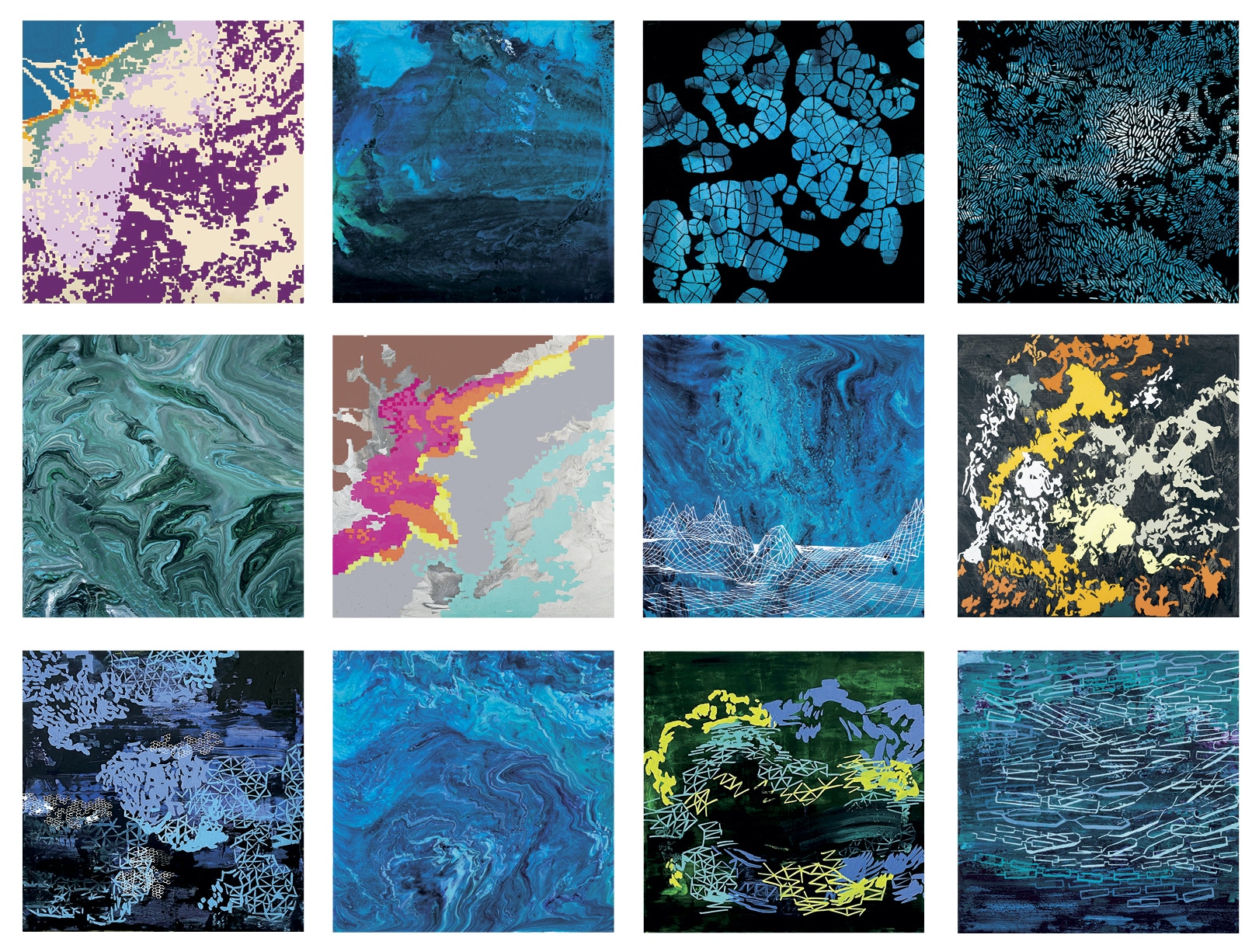
Blue Dreams: Rebecca Rutstein and the Ocean Memory Project
Blue Dreams is an immersive video experience inspired by microbial networks in the deep sea and beyond. Using stunning undersea video footage, abstract imagery, and computer modeling, the work offers a glimpse into the complicated relationships among the planet’s tiniest—yet most vital—living systems. View Gallery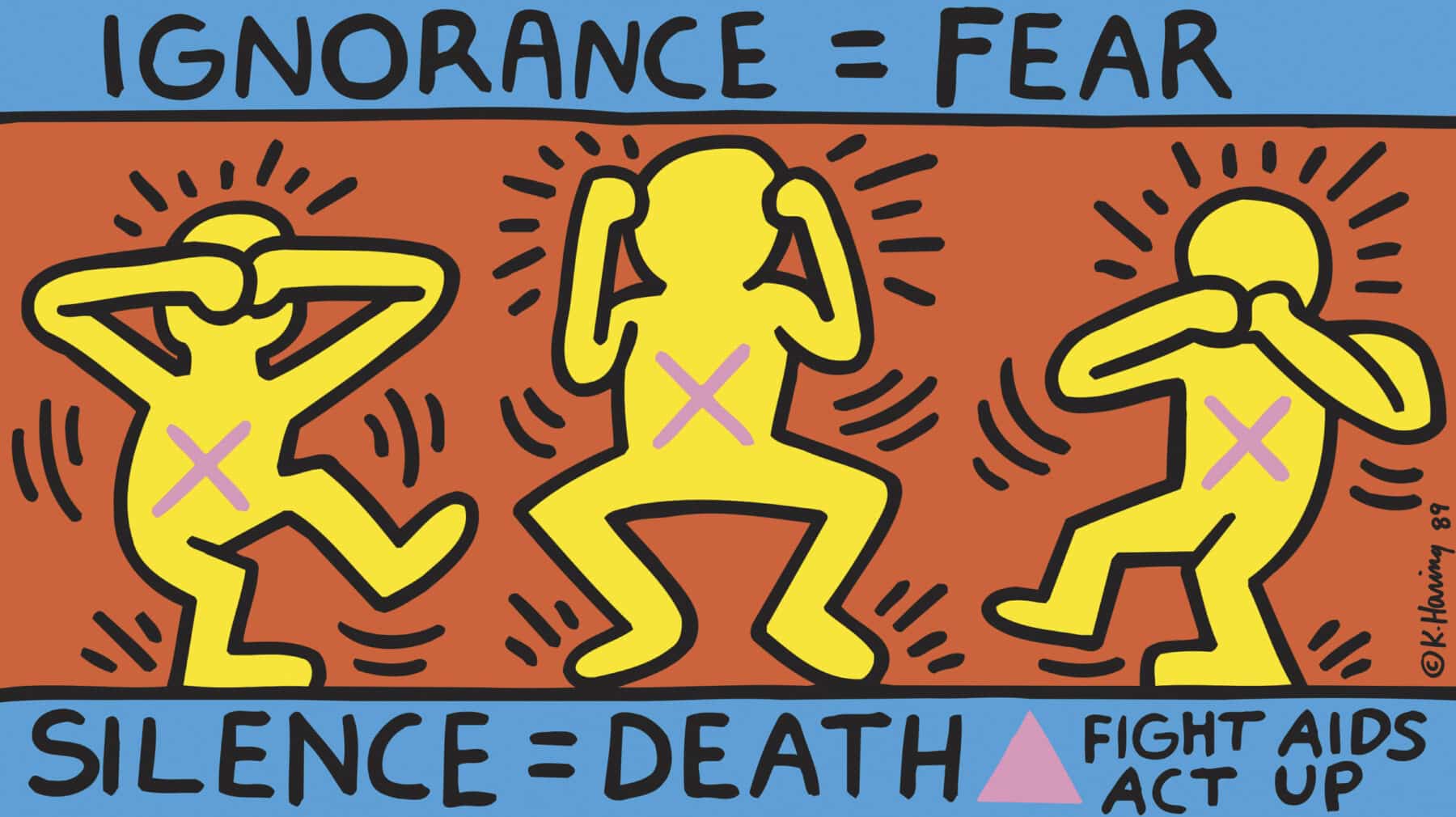
When Art Catalyzed Both Community and Treatment
Ivy Kwan Arce is a Chinese American activist and artist. Diagnosed as HIV positive in 1990, she has fought for HIV/AIDS causes with AIDS Coalition to Unleash Power (ACT UP), Treatment Action Group, People With AIDS Health Group, Asian Pacific Islander Coalition on HIV/AIDS, and God’s Love We Deliver. View GallerySpring 2023: The Human in the Node
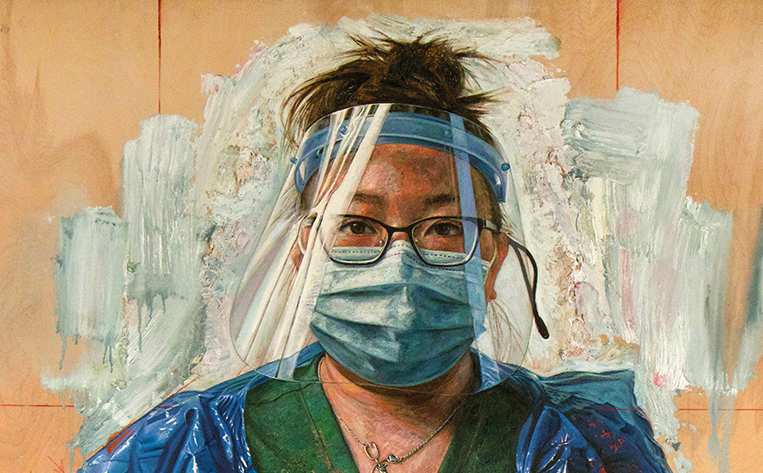
Visions of Nursing
Tim Okamura, Nurse Tamika, 2021, oil on wood panel, 24 x 30 in. During conflict or crisis—from wars and pandemics to individual health emergencies—nurses are often depicted in art as heroes and saviors. View GalleryWinter 2023: In the Gray Areas
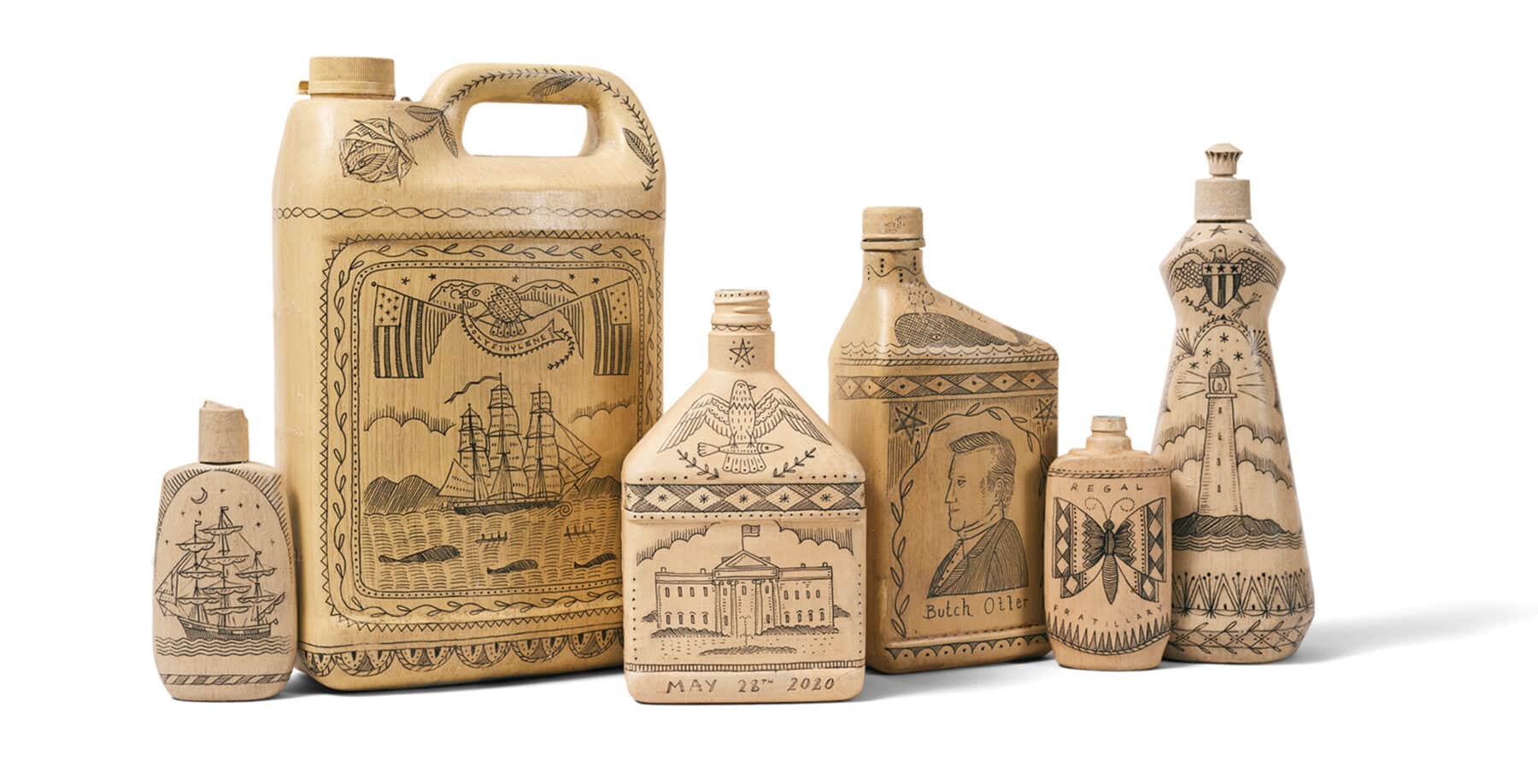
Mischievous Maritime Art
Duke Riley, Nos. 50-P, 74-P, 10, 70, 112, and 106 of The Poly S. Tyrene Memorial Maritime Museum, 2020. Salvaged, painted plastic. Courtesy of the artist. © Duke Riley. View Gallery
The Most Complex Puzzle
Julia Buntaine Hoel, Territory 1, 2017, digital print on aluminum, 16 x 24 inches. Created from microscopy photographs taken by the artist of rhesus macaque brain slides. Artist Julia Buntaine Hoel is fascinated by the intricate workings of the brain, describing it as “the most complex puzzle … our sciences have examined.” View GalleryFall 2022: Humanizing Science and Engineering
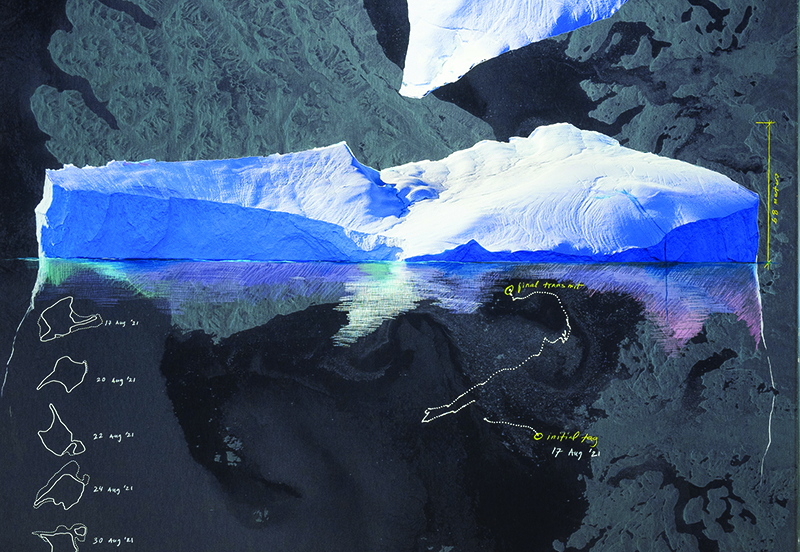
Arctic Ice
Sea Ice Daily Drawings, 2019–2022, aluminum, acrylic, paper, and ink (detail) Integrating field data, remote satellite imagery, scientific analysis, and multimedia visual representation to document Arctic ice that is disappearing due to climate change, this artwork is the outcome of a four-year collaboration involving art, design, and polar science between artist Cy Keener, landscape researcher Justine Holzman, climatologist Ignatius Rigor, and scientist John Woods. View Gallery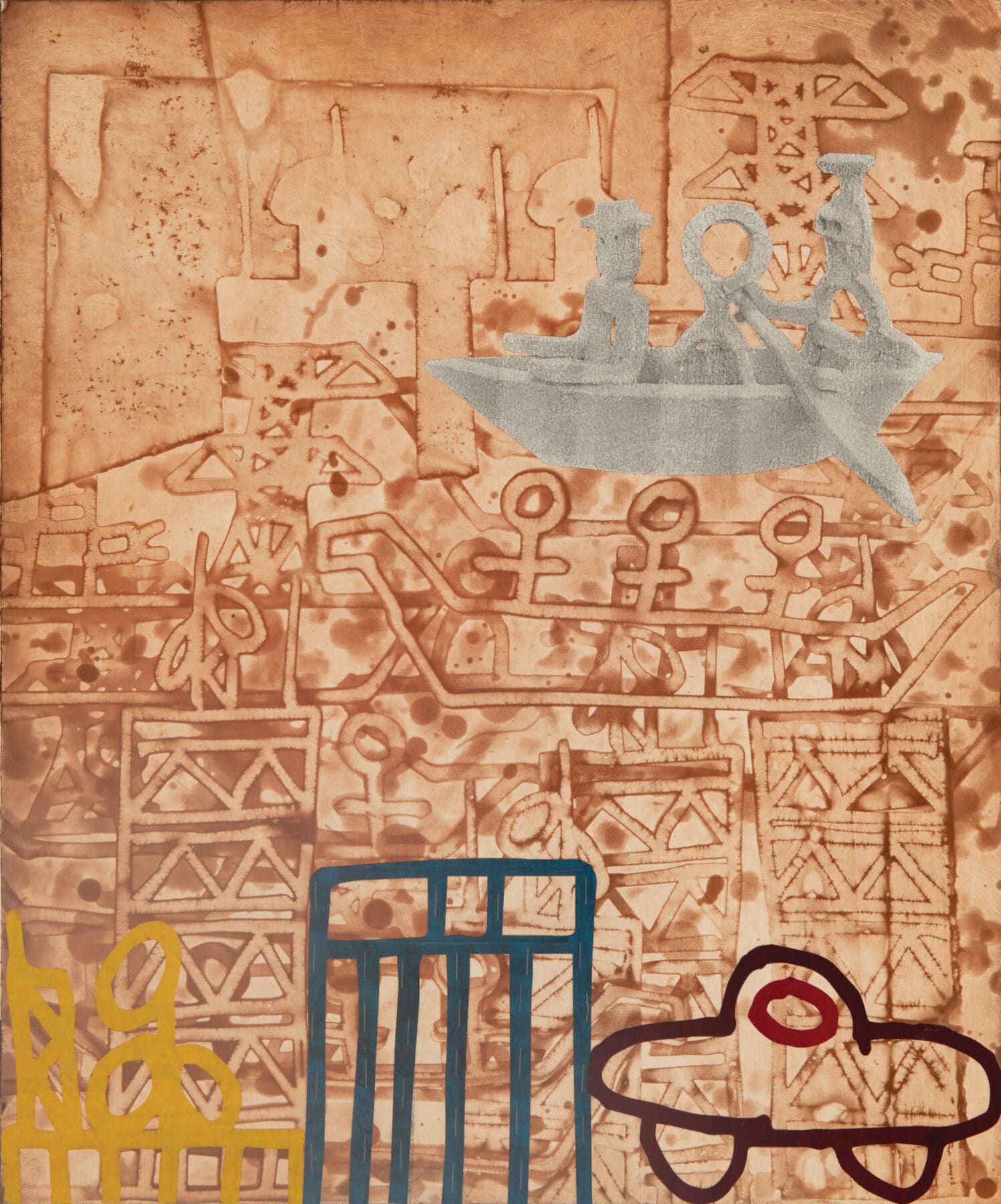
The Story Is Yours, Too
Joe Feddersen Omak Lake 2, 2019; monoprint on paper with spray paint; 19 1/2 x 15 inches Three figures dominate artist Joe Feddersen’s print Omak Lake 2: a deer, or perhaps a ram, head extended toward the outstretched arm of a human with a turtle-like torso—or are those stylized lungs?—and View Gallery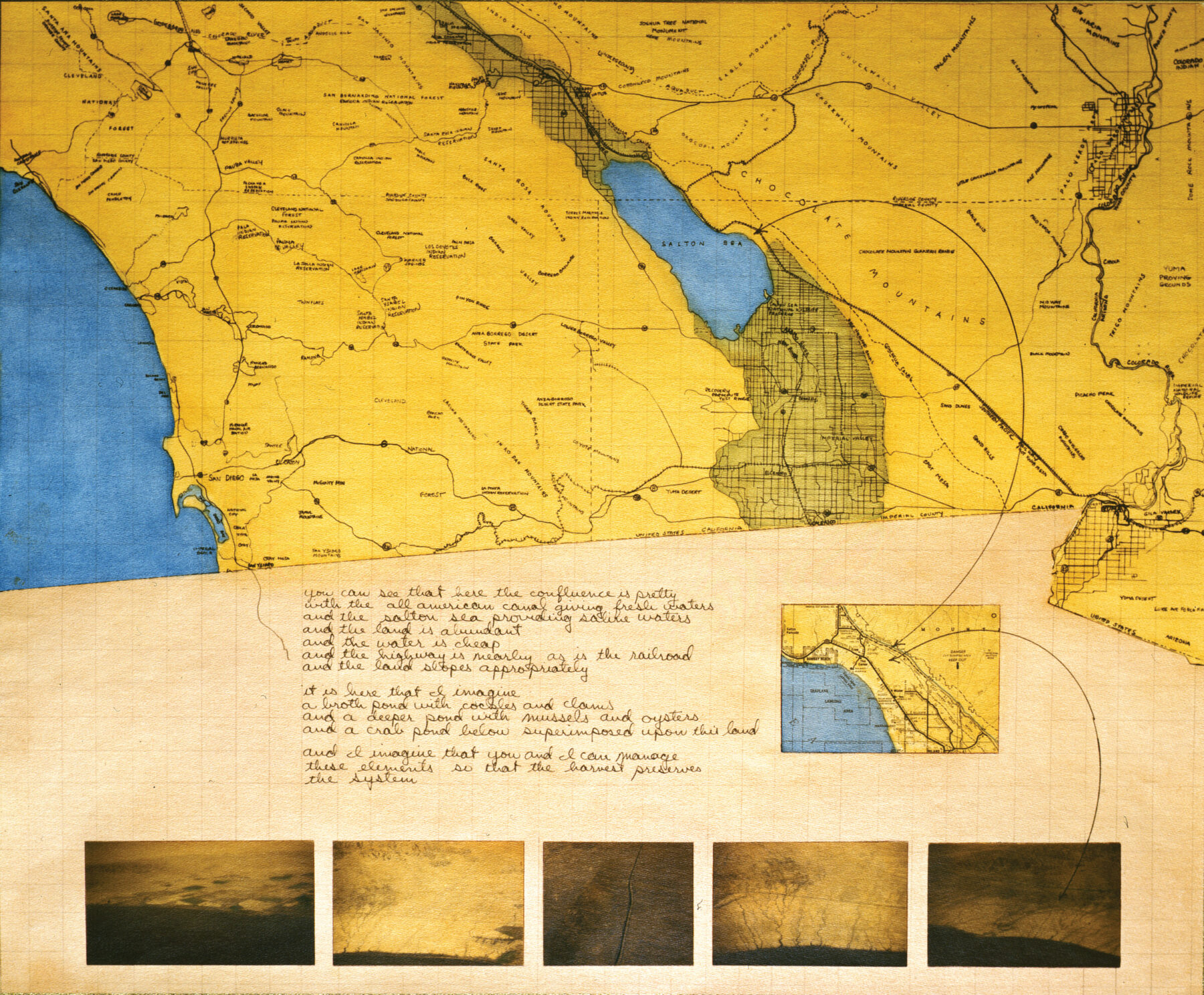
Remembering the Harrisons
Helen and Newton Harrison, You Can See that Here the Confluence is Pretty… From the Fourth Lagoon, The Lagoon Cycle, 1974–1984. Paper on canvas, acrylic gouache, collage, photographic print with ink, print, and pencil. View GallerySummer 2022: Collaboration in the Cloud
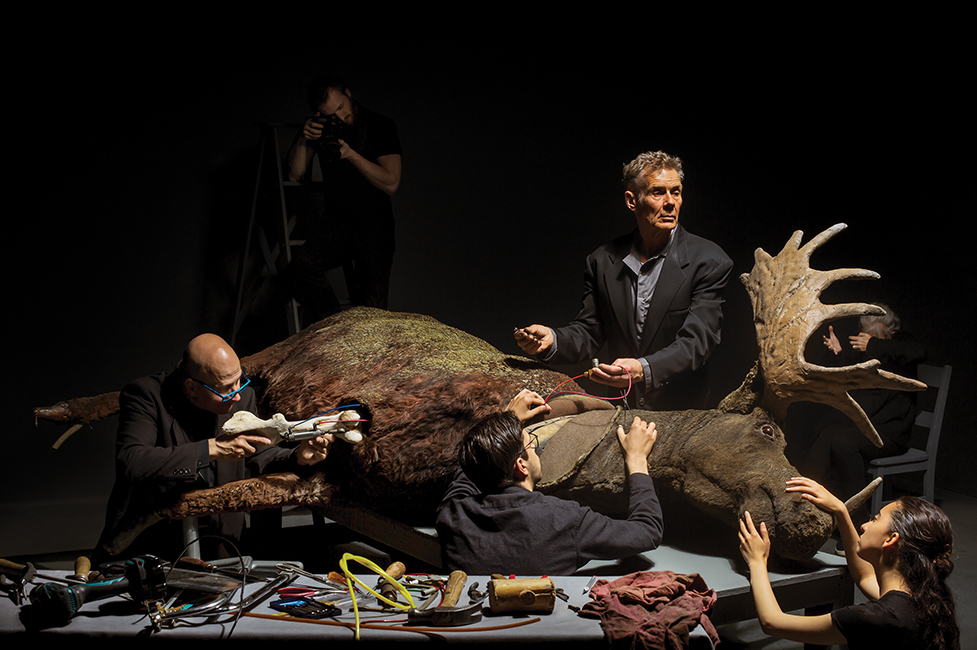
The C Word: Artists, Scientists, and Patients Respond to Cancer
Max Dean, The Gross Clinic, 2016. Image courtesy of Max Dean. After being diagnosed with prostate cancer on his sixty-second birthday, Canadian multidisciplinary artist Max Dean began to explore his prognosis through his art practice. View Gallery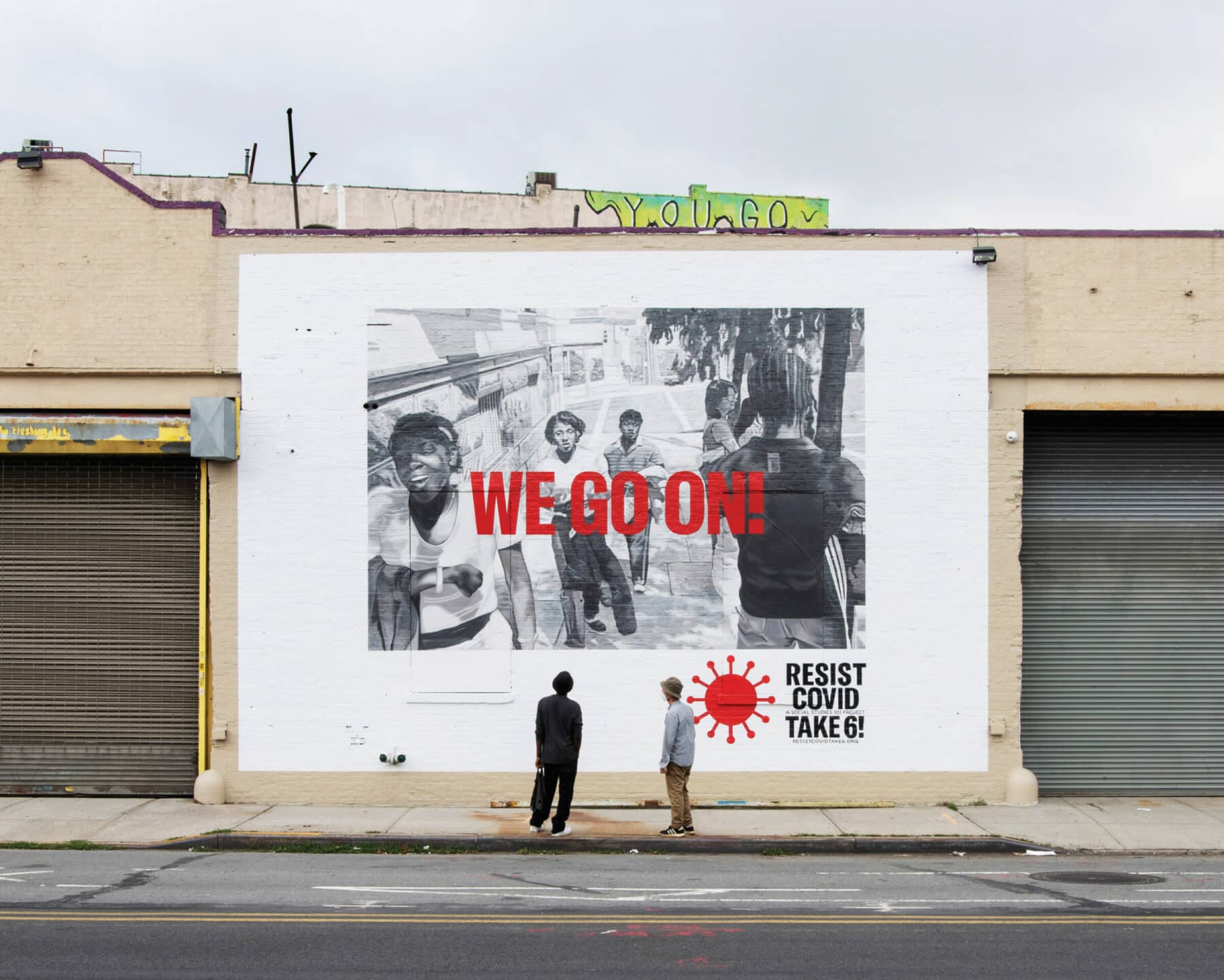
Reflections on Carrie Mae Weems’s RESIST COVID | TAKE 6!
I often share a Zimbabwean proverb about lion hunts: “Until the lion tells its side of the story, the tale of the hunt will always glorify the hunter.” I felt the spirit of that proverb when I observed Carrie Mae Weems’s RESIST COVID | TAKE 6! View Gallery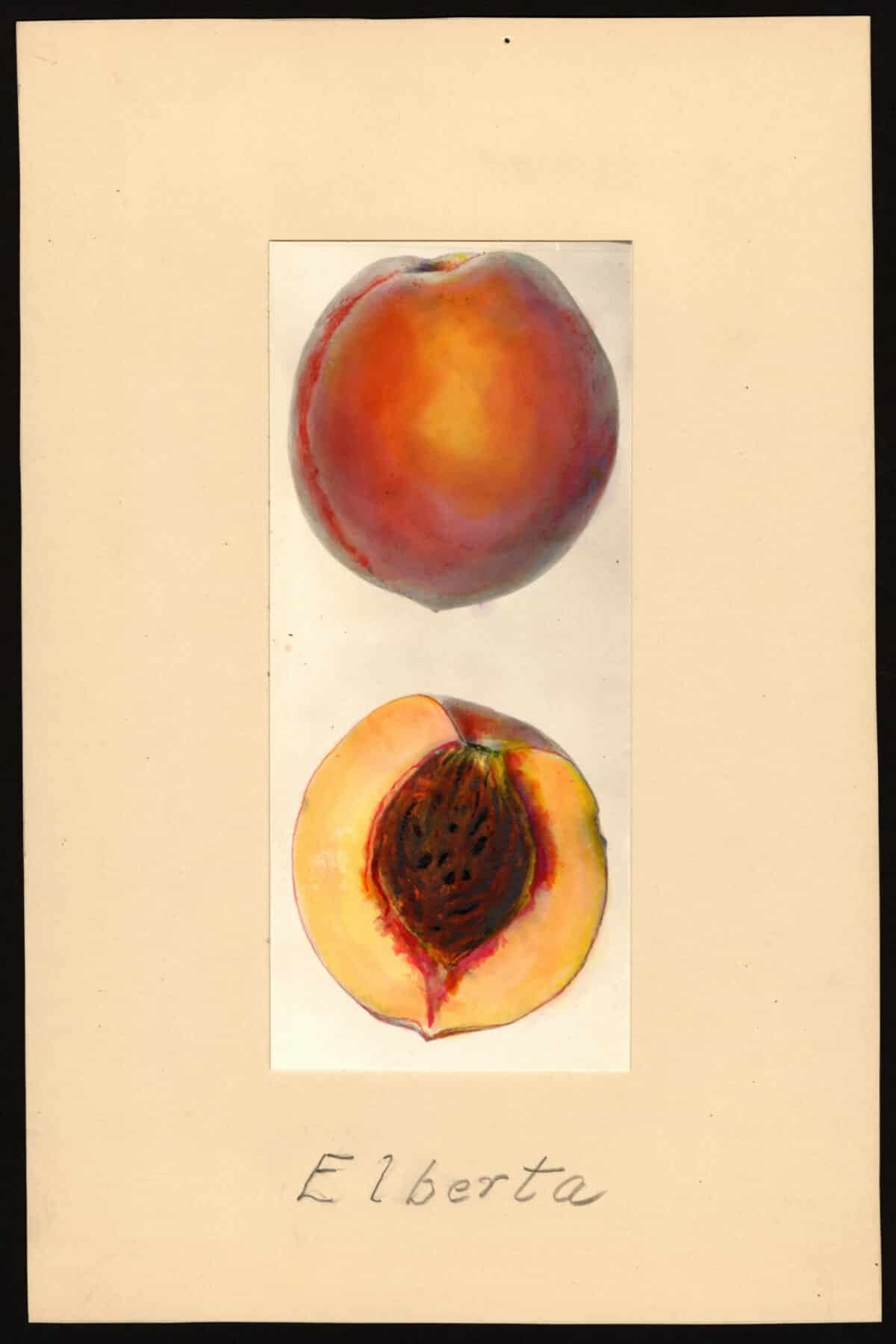
The Pomological Watercolor Collection
In the late nineteenth and early twentieth centuries, healthy orchards and groves were seen as crucial to national prosperity. As people across the country created new cultivars, or varieties, through hybridization, the US Department of Agriculture (USDA) set out to document them with a national register of fruits. View GallerySpring 2022: Governing the Barely Imagined

Mathemalchemy
Mathemalchemy, 2021, mixed media What happens when a fiber artist meets a world-renowned mathematician? In a word: mathemalchemy. In 2019, the mathematician Ingrid Daubechies, who the New York Times dubbed the “godmother of the digital image” because of her work with wavelets and the role that it played in the advancement of image compression technology, visited an art exhibit entitled Time to Break Free. View Gallery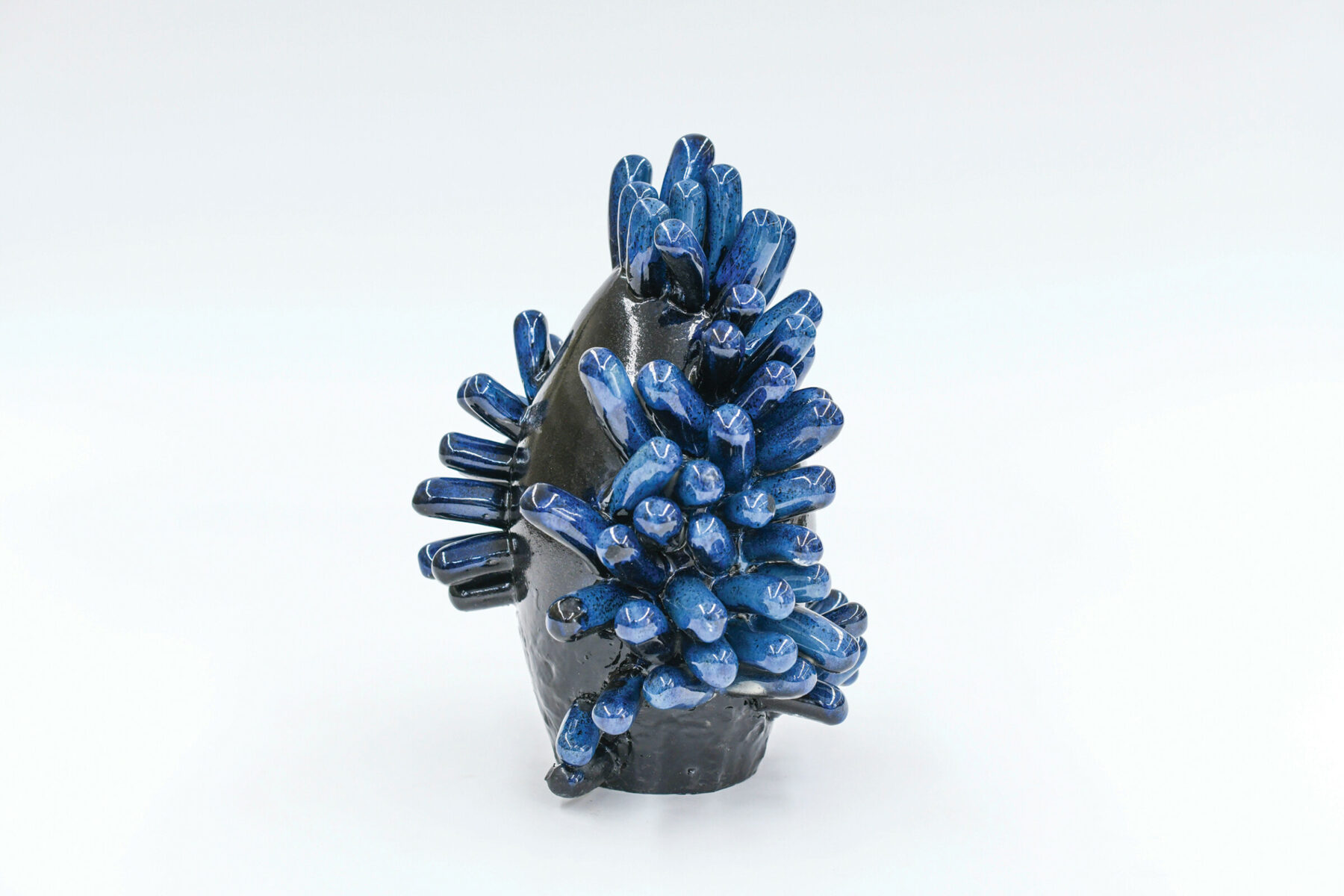
Sculpting Science
Contagion, 2021, ceramic, 13 x 8 x 9 inches Ceramicist Kiley Snider is inspired by nature and organic forms. A recent graduate of Arizona State University, she jumped on the opportunity to collaborate with scientists during her senior year as part of the “Art and Science” course taught by Susan Beiner and Robby Roberson. View Gallery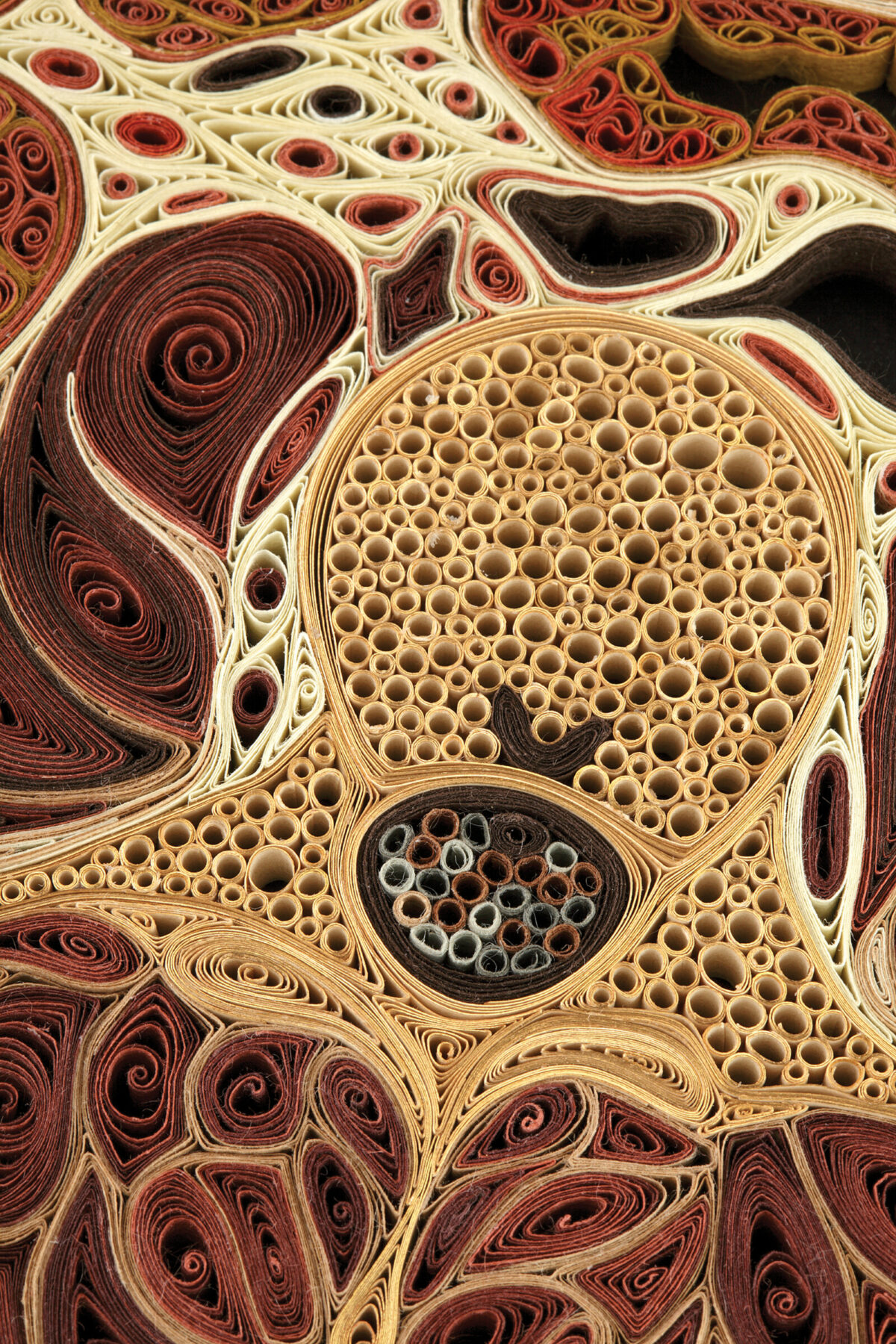
Tissue Series
Lisa Nilsson, Female Thorax (detail), 2013 Quilling, the art of manipulating small strips of paper into elaborate designs and objects, is believed to have originated in ancient Egypt, although its precise origins are unknown. During View Gallery
The Subversive Beauty of Fallen Fruit
David Allen Burns and Austin Young, Event Horizon: Darkness is a Temporary Condition, 2019, installation view, commissioned by Kuntshall 3.14 for the city of Bergen, Norway. Halfway through Agnès Varda’s film The Gleaners and I (2000), a judge in full regalia stands in a field of newly harvested tomatoes and reads an edict from 1554 that authorizes “the poor, the wretched, and the underprivileged to go to the fields after the harvest, from sunrise to sundown, and glean leftover fruit and vegetables.” View GalleryWinter 2022: Fixing the Disconnects
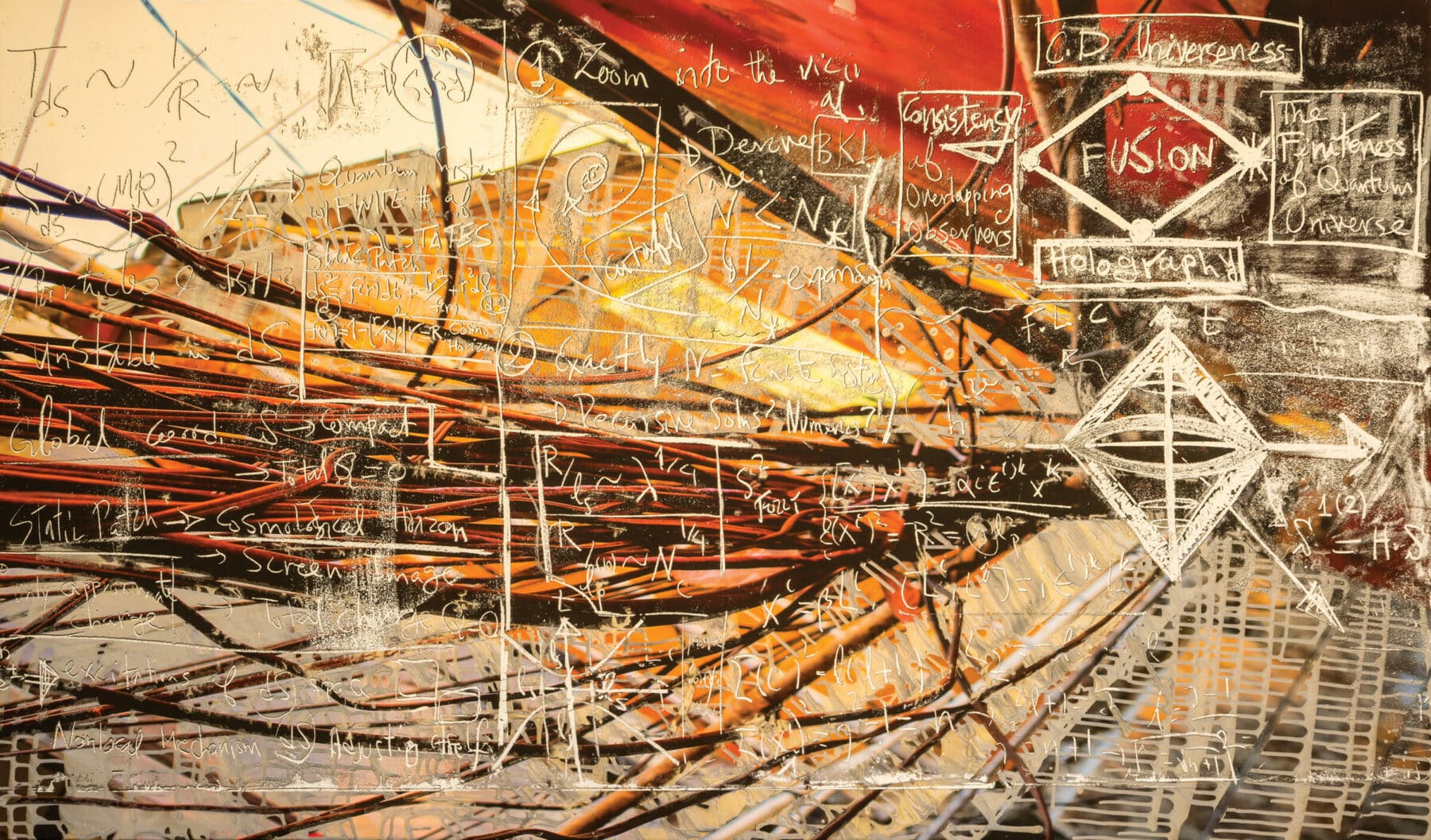
Wired and CERN
Quantum System, 2020, 39 x 69 inches On a trip to Brazil, artist Steve Miller was captivated by the tangled web of power lines in Rocinha, Rio de Janeiro, the largest favela in the country. View Gallery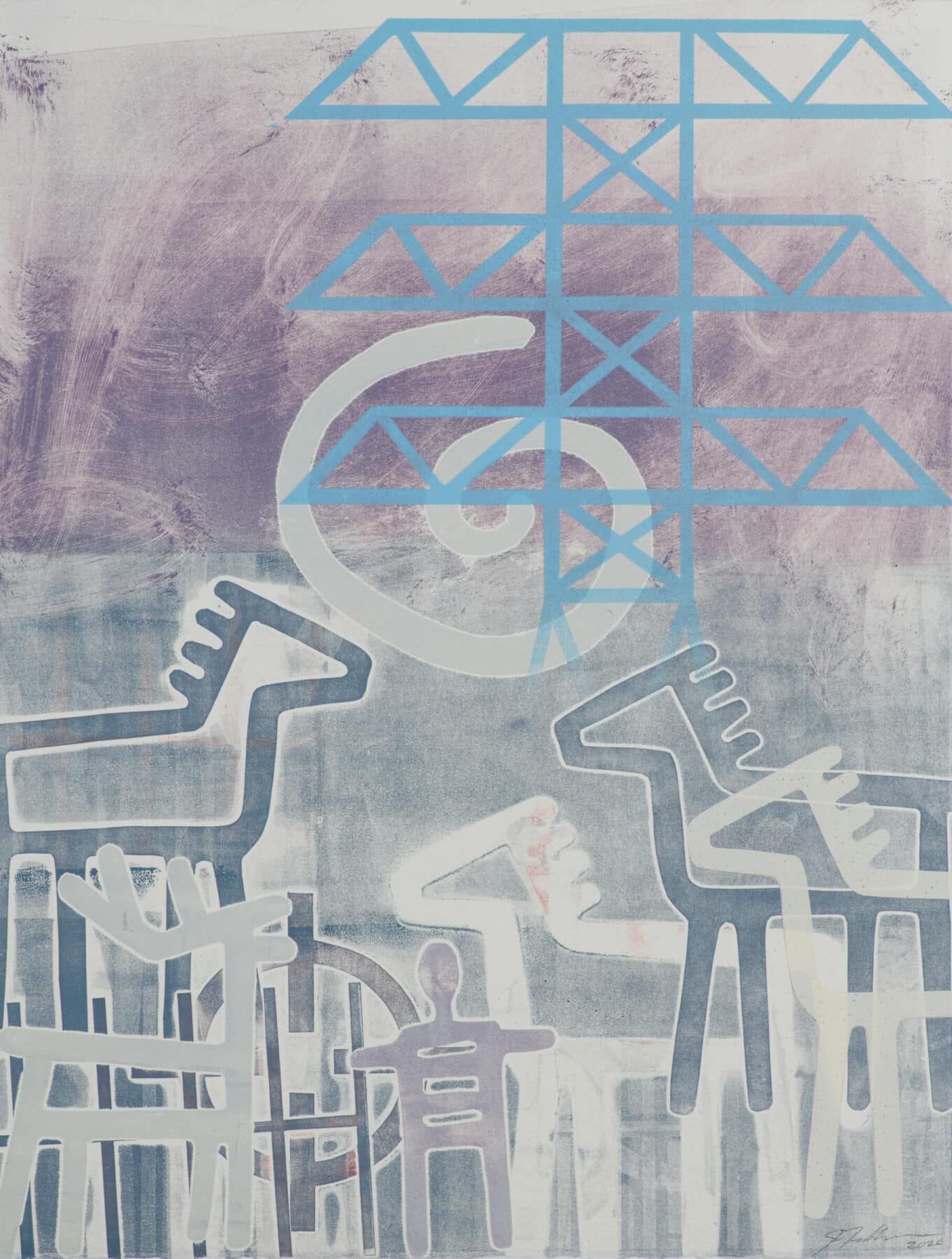
Inhabited Landscapes 8
Artist Joe Feddersen is a member of the Confederated Tribes of the Colville Reservation. In his 40-year artistic career, he has worked in painting, basketry, glass sculpture, photography and computer-generated imagery. View Gallery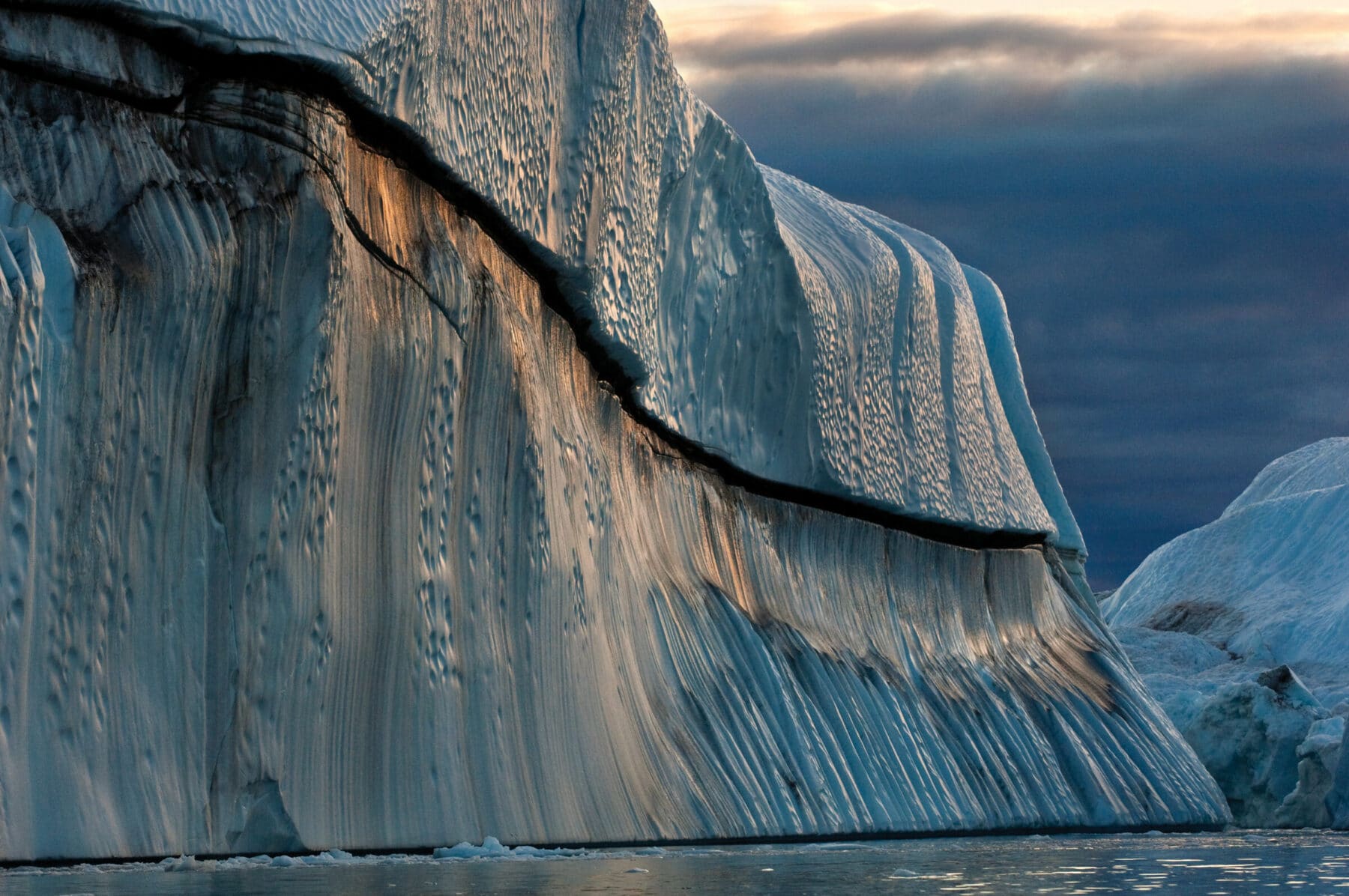
Photography of the Anthropocene
Crushed House after Hurricane Irma, South Ponte Vedra Beach, Florida, USA, September 12, 2017. For four decades, James Balog has photographed the beauty of the world’s natural resources as well as the impact of climate change on the Earth and its inhabitants. View Gallery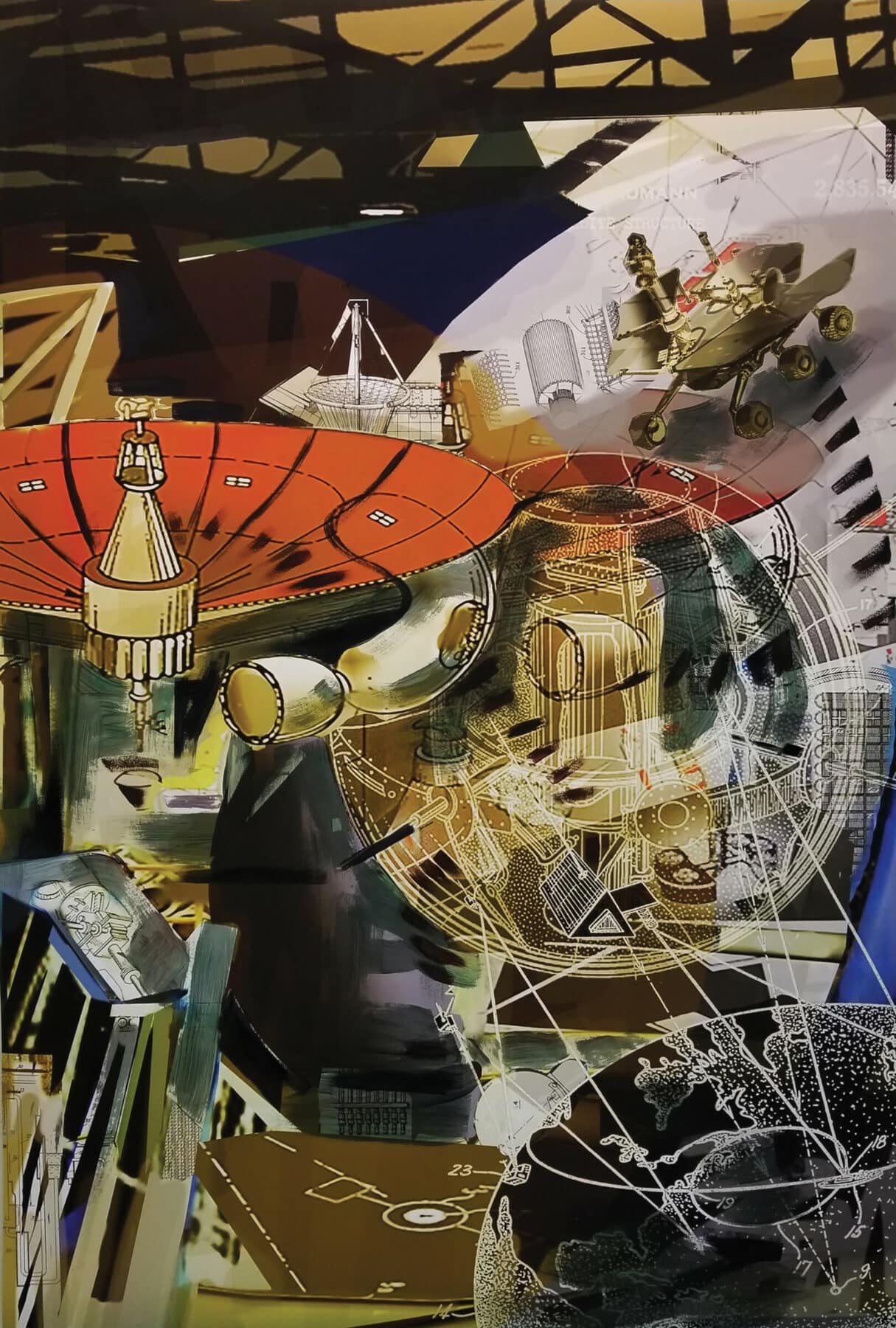
Complexity and Visual Systems
Art, in both creation and experience, is one of the most complex of human endeavors. Artist Ellen K. Levy engages the mental loop of seeing, connecting, and processing by juxtaposing imagery that creates meaning from unexpected and often disconnected relationships. View GalleryFall 2021: Making Space for Everyone
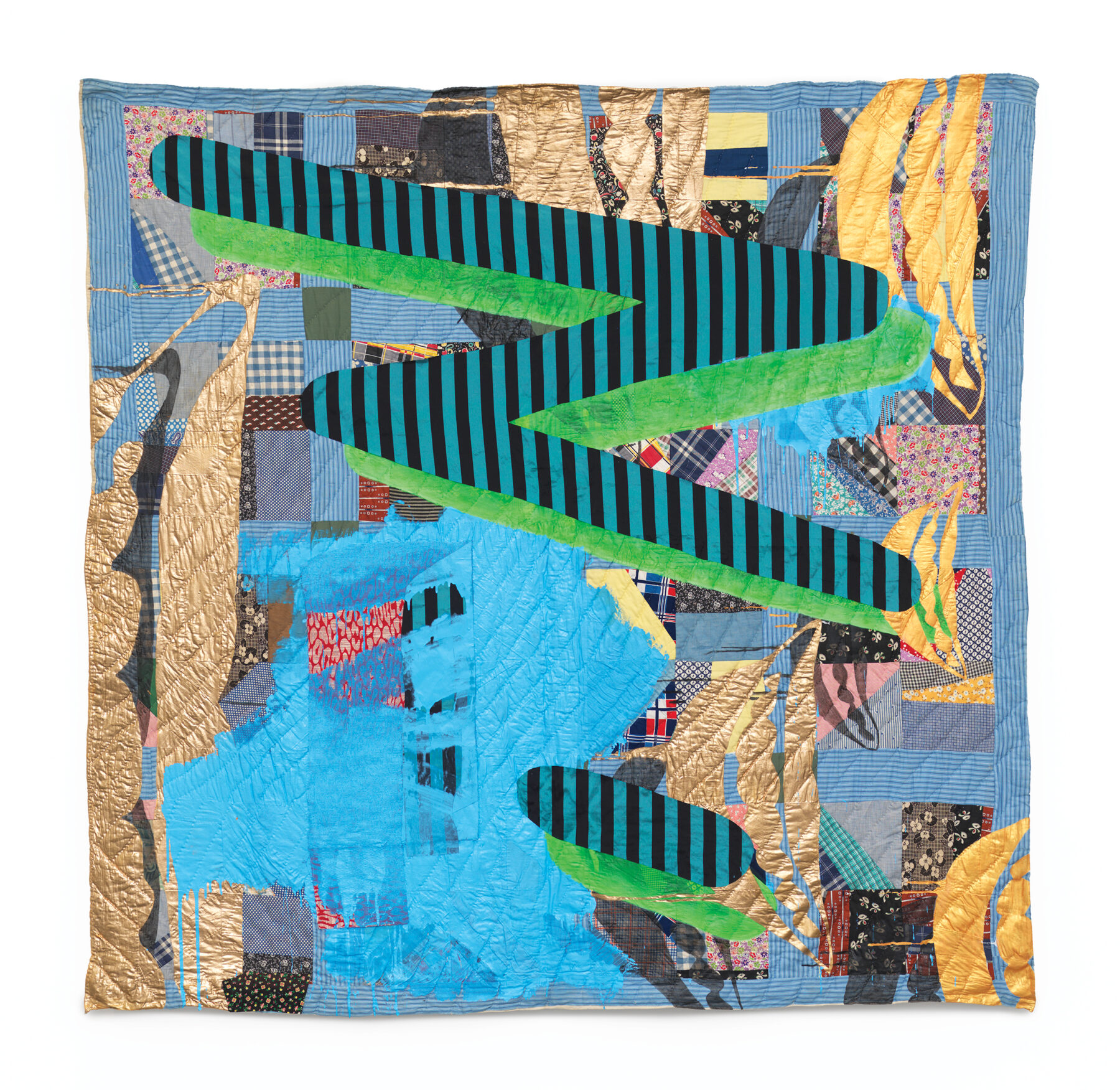
Codeswitch
A Visionary Agenda—in Quilts, Mars, and Pound Cake Sanford Biggers, The Talk, 2016. Antique quilt, fabric, tar, and glitter, 80 x 84 inches. Courtesy of the artist. Artists and poets have unique ways to communicate salient truths about the human experience. View Gallery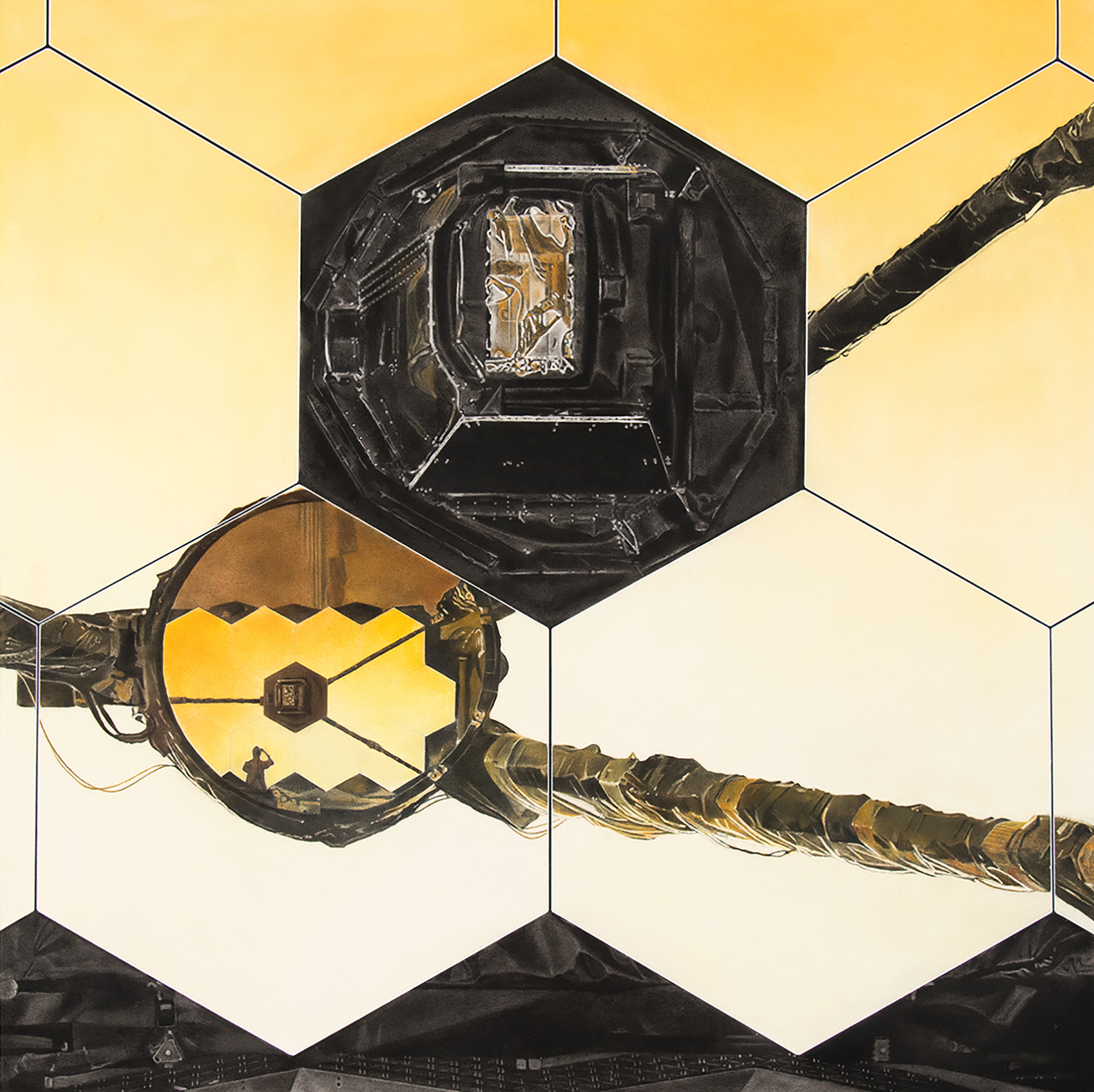
Reflections on a Tool of Observation
Cryogenic Test Structure, 2018, charcoal on paper, 49 x 49 inches In 2017, Washington, DC-based artist Timothy Makepeace was one of several artists selected by NASA to create artwork inspired by the construction of the James Webb Space Telescope. View Gallery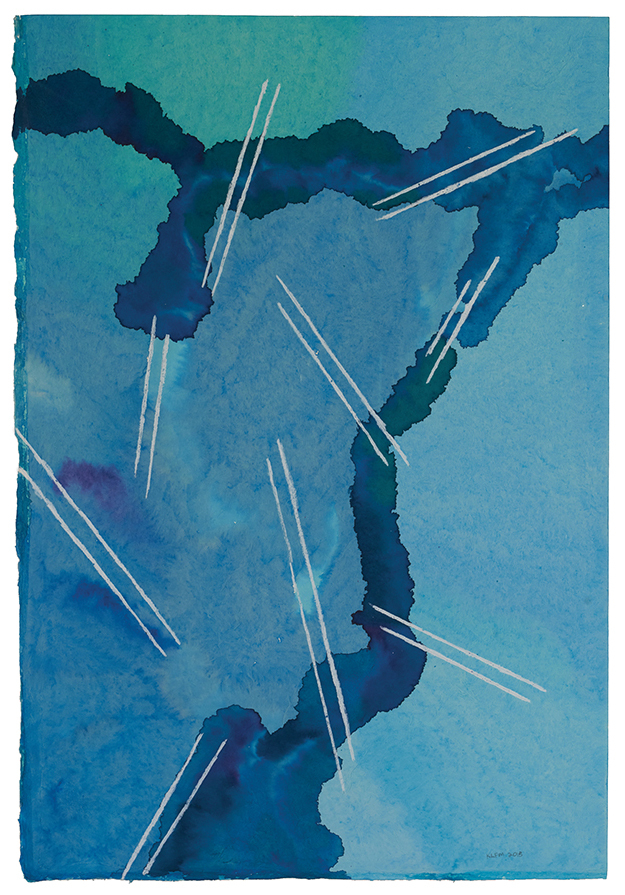
Accounting for Lives Lost
By some estimates at least 1.8 million Africans lost their lives during the transatlantic slave trade. Using an online database called Slave Voyages, artist Kathie Foley-Meyer studied maps detailing the paths that slave ships took from Africa to the Americas. View GallerySummer 2021: Everything You’ve Ever Learned
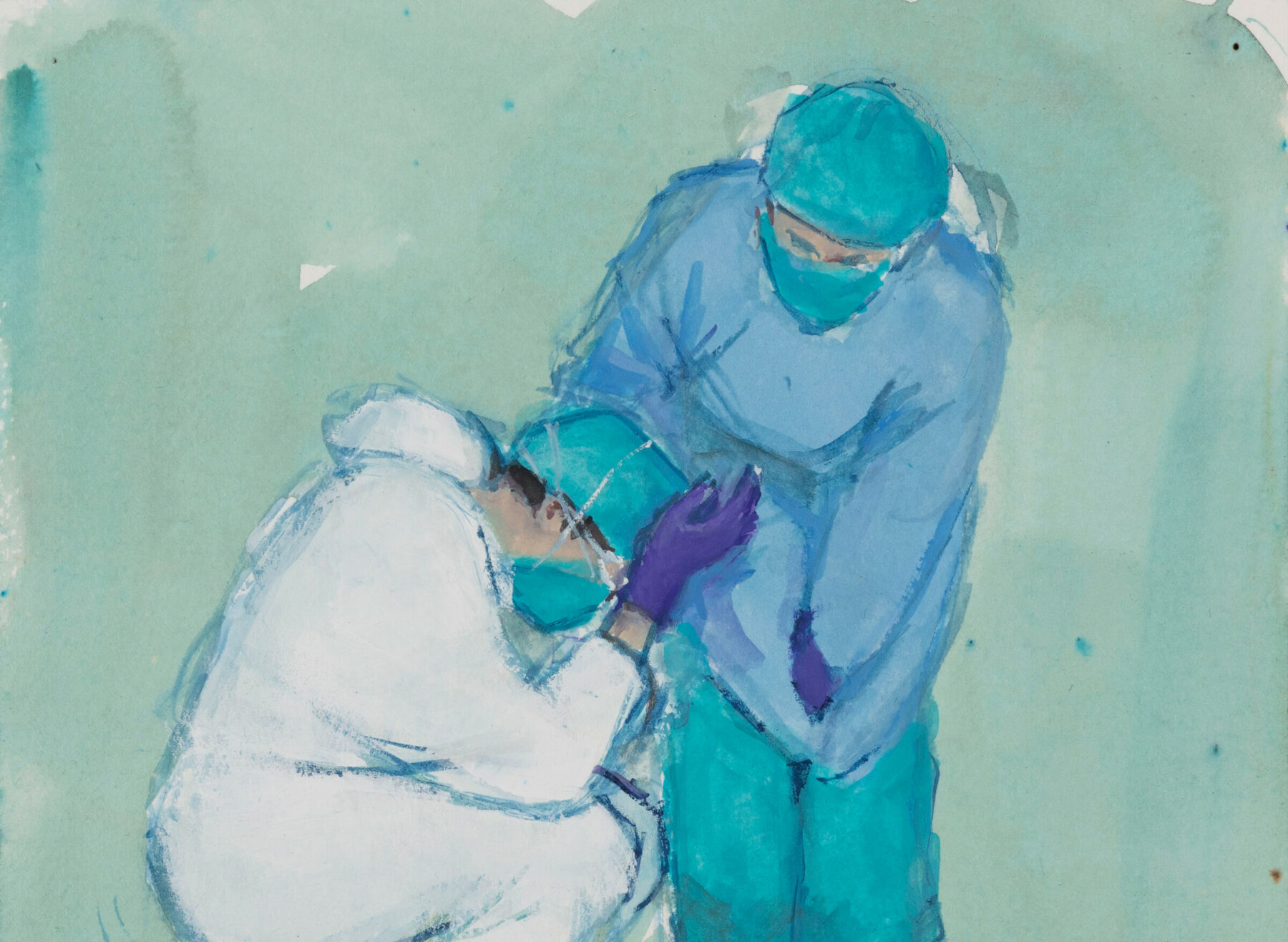
COVID Artifacts
It’s been more than a year since the pandemic started. Now that vaccines have arrived, a measure of hope has returned. But memories of the early days of the pandemic lie close to the emotional surface for many of us. View Gallery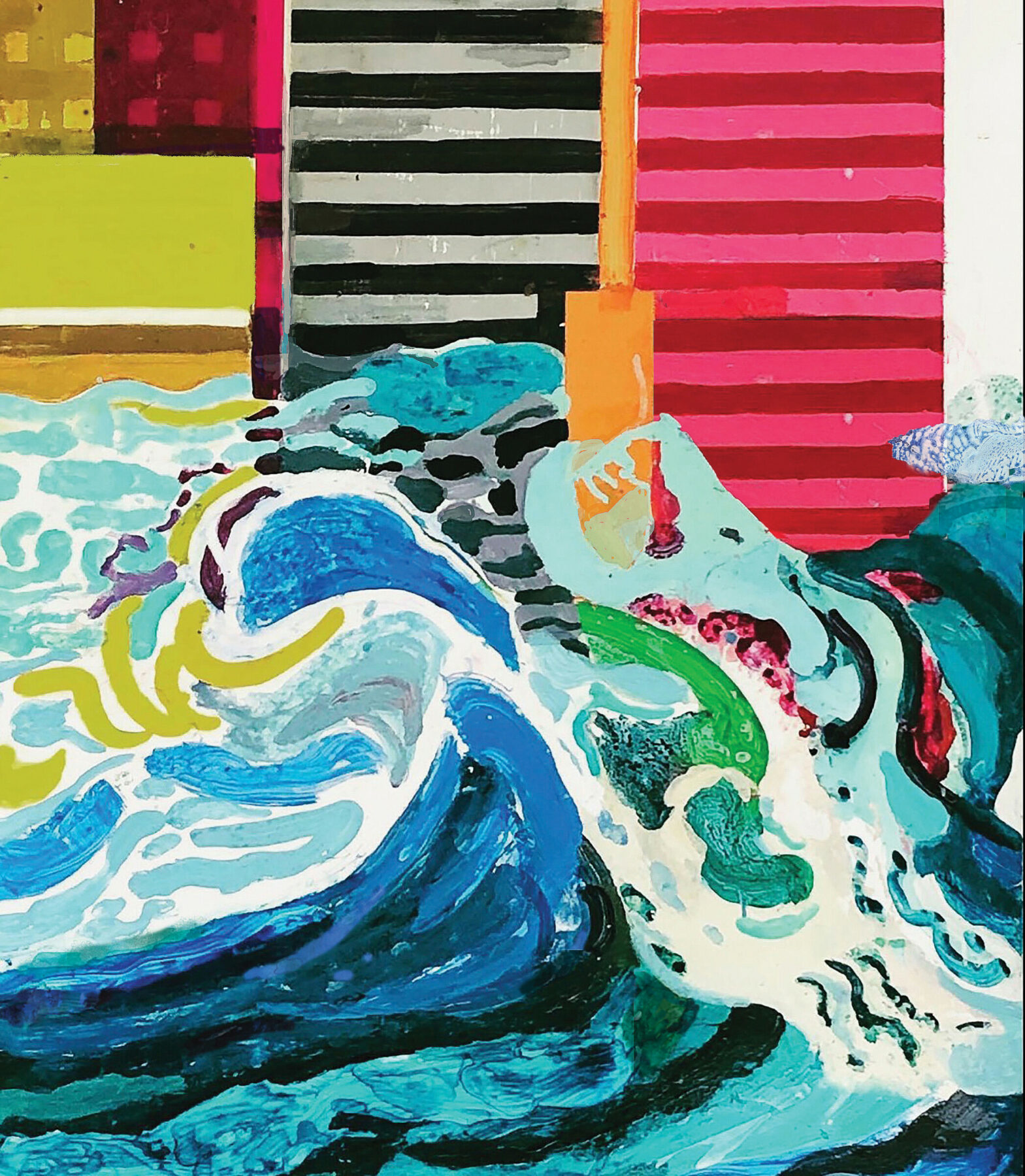
Think About Water
An Ecological Artist Collective Think About Water is a collective of ecological artists and activists who got together to use art to elevate the awareness and discussion of water issues. Created by the painter and photographer Fredericka Foster in early 2020, the collective was intended to celebrate, as the organizers describe it, “our connection to water over a range of mediums and innovative projects that honor this precious element.” View GallerySpring 2021: Views From the Inside
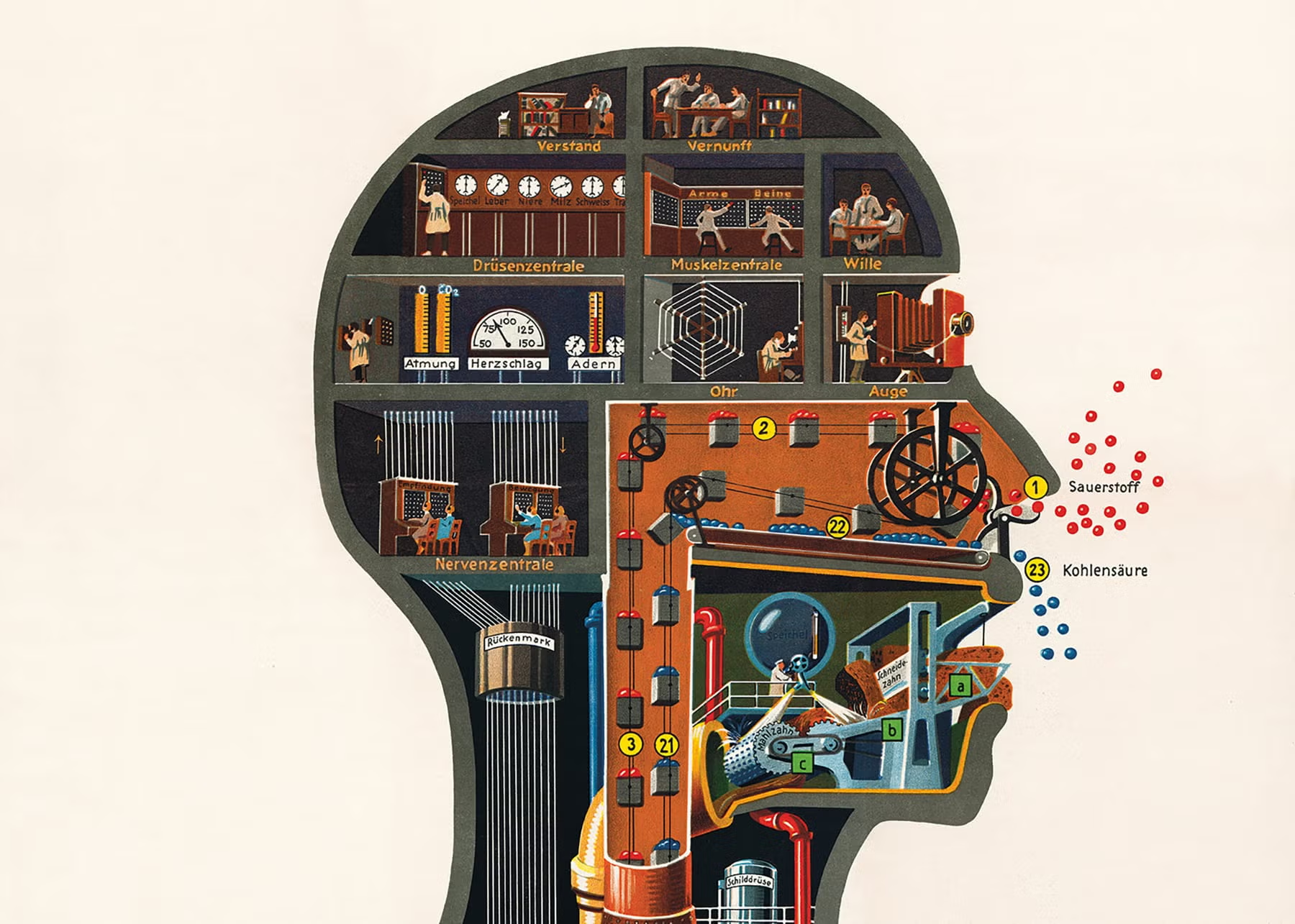
Technoscientific Bodies
The sensory pathway and radio system, in Gerhard Venzmer et al., Hand- und Lehrbuch der Krankenpflege 1 (Stuttgart: Franckh’sche Verlag, 1938), pl. 10. Originally from Fritz Kahn, Das Leben des Menschen 4 (1929), pl. View Gallery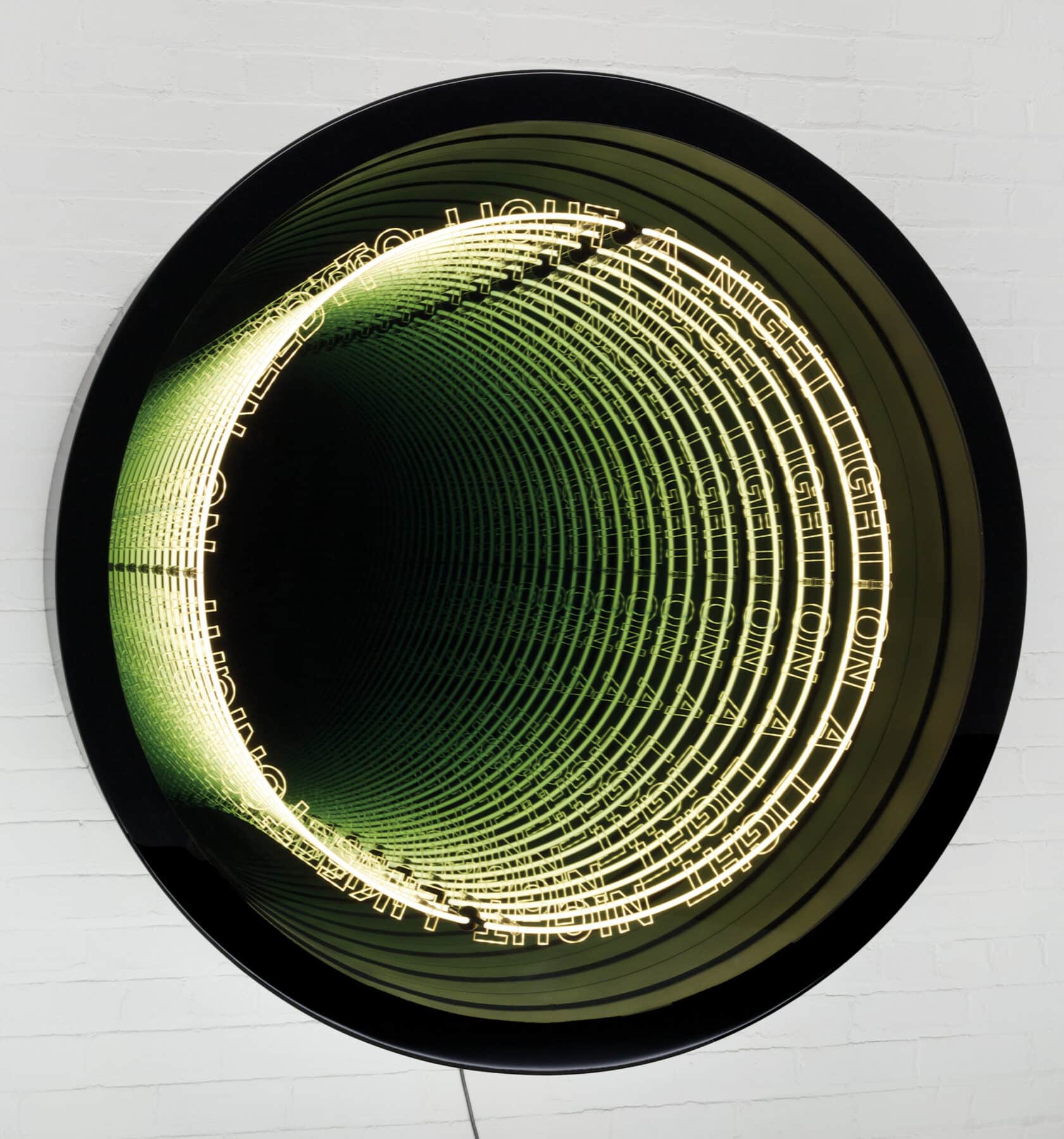
Electric Energy
Iván Navarro, Street Lamp (Yellow Bench), 2012; neon light, cement, metal and electric energy; 38 1/2 × 72 × 43 inches. All images © Courtesy Gallerie Templon, Paris – Brussels. View GalleryWinter 2021: Postpandemic
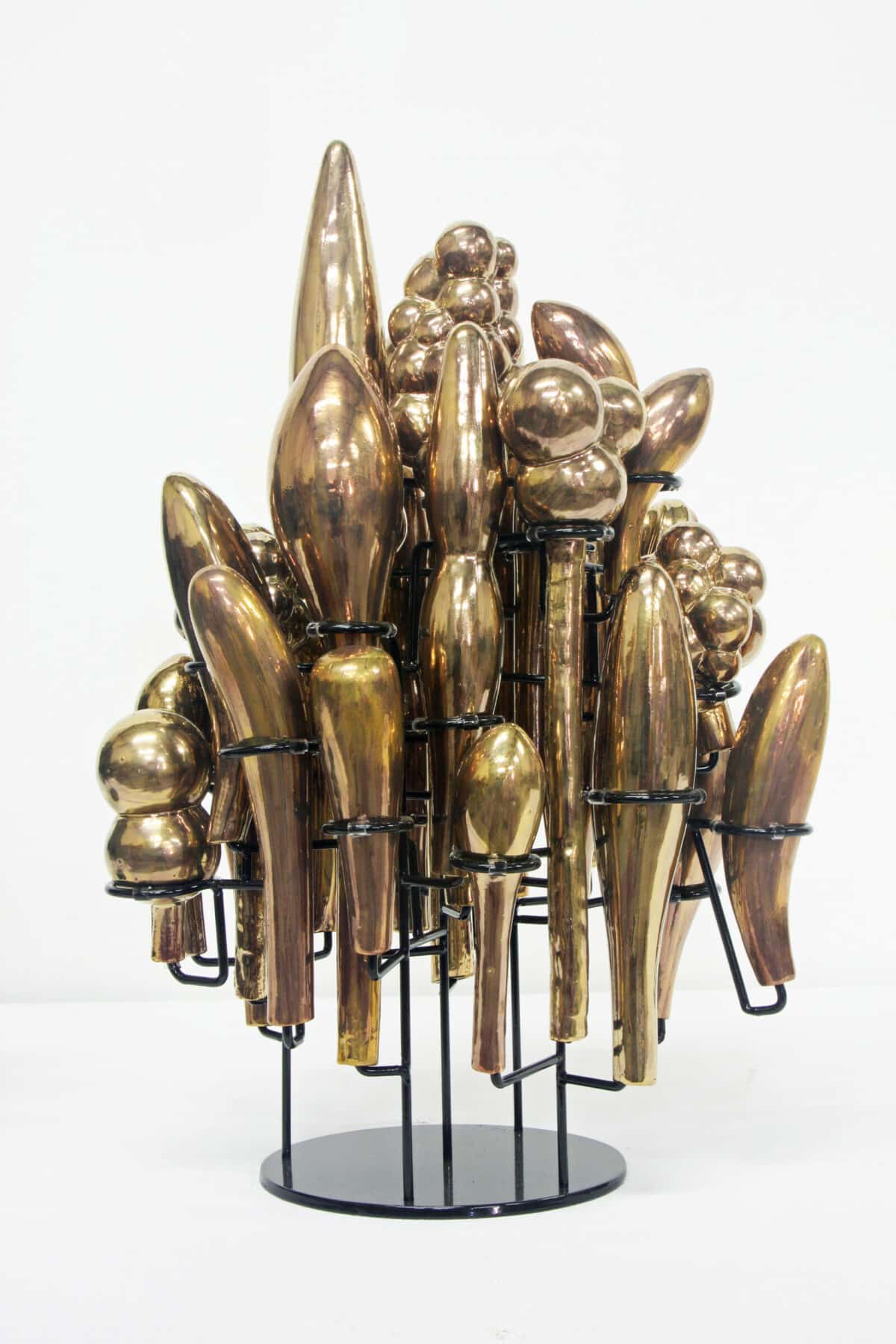
Agricultural Cycles as Allegories
DAVID HICKS, Construction (Rose), ceramic and stainless steel, 2016 David Hicks creates ceramic sculptures inspired by nature and industrial agriculture. Growing up in California’s Central Valley, he was attracted to the crops that grew in the fields around his home. View Gallery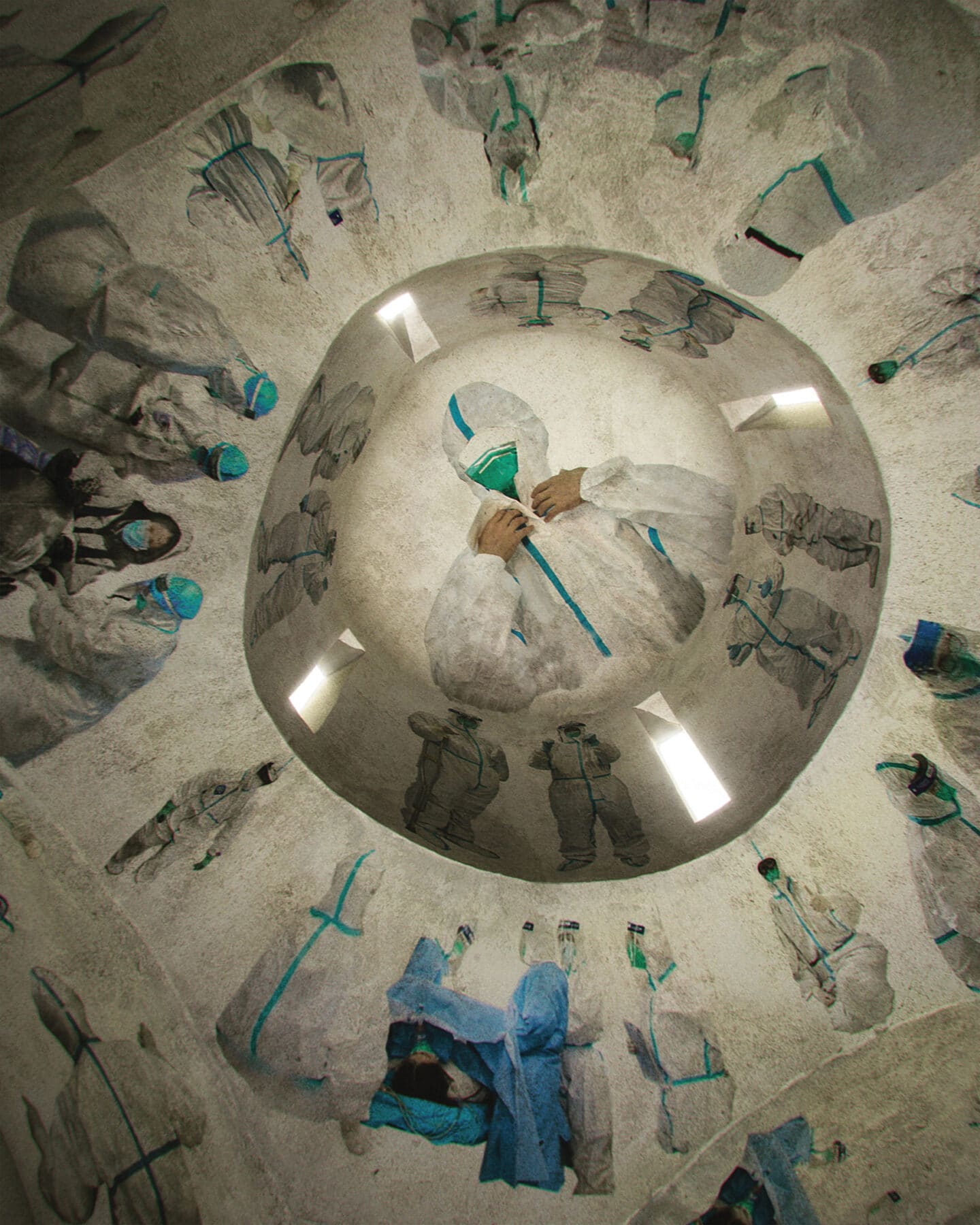
Duyi Han: The Saints Wear White
An outpouring of creative responses have given voice to suffering, loss, and trauma caused by the pandemic. For Duyi Han, the creative director of Doesn’t Come Out, a design studio in New York and Los Angeles, the response was personal. View Gallery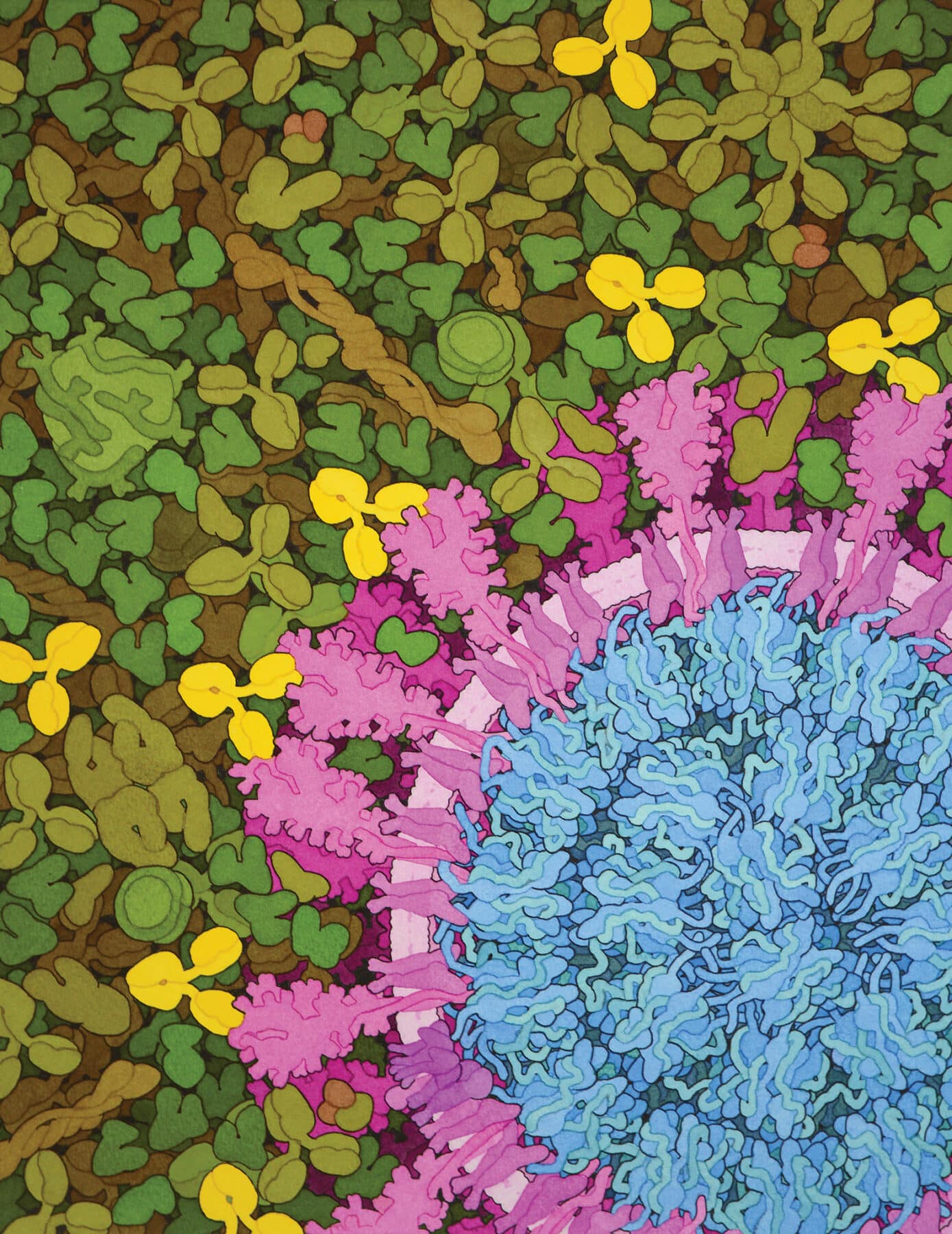
Cross Section of SARS-CoV-2 Virus
DAVID S. GOODSELL, Molecular Landscape: SARS-CoV-2 and Neutralizing Antibodies, 2020, watercolor, 13 x 10 inches, collection of the National Academy of Sciences. In this watercolor painting, a cross section of the SARS-CoV-2 virus that causes the COVID-19 disease is surrounded by blood plasma, with neutralizing antibodies depicted in bright yellow. View Gallery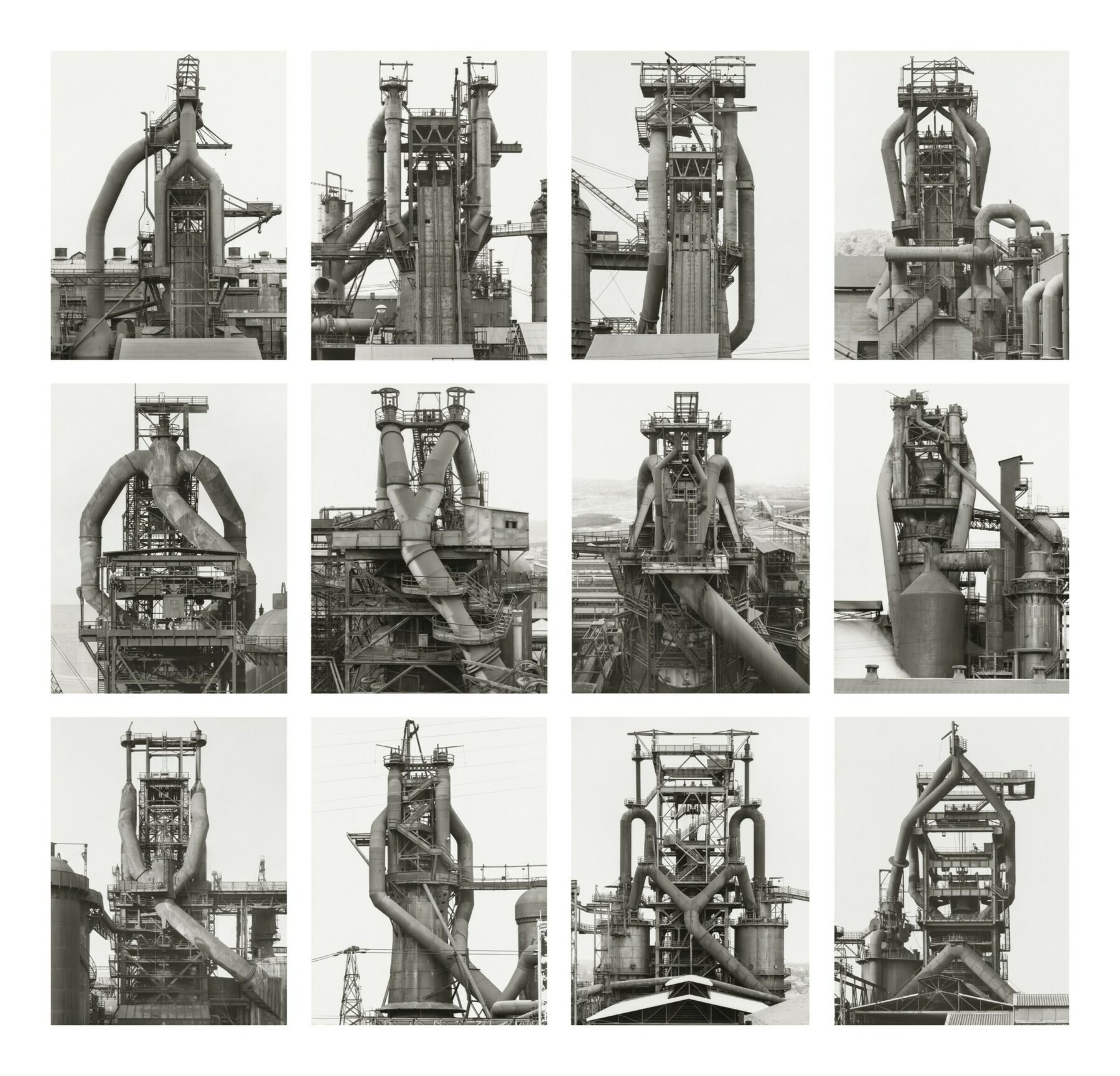
Natural Historians of the Industrial Landscape
Hilla and Bernd Becher were a collaborative duo of German conceptual art photographers who profoundly changed the way artists saw the post-World War II landscape. For more than 40 years, they studied the postindustrial architecture of Western Europe, later moving on to that of the United States’ Rust Belt. View GalleryFall 2020: What Is To Be Done?
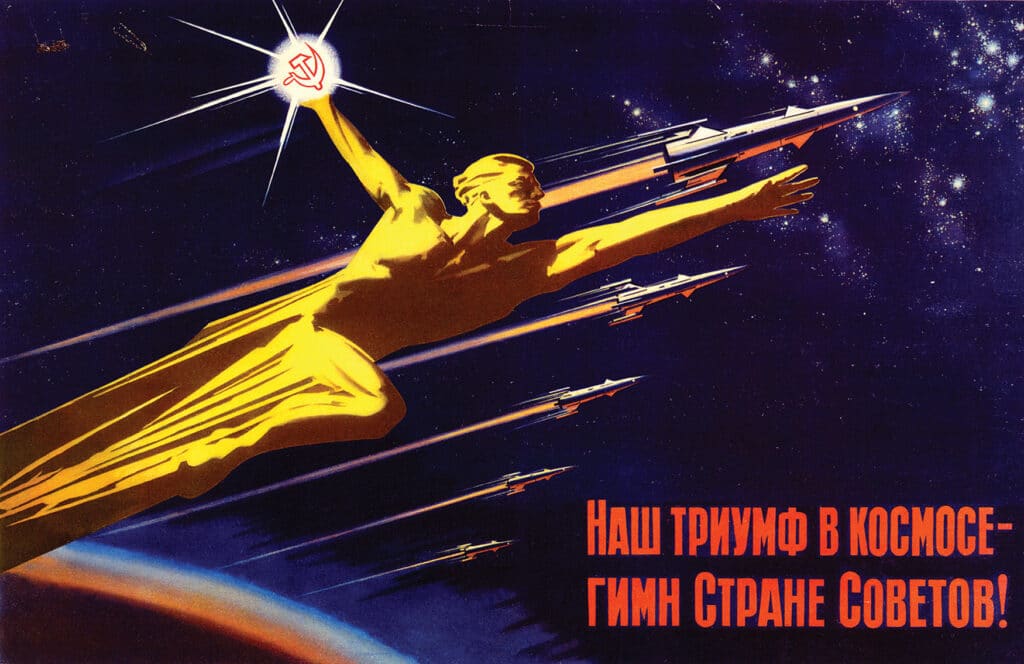
Visions of the Space Frontier
Chinese citizens cheer for a Soviet rocket in a poster from 1957, reflecting the friendly relationship that would come to an end only a few years later. A Prometheus-like figure reaches for the cosmos in a Soviet poster with one hand while holding a hammer and a sickle in the other. View Gallery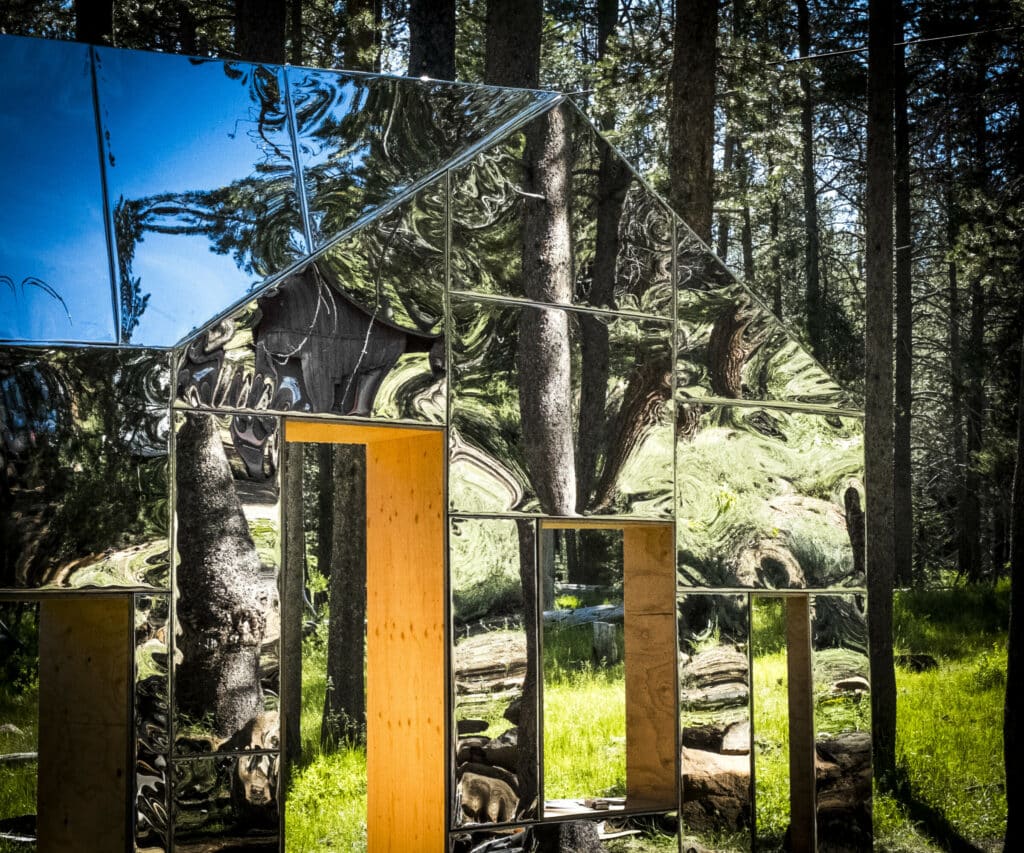
ArtSciConverge at Sagehen Creek Field Station
STPMJ Architects, “Invisible Barn,” photographed by Faerthen Felix, 2015. Artists have participated since 2011 in the ArtSciConverge residency program at the University of California, Berkeley’s Sagehen Creek Field Station in the Sierra Nevada Mountains near Truckee, California. View Gallery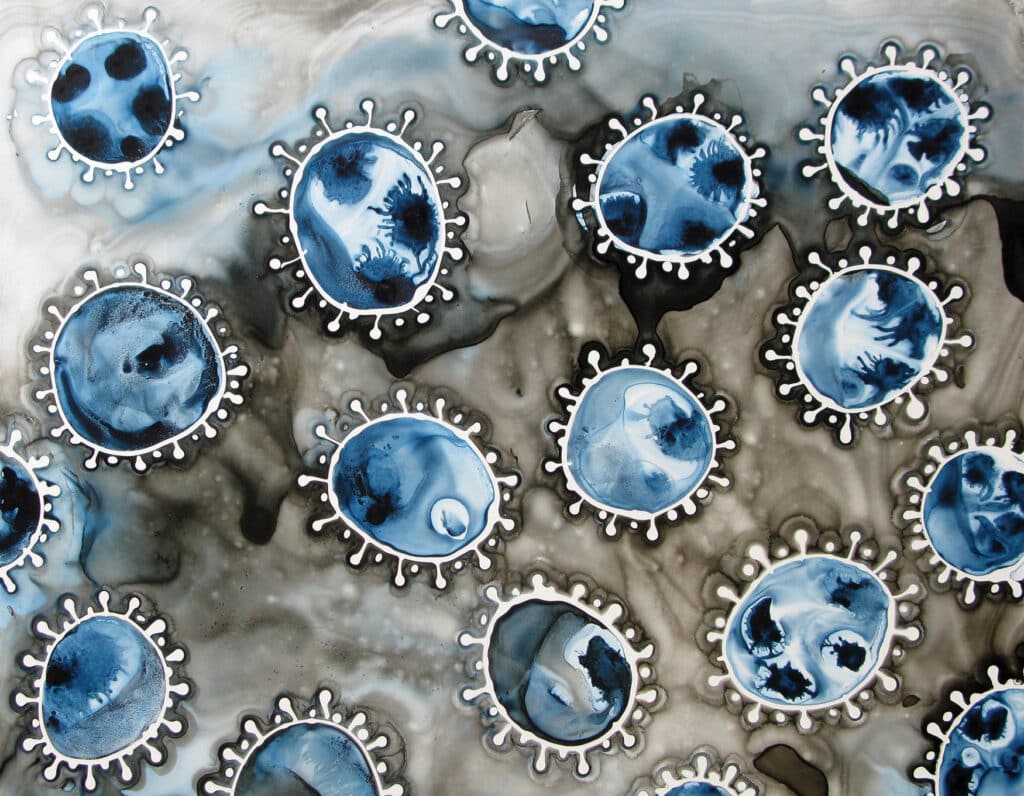
Artologica
Michele Banks, Indigo Coronavirus, 2020, ink on Yupo paper, 12 x 16 inches. Paintings inspired by COVID-19 Michele Banks is a Washington, DC-based artist who finds inspiration in how viruses and bacteria affect humans, and how in turn humans affect them, through climate change, antibiotic use, and other impacts on the earth. View Gallery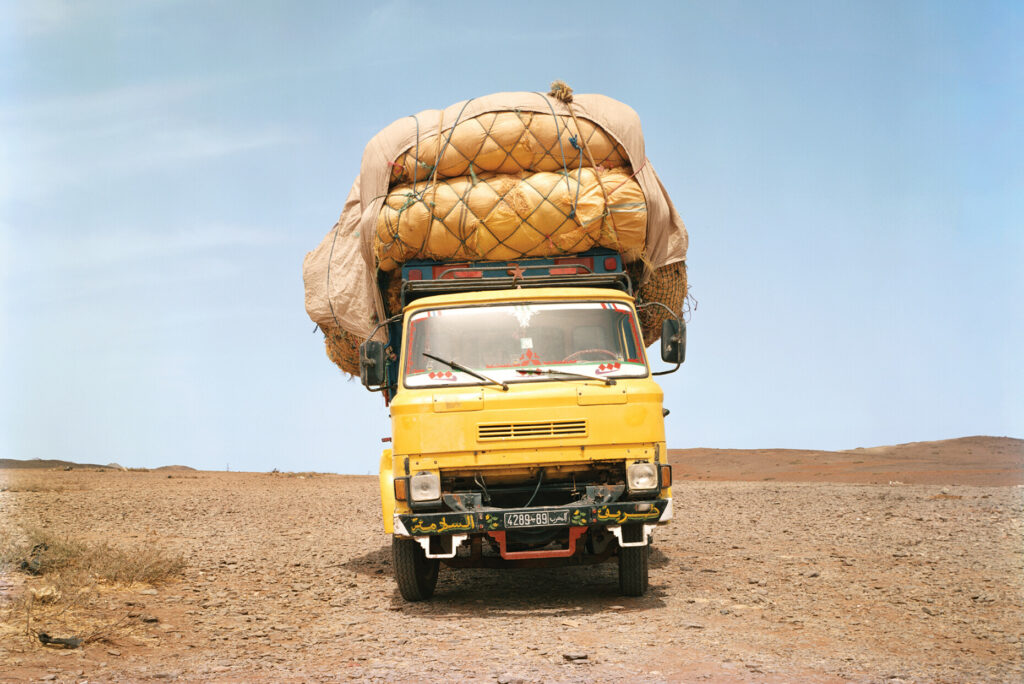
Trucks of Morocco
Stefan Ruiz, Truck No. 8, Morocco, 2001. Almost 20 years ago while on an assignment in Morocco, photographer Stefan Ruiz came across a series of trucks and was captivated by their appearance. View GallerySummer 2020: Who Benefits From Science?
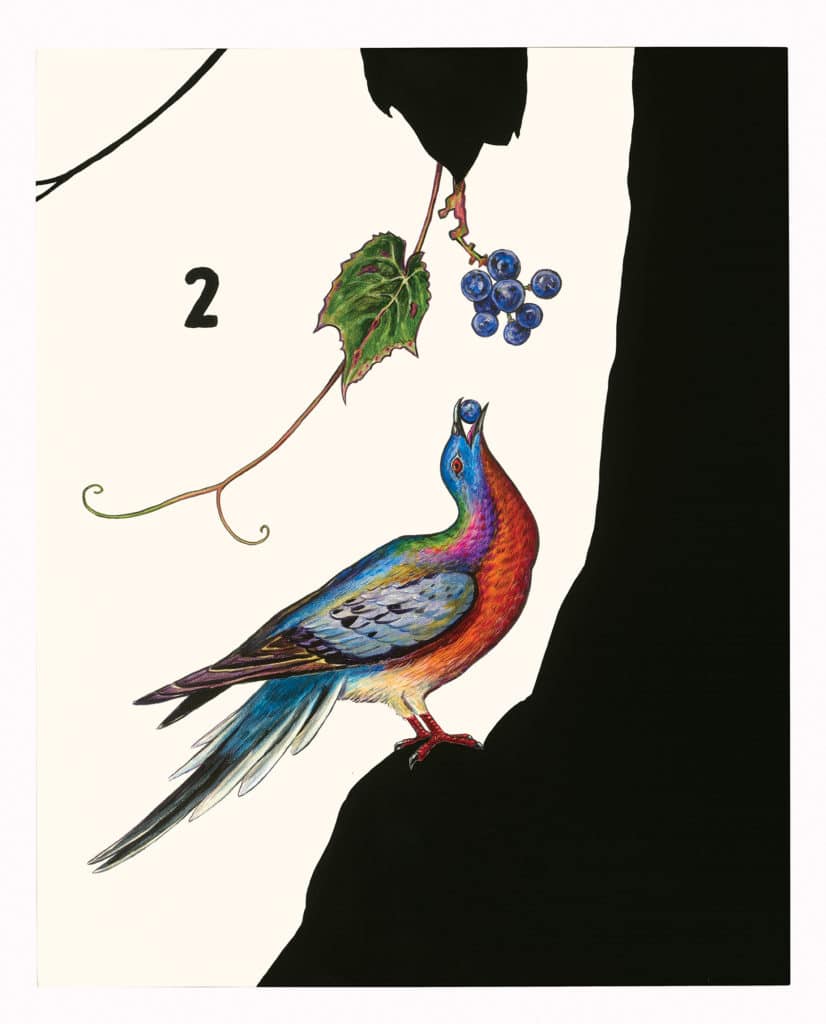
Naming Nature
James Prosek, “What Once Was Is No Longer (1851)” (2019) As an undergraduate at Yale University in the 1990s, I read the seventeenth-century English poet John Milton’s Paradise Lost for the first time. View Gallery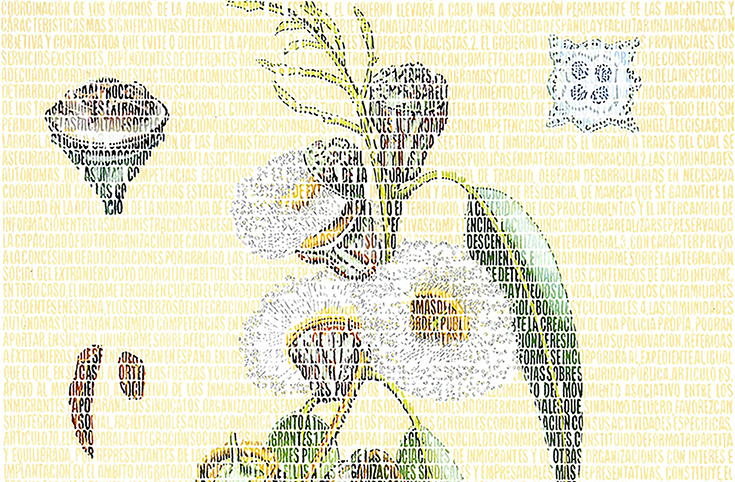
Around Nature
Juanli Carrión, OSSVLC (Outer Seed Shadow: Valencia) (2016–17). Five hundred years ago, the Spanish government and private investors funded a commercial trip led by Ferdinand Magellan and Juan Sebastián Elcano that would become the first journey around the world. View Gallery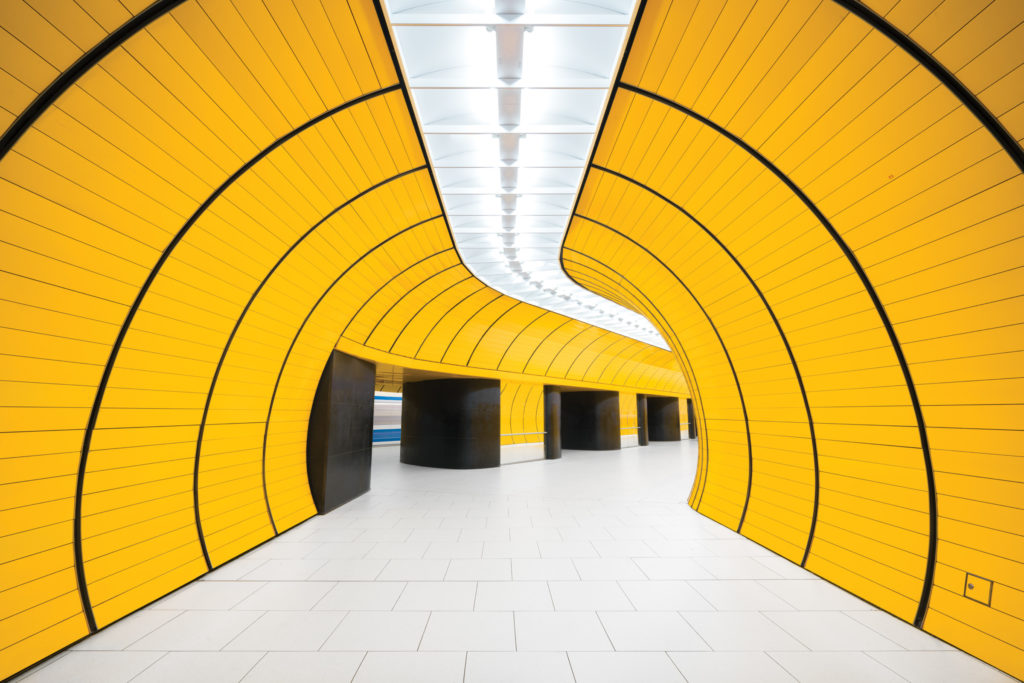
The Metro Project
Underground public transit systems play a pivotal role in the day-to-day functioning of cities around the world. They also contribute to a city’s unique visual identity. Captivated by the overlooked beauty of his hometown transit system, Chris M. View GallerySpring 2020: Slowing Science Down
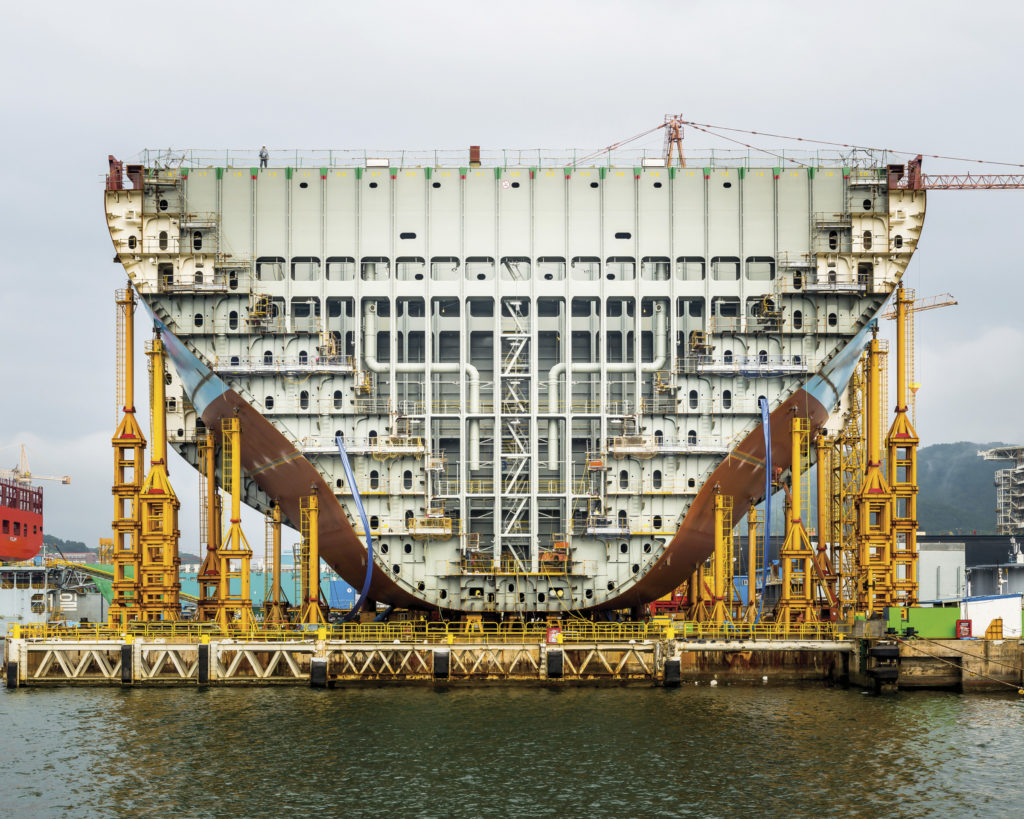
Unintended Beauty
The human mind is capable of extraordinary things. We create systems, structures and machines that allow us to provide for our lives and answer our questions about the universe. Machines tell the story of our needs and desires, our hopes and follies, our visions for the future. View Gallery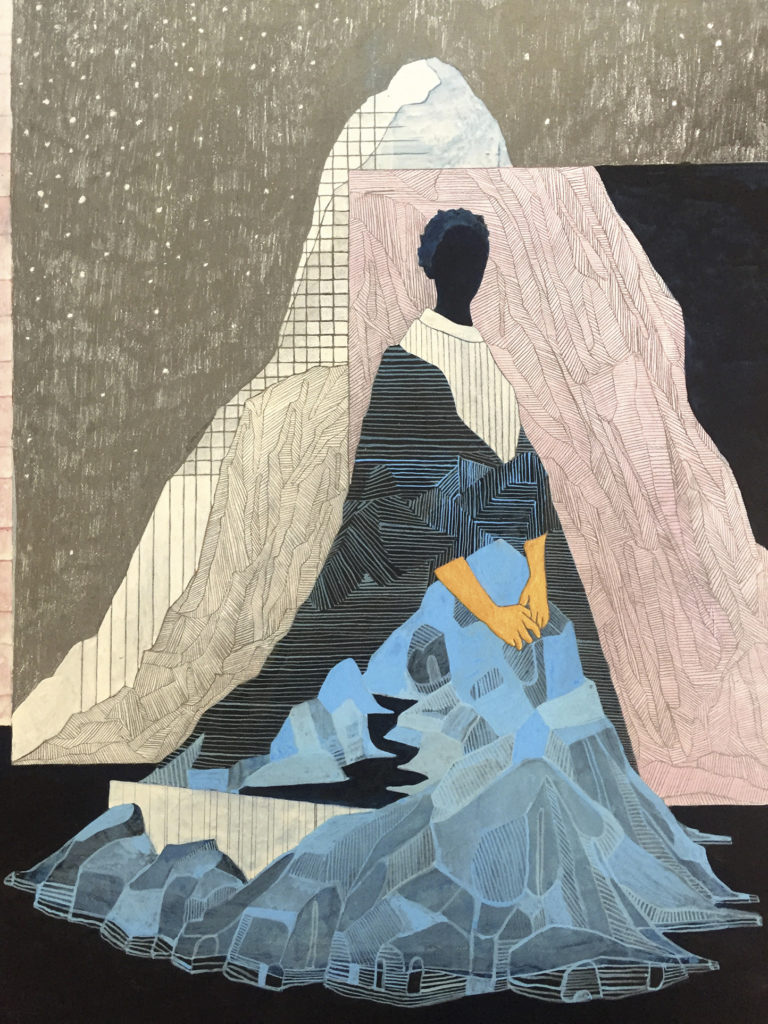
Time, Place, & Identity
Born in Mochudi, Botswana, the artist Pamela Phatsimo Sunstrum merges ideas of ancient mythologies with scientific theories in her work. Sunstrum is interested in topics such as the origins of time, geological concepts, and ideas about the universe. View Gallery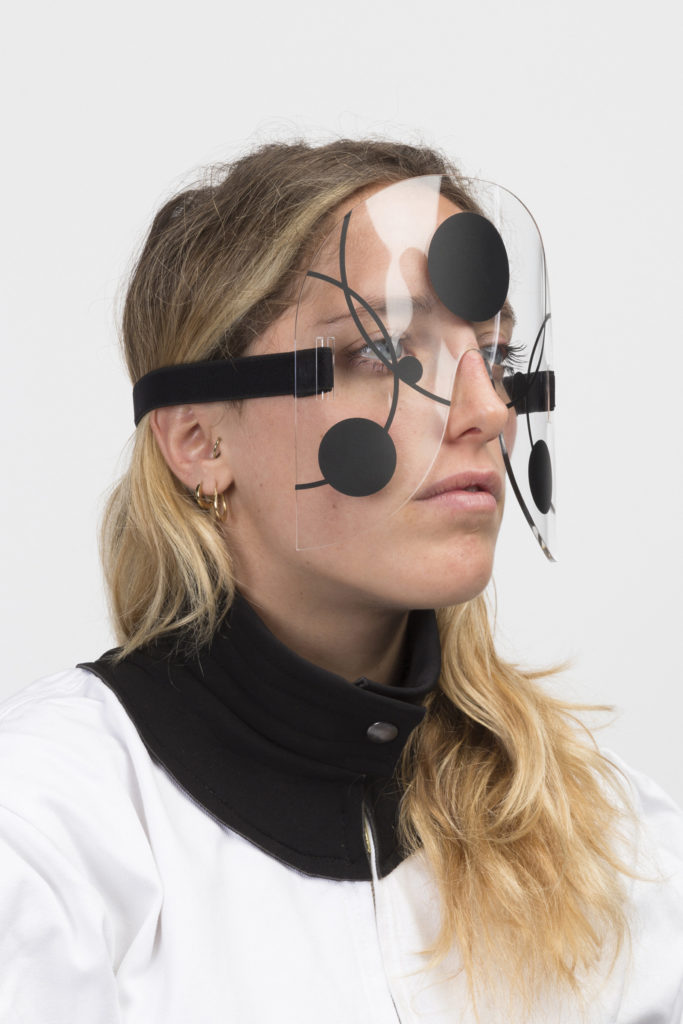
Designs for Different Futures
For much of the modern era, the desire to envision and potentially shape the future has been informed by ideals that are progressive or even utopian in spirit. Artists and designers are often inspired by the belief that the future can be not only substantially different but also better, morally as well as technologically. View GalleryWinter 2020: Science, the Endless Frontier at 75
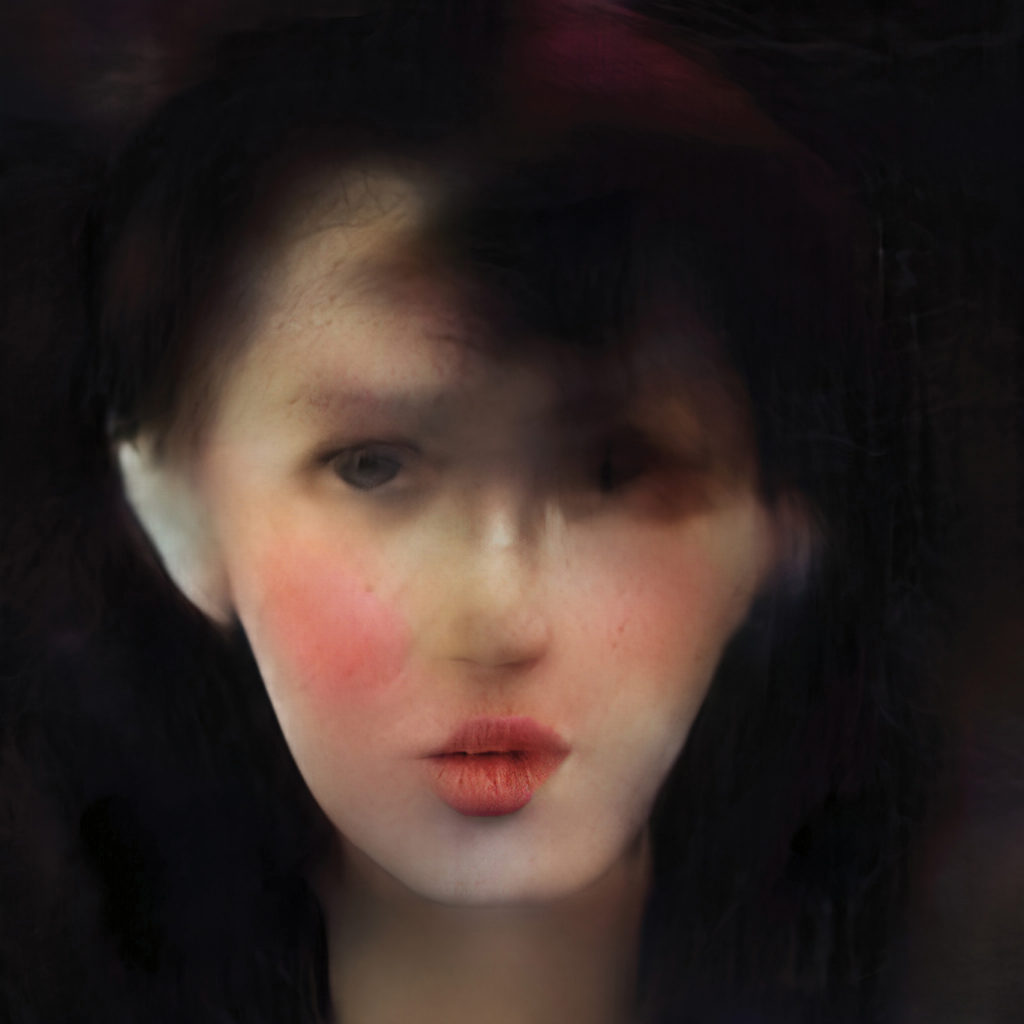
Neural Glitch
Mario Klingemann, 2018 Mario Klingemann describes himself as “an artist and a skeptic with a curious mind.” His work spans and incorporates a wide range of tools and technologies, including neural networks and deep learning, computer code and algorithms, and artificial intelligence and generative art (work produced by autonomous or semi-autonomous systems). View Gallery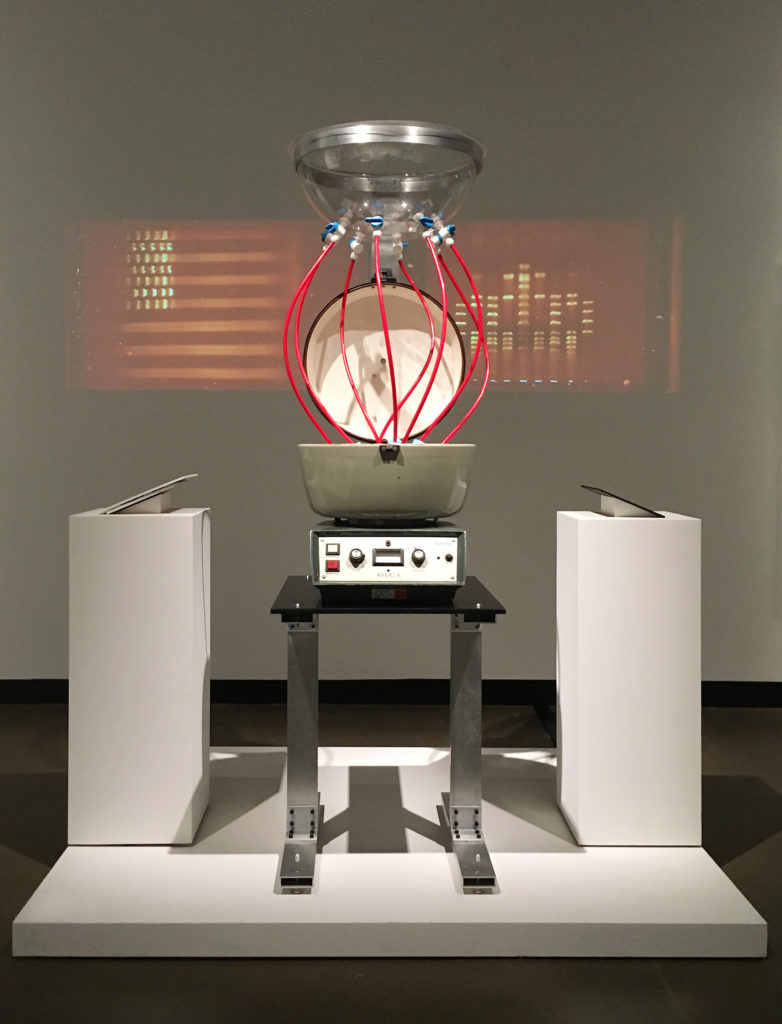
Shaping Our Genetic Futures
Paul Vanouse, America Project, 2016, spittoon and video projection. Photo by Molly Renda, courtesy of the artist. “There is a strange pleasure in the performance of DNA extraction, live in an art museum. View Gallery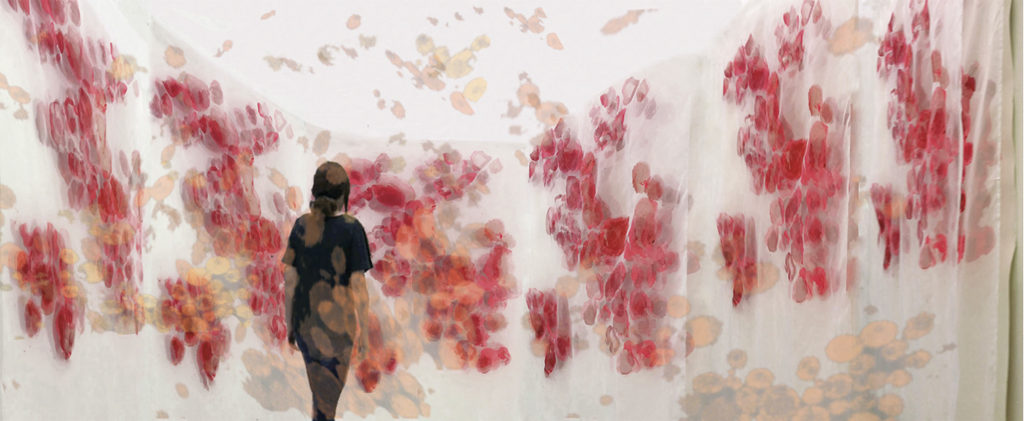
Nano Portraiture
Artist and chemist Michal Gavish wants viewers to consider the complexity and fragility of humans’ inner biology. In her 3-D drawing and painting installations, she magnifies imagery of DNA and protein structures to a human scale. View GalleryFall 2019: The 35th Anniversary Issue

Fragmentation
Seth Clark’s collages and sculpture focus on deteriorating architecture. Usually designed for permanence, buildings are constantly being challenged by geological, meteorological, and other external forces. Clark enjoys studying the way they fall apart and the way we struggle to keep them up to date. View Gallery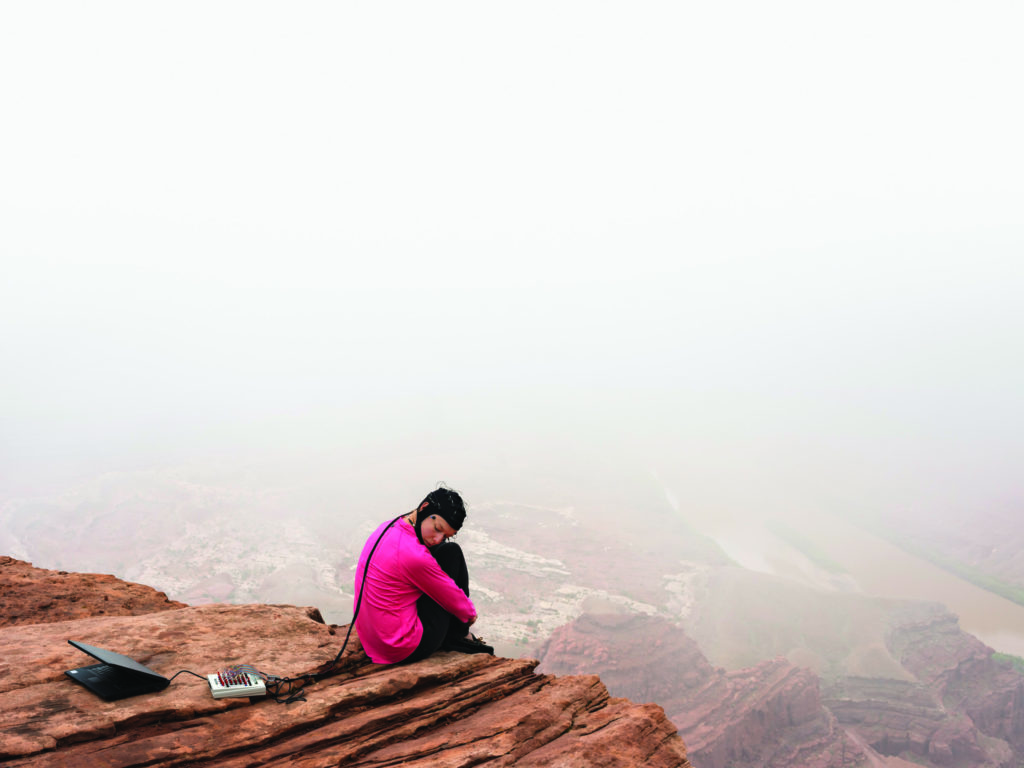
On Earth: Imaging, Technology, and the Natural World
Since its inception, photography has testified to the complex relationship between humans, nature, and technology. In the wake of great nineteenth-century landscape photographers, a new generation of artists are employing contemporary imaging techniques to observe the natural world and the effects of human existence on it. View Gallery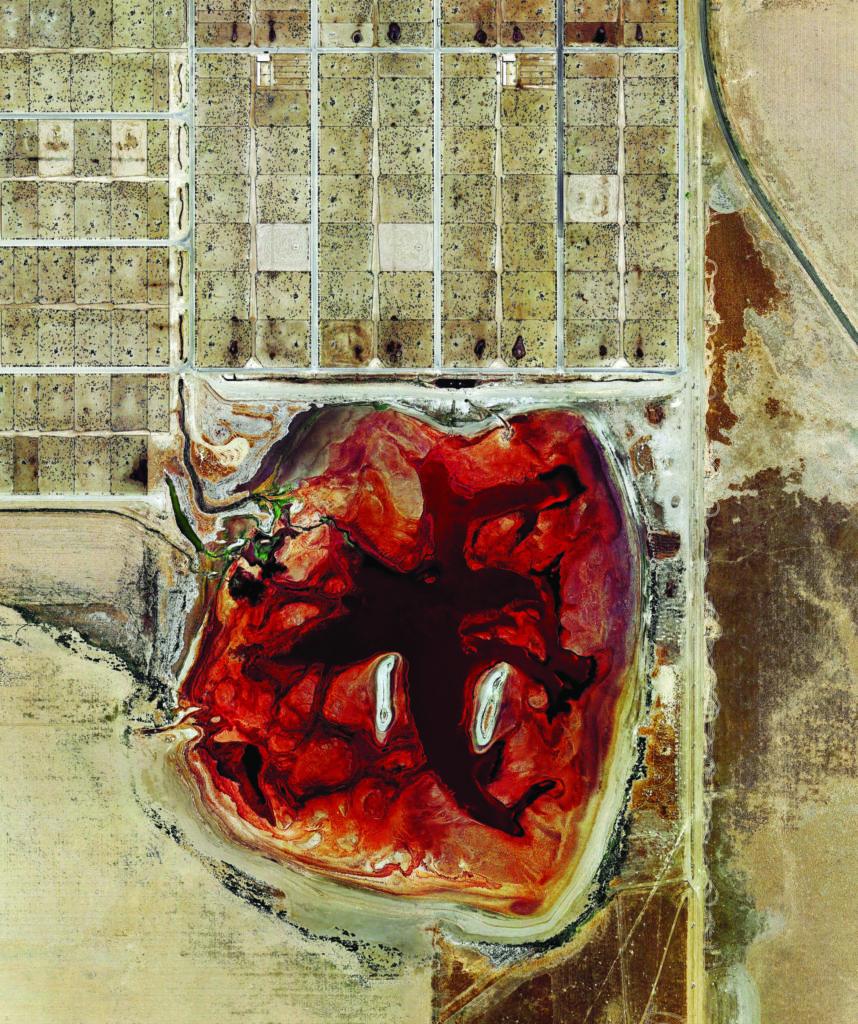
Feedlots
Mishka Henner is a Belgian artist who lives and works in Manchester, England. He is known for prints and videos that appropriate image-rich technologies, including Google Earth, Google Street View, and YouTube. He described his inspiration and process for creating the Feedlots series for the Los Angeles Times: I first came across these feedlots on Google Earth and had no idea what I was seeing. View GallerySummer 2019: The Empty Radicalism of the Climate Apocalypse
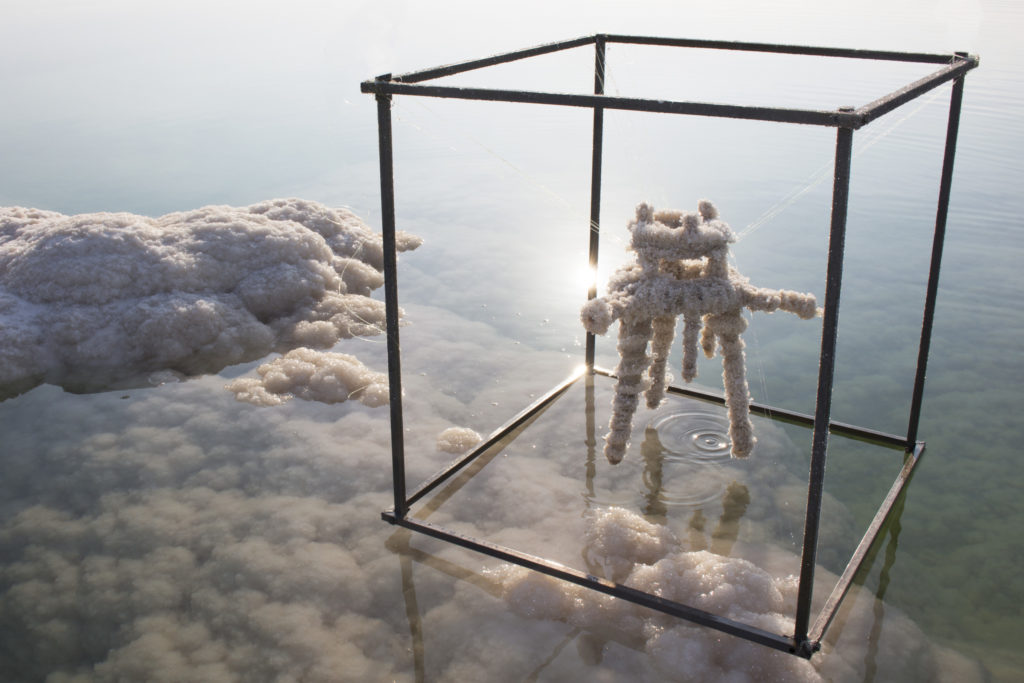
Nature—Cooper Hewitt Design Triennial
Nature—Cooper Hewitt Design Triennial, coorganized by Cooper Hewitt, the Smithsonian Design Museum, and Cube design museum in Kerkrade, Netherlands, features over 60 projects to demonstrate how designers are collaborating with scientists, engineers, environmentalists, academics, and other stakeholders to find inventive and promising solutions to the environmental and social challenges confronting humanity today. View Gallery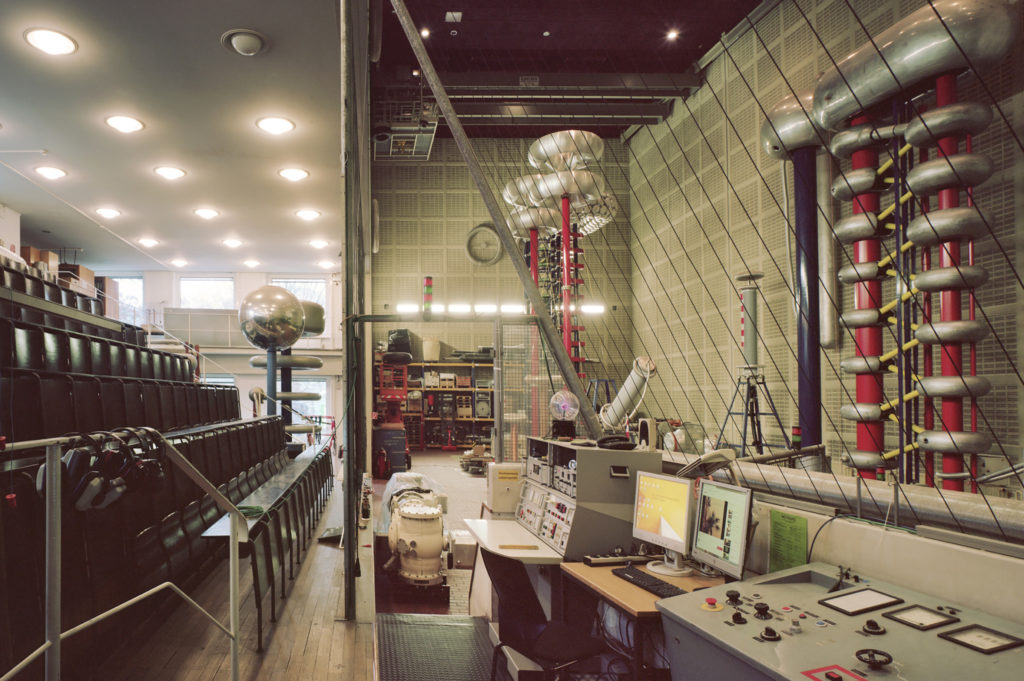
Studio + Laboratory: Workshops of Knowledge
Be it artistic works or scientific discoveries, the end results are generally all that remain visible of the creative process. What happens behind closed doors in the laboratory or studio tends to be as invisible as it is mysterious. View Gallery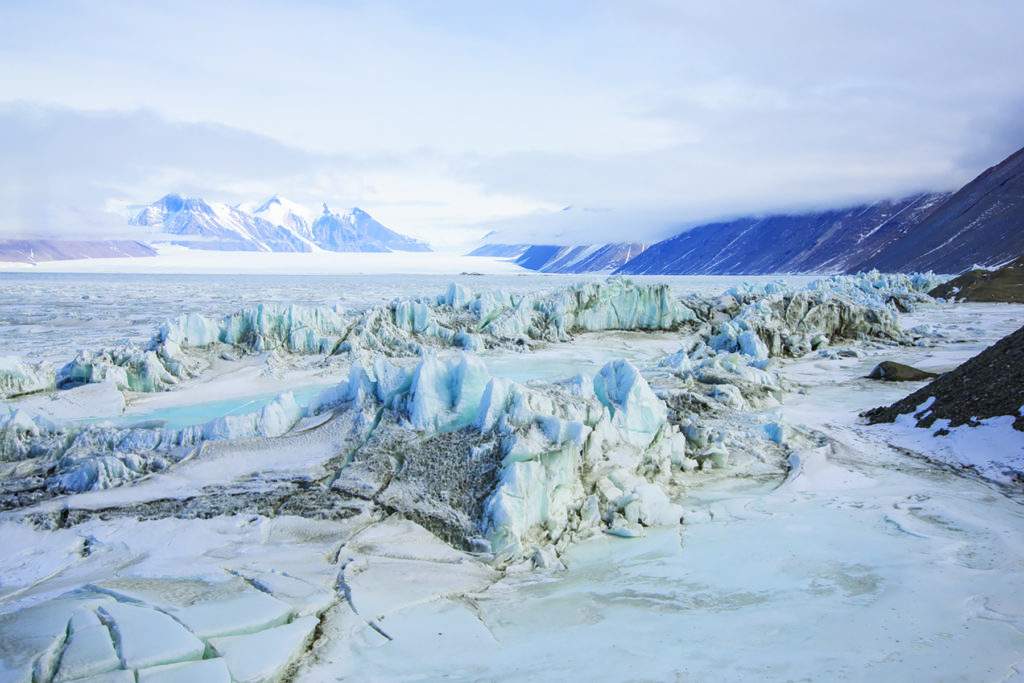
Walking in Antarctica
Walking in Antarctica is inspired by Helen Glazer’s experience as a 2015 grantee of the National Science Foundation Antarctic Artists and Writers Program. Since returning from her trip, she has been working with a rich cache of raw material, creating the photographic prints, sculpture, and an accompanying narrative that comprise the project. View GallerySpring 2019: Human Gene Editing

From Lucid Stead
The exhibition From Lucid Stead: Prints and Works by Phillip K. Smith III is on view at the National Academy of Sciences in Washington, DC, from March 18 through September 13, 2019. View Gallery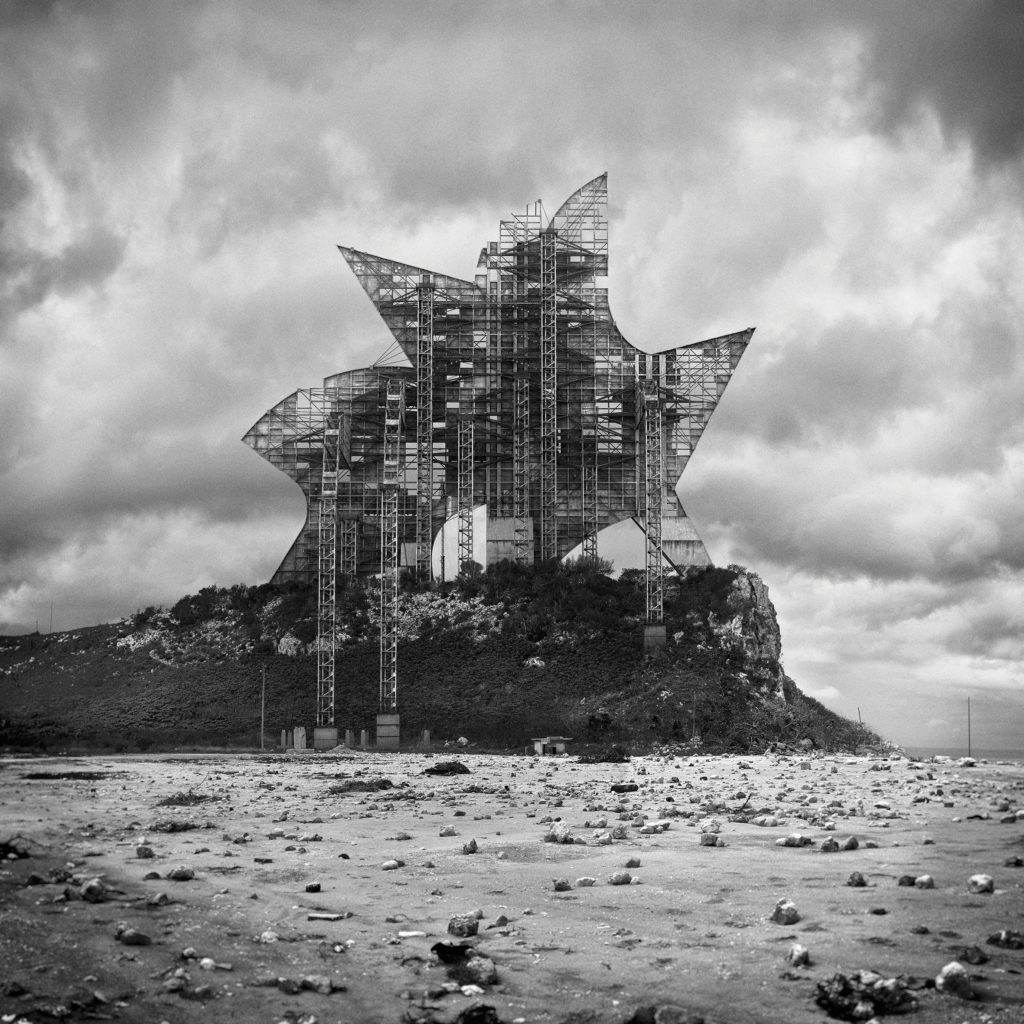
Pending Memories
The latest series of photographs by Cuban artist Adrian Fernandez portray the backside of billboards situated in surreal landscapes. The complex structures and unexpected shapes are suggestive of Russian constructivism, but the more interesting question is what is on the other side. View GalleryWinter 2019: Higher Education Re-Imagined
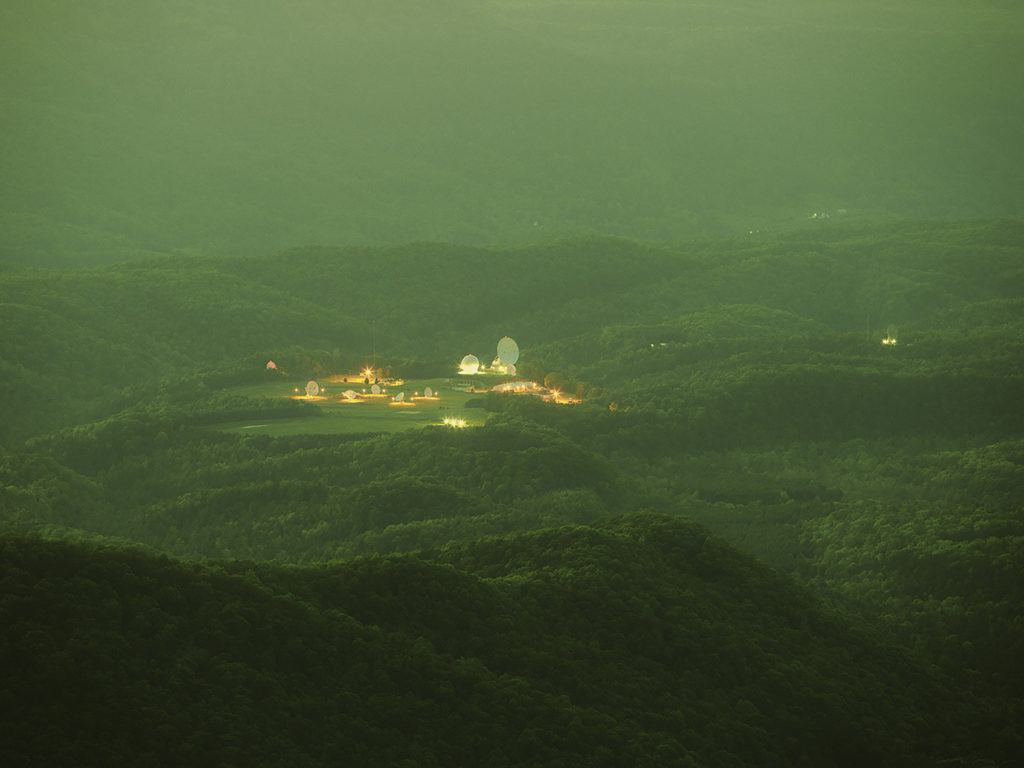
Sites Unseen & Orbital Reflector
Trevor Paglen is an artist and writer whose work spans image-making, sculpture, investigative journalism, and engineering. With a PhD in geography from the University of California, Berkeley, Paglen blurs disciplinary boundaries in unfamiliar and at times unsettling ways. View GalleryFall 2018: The Future of Work
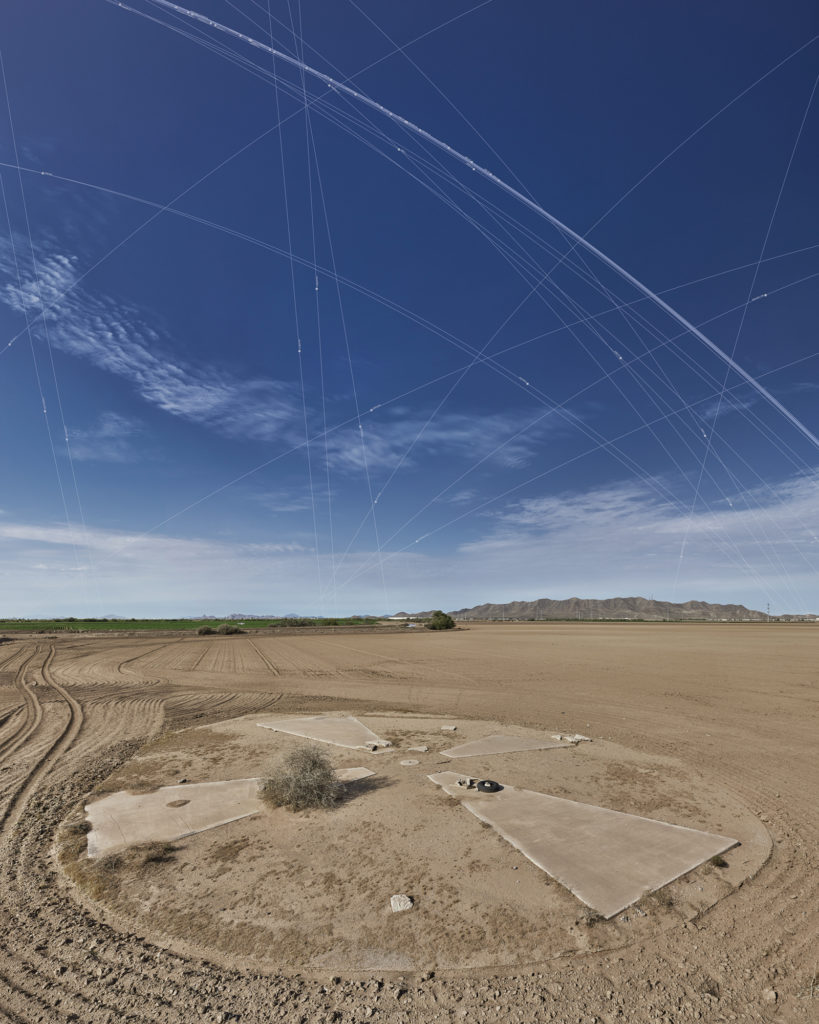
Ground Truth: Corona Landmarks
In this series of images of what remains of the Corona project, Julie Anand and Damon Sauer investigate our relationship to the vast networks of information that encircle the globe. The Corona project was a CIA and US Air Force surveillance initiative that began in 1959 and ended in 1972. View Gallery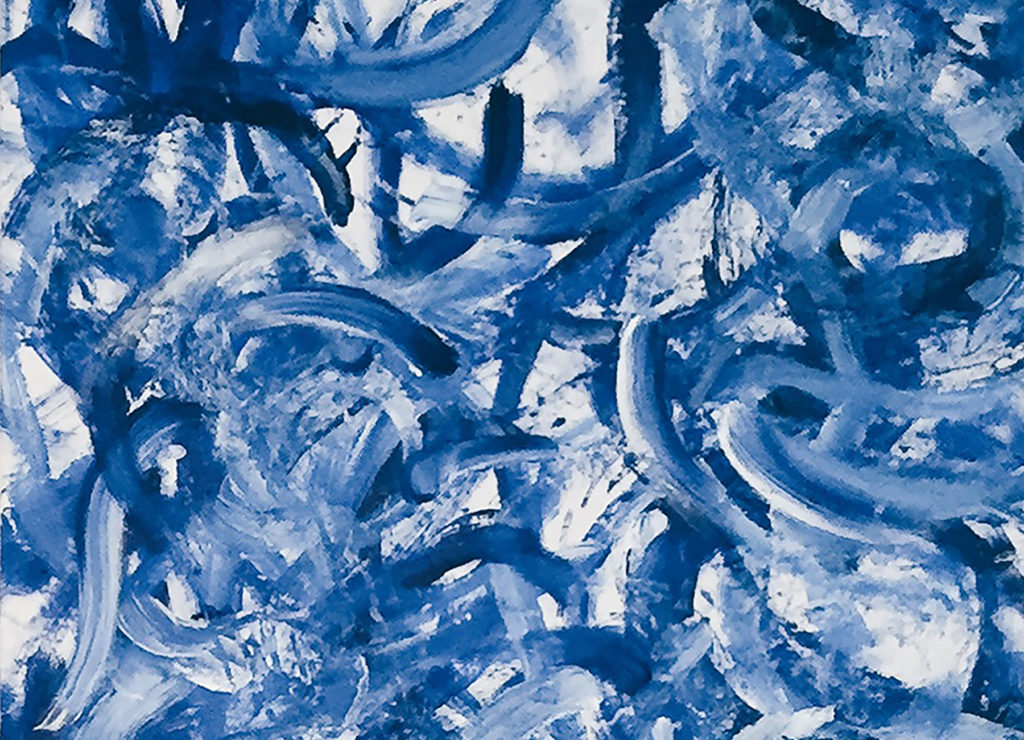
Sougwen Chung
Multimedia artist Sougwen Chung has been collaborating with robots since 2015, exploring the connections between handmade and machine-made designs as a way to understand the relationship between humans and computers. Her multifaceted artistic practice also includes filmmaking, painting, sculpture, installation, and performance. View Gallery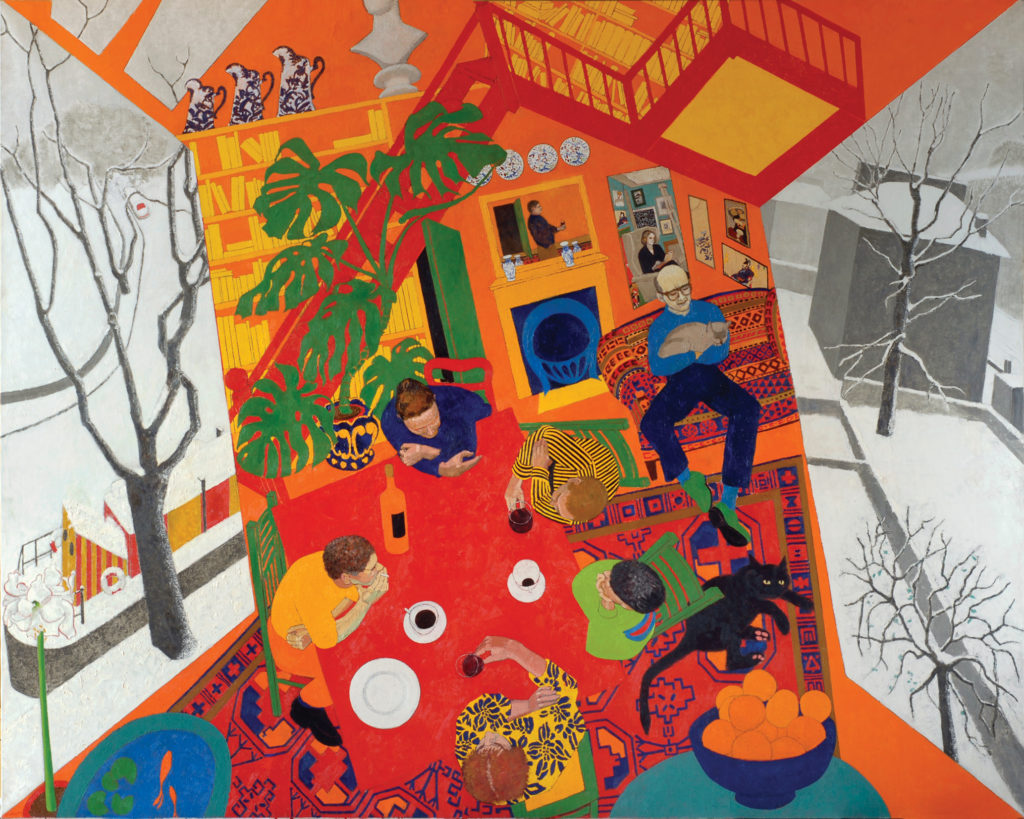
William Utermohlen
William Utermohlen was born in south Philadelphia in 1933. He studied art at the Pennsylvania Academy of Fine Arts from 1951 to 1957 and on the G.I. bill at the Ruskin School of Art in Oxford, England, from 1957 to 1958. View GallerySpring 2017: Climate Engineering
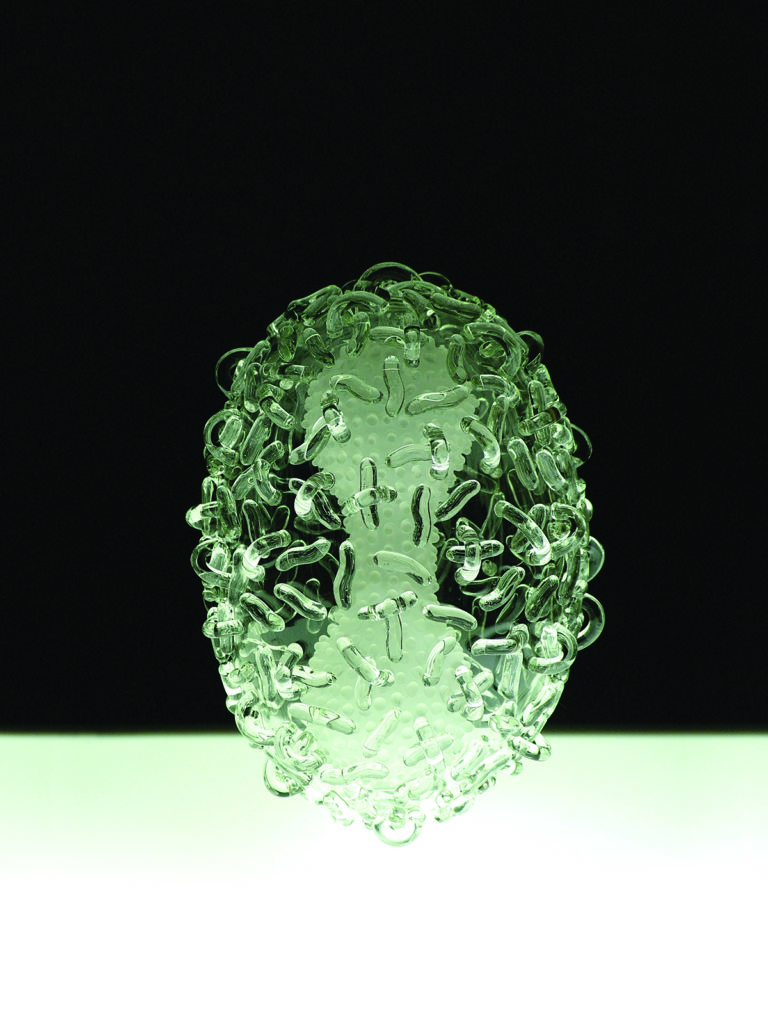
Glass Microbiology
Luke Jerram’s multidisciplinary arts practice involves the creation of sculptures, installations, and live artworks. He lives in the United Kingdom and creates work across the globe. Glass Microbiology is a collection of glass models of human viruses. View GalleryWinter 2017: The Energy Transition
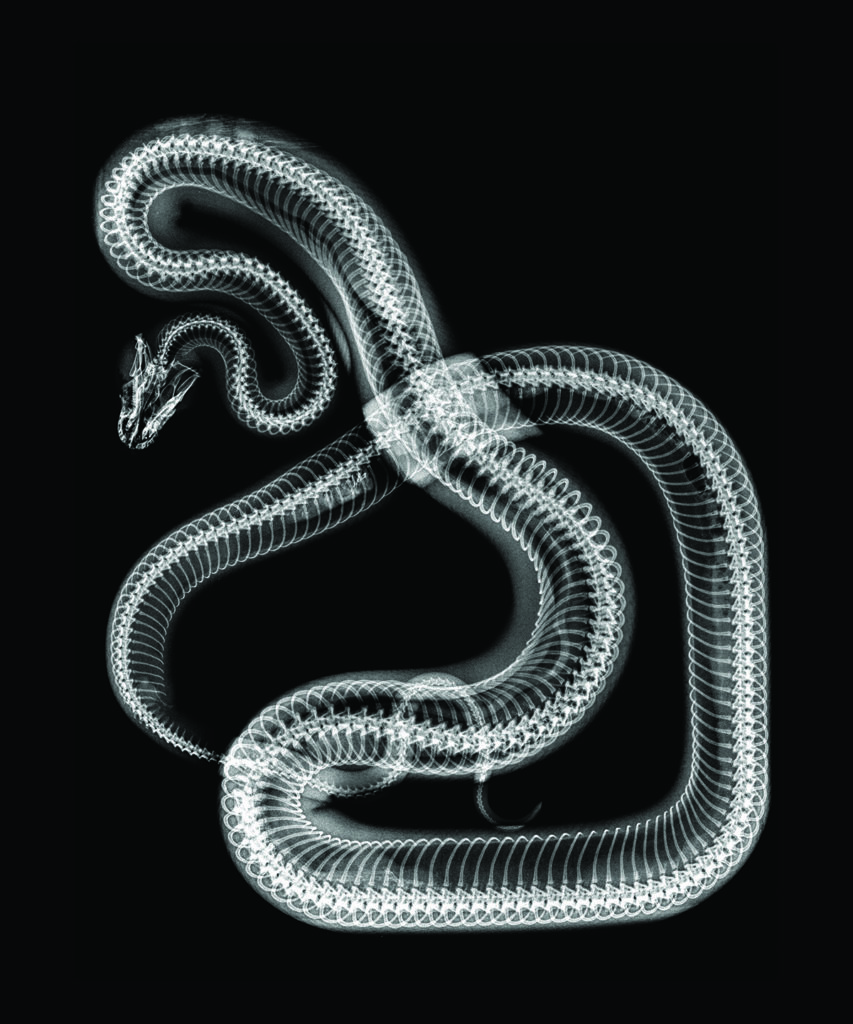
Fashion, Animal, Sound
The images in Steve Miller’s Fashion, Animal, Sound series are all X-rays. He began experimenting with the technology decades ago because it enabled him to re-invent the notion of a portrait by looking beyond the surface and beneath the flesh, and he later extended it to other life forms and inanimate objects. View GalleryFall 2016: The Criminalization of Immigration
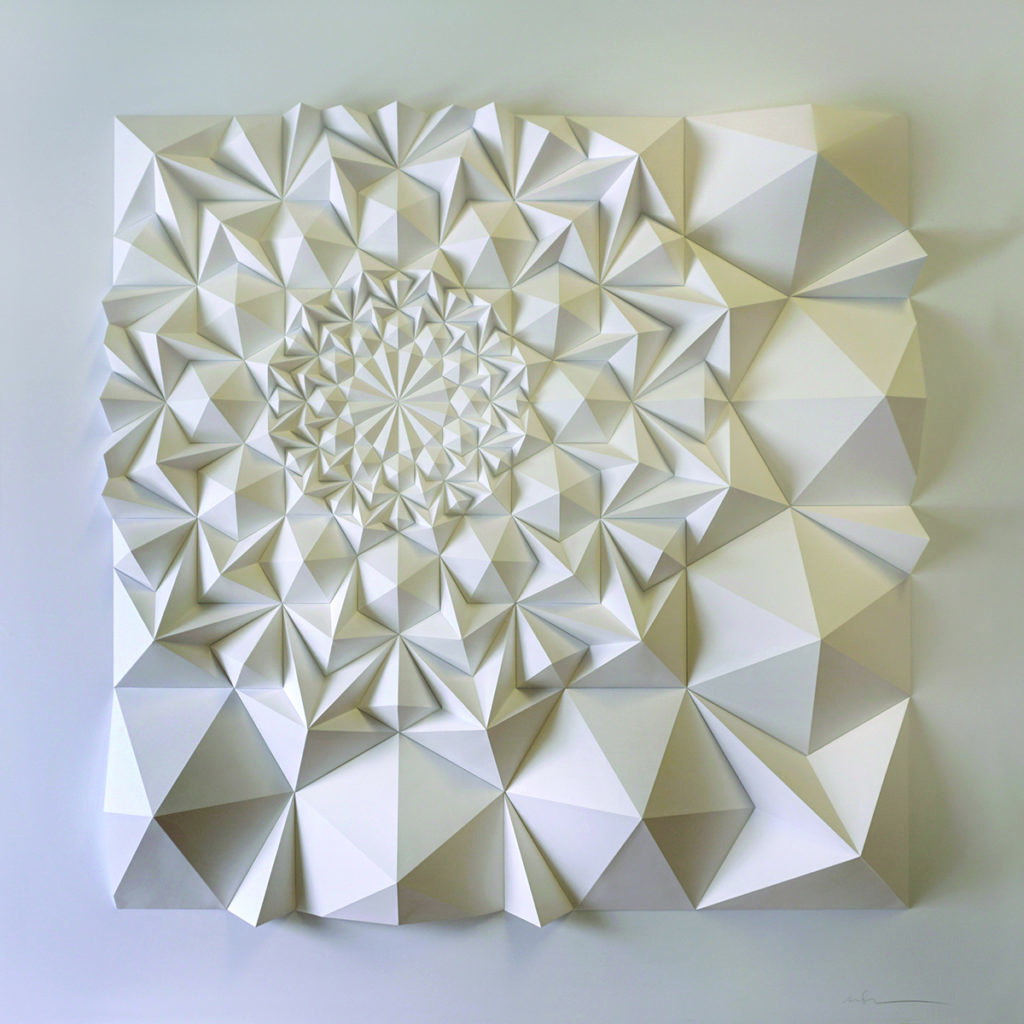
Chirality
Matthew Shlian is an artist and designer working in paper. He uses the traditions of origami, kirigami, and paper engineering to transform flat materials into 3D sculptures and he applies his experience in collaborative research with scientists at the University of Michigan, Ann Arbor. View GallerySummer 2016: A New Global Environment for Space Policy
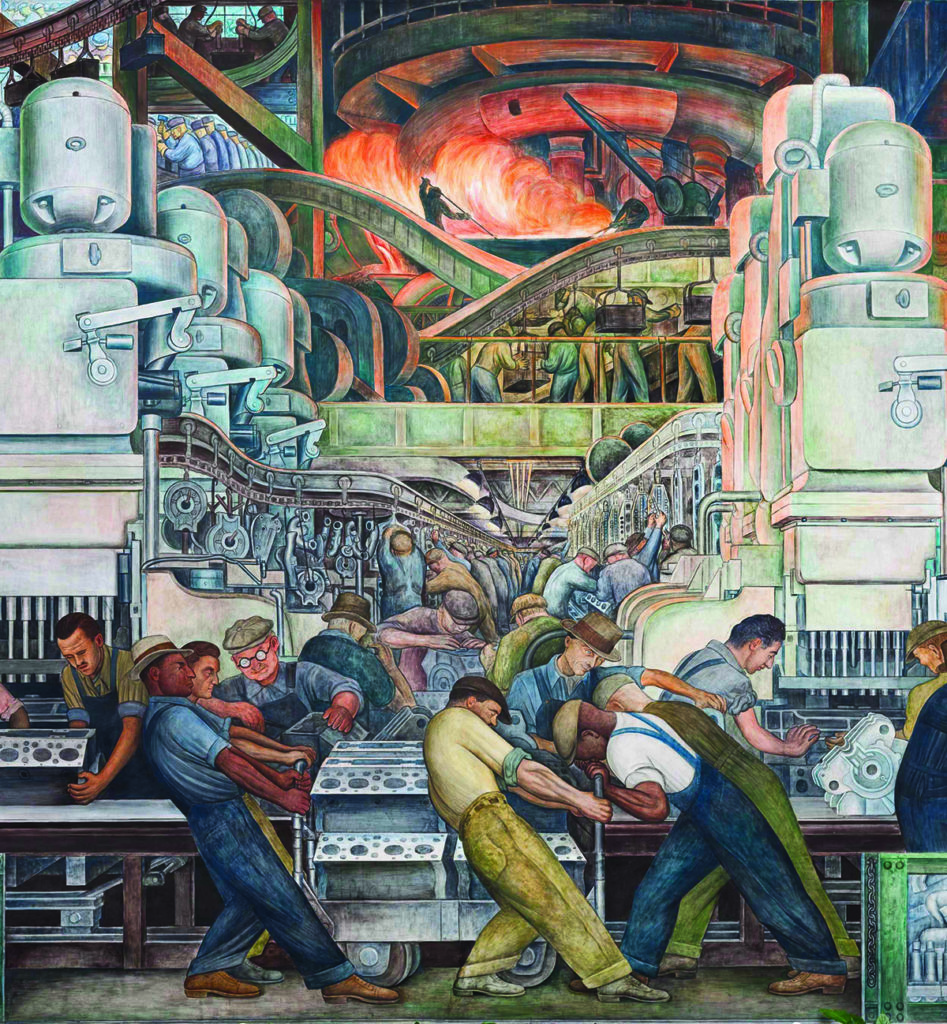
Detroit Industry Murals
The Detroit Industry murals by prominent Mexican artist Diego Rivera pay tribute to Detroit’s manufacturing base and labor force. In the first half of the twentieth century, Detroit was the center of America’s most important industry—automobile manufacturing—and it was a symbol of modernity and the power of labor and capitalism. View Gallery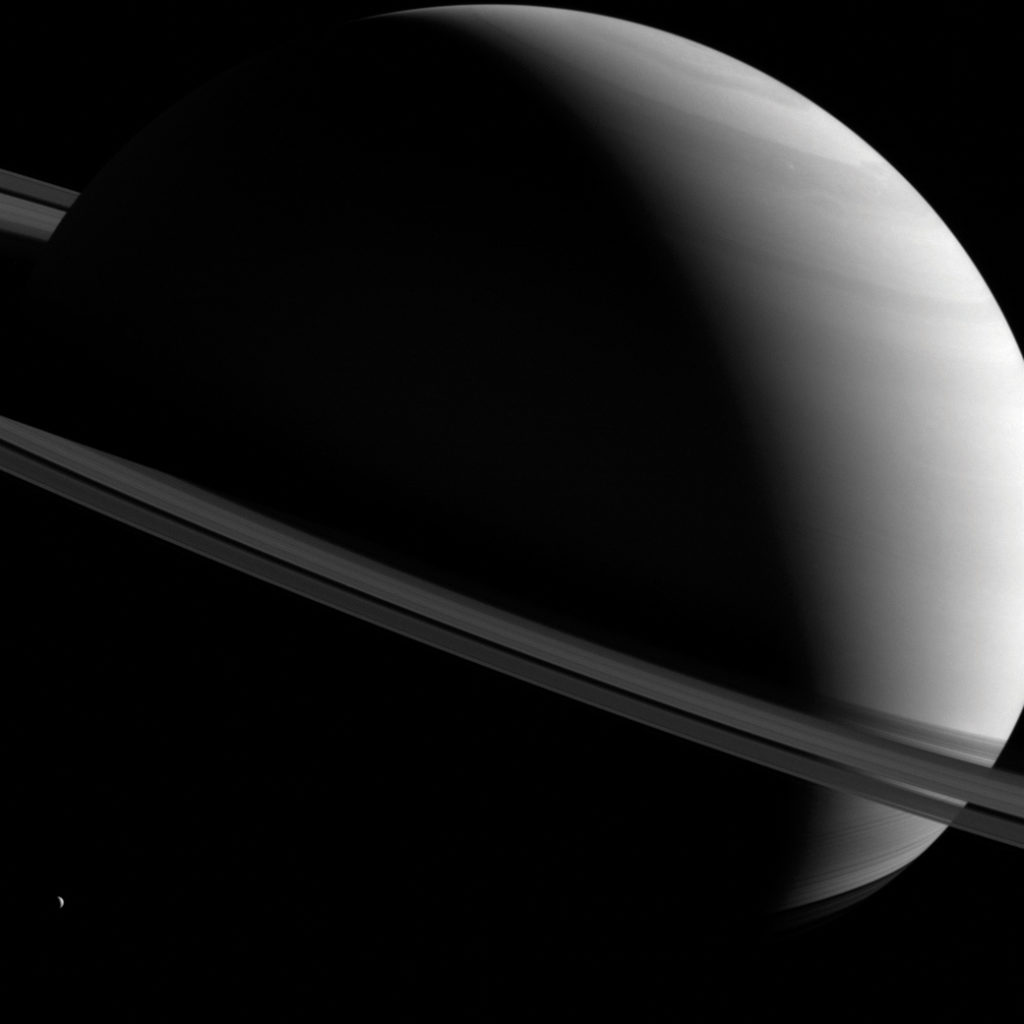
Cassini Mission to Saturn
The Cassini mission to Saturn is a joint endeavor of the US National Aeronautics and Space Administration, the European Space Agency, and the Agenzia Spaziale Italiana. Cassini is a sophisticated robotic spacecraft orbiting the ringed planet and studying the Saturnian system in detail. View GallerySpring 2016: Summit on Human Gene Editing
